Planet Technology WDAPC7200AC 1200Mbps 802.11ac Dual Band Ceiling Mount Wireless Access Point User Manual part1
Planet Technology Corporation 1200Mbps 802.11ac Dual Band Ceiling Mount Wireless Access Point part1
Contents
- 1. User manual part1
- 2. User manual part2
User manual part1
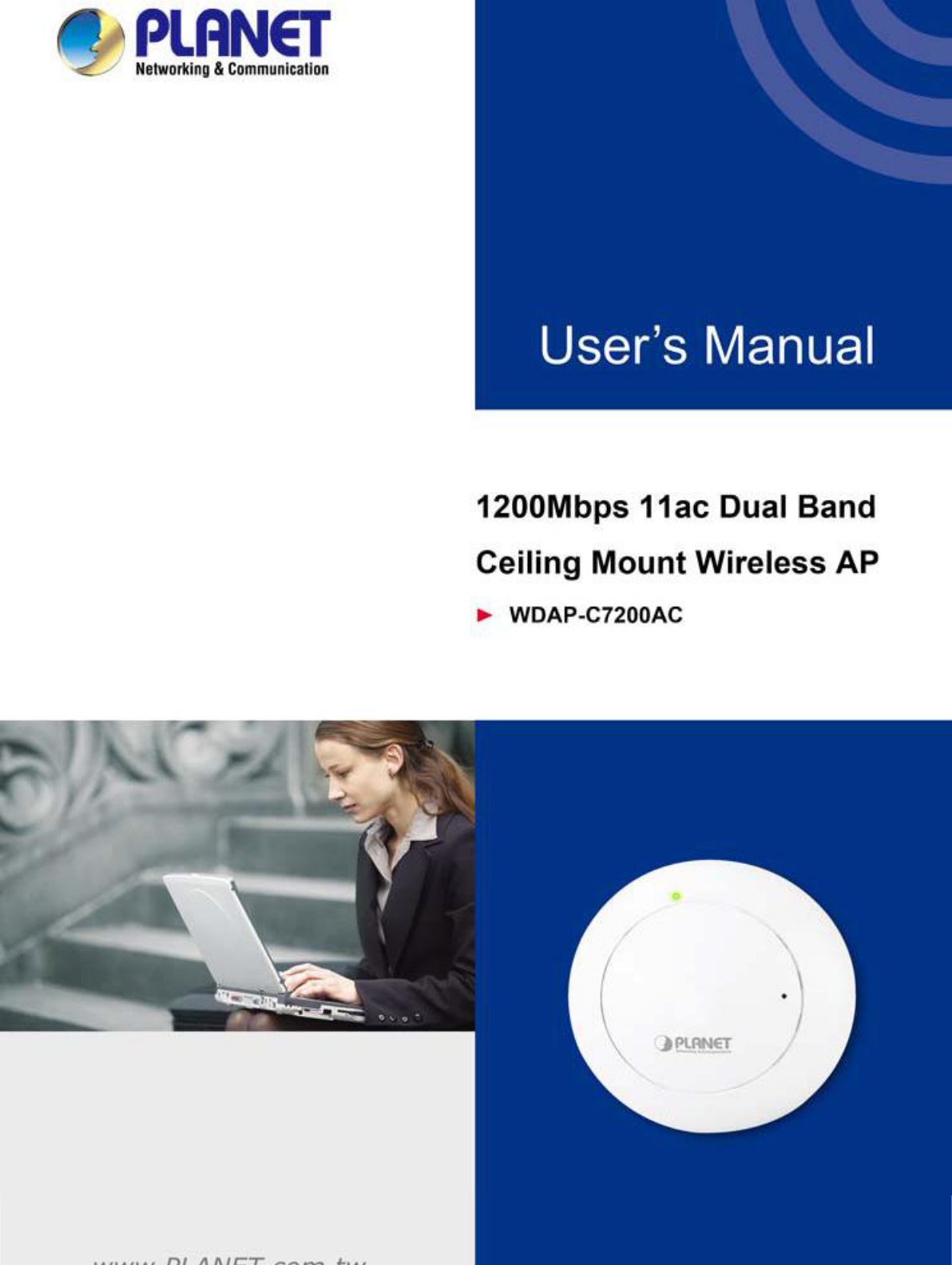

Copyright
Copyright 2014 by PLANET Technology Corp. All rights reserved. No part of this publication may be
reproduced, transmitted, transcribed, stored in a retrieval system, or translated into any language or
computer language, in any form or by any means, electronic, mechanical, magnetic, optical, chemical,
manual or otherwise, without the prior written permission of PLANET.
PLANET makes no representations or warranties, either expressed or implied, with respect to the
contents hereof and specifically disclaims any warranties, merchantability or fitness for any particular
purpose. Any software described in this manual is sold or licensed "as is". Should the programs prove
defective following their purchase, the buyer (and not PLANET, its distributor, or its dealer) assumes
the entire cost of all necessary servicing, repair, and any incidental or consequential damages resulting
from any defect in the software. Further, PLANET reserves the right to revise this publication and to
make changes from time to time in the contents hereof without obligation to notify any person of such
revision or changes.
All brand and product names mentioned in this manual are trademarks and/or registered trademarks of
their respective holders.
Federal Communication Commission Interference Statement
This equipment has been tested and found to comply with the limits for a Class B digital
device, pursuant to Part 15 of FCC Rules. These limits are designed to provide reasonable
protection against harmful interference in a residential installation. This equipment
generates, uses, and can radiate radio frequency energy and, if not installed and used in accordance
with the instructions, may cause harmful interference to radio communications. However, there is no
guarantee that interference will not occur in a particular installation. If this equipment does cause
harmful interference to radio or television reception, which can be determined by turning the equipment
off and on, the user is encouraged to try to correct the interference by one or more of the following
measures:
1. Reorient or relocate the receiving antenna.
2. Increase the separation between the equipment and receiver.
3. Connect the equipment into an outlet on a circuit different from that to which the receiver is
connected.
4. Consult the dealer or an experienced radio technician for help.
FCC Caution
To assure continued compliance, use only shielded interface cables when connecting to computer or
peripheral devices. Any changes or modifications not expressly approved by the party responsible
for compliance could void the users authority to operate the equipment.
This device complies with Part 15 of the FCC Rules. Operation is subject to the following two
conditions:
(1) This device may not cause harmful interference
(2) This Device must accept any interference received, including interference that may cause undesired
operation.
Any changes or modifications not expressly approved by the party responsible for compliance could
void the users authority to operate the equipment.
I

Federal Communication Commission (FCC) Radiation Exposure Statement
This equipment complies with FCC radiation exposure set forth for an uncontrolled environment. In
order to avoid the possibility of exceeding the FCC radio frequency exposure limits, human proximity
to the antenna shall not be less than 20 cm (8 inches) during normal operation.
R&TTE Compliance Statement
This equipment complies with all the requirements of DIRECTIVE 1999/5/CE OF THE EUROPEAN
PARLIAMENT AND THE COUNCIL OF 9 March 1999 on radio equipment and telecommunication
terminal Equipment and the mutual recognition of their conformity (R&TTE). The R&TTE Directive
repeals and replaces in the directive 98/13/EEC (Telecommunications Terminal Equipment and
Satellite Earth Station Equipment) as of April 8, 2000.
Safety
This equipment is designed with the utmost care for the safety of those who install and use it.
However, special attention must be paid to the dangers of electric shock and static electricity when
working with electrical equipment. All guidelines of this and of the computer manufacture must
therefore be allowed at all times to ensure the safe use of the equipment.
National Restrictions
This device is intended for home and office use in all EU countries (and other countries following the EU
directive 1999/5/EC) without any limitation except for the countries mentioned below:
Country Restriction Reasons/remarks
Bulgaria None General authorization required for outdoor use and
public service
France
Outdoor use; limited to 10
mW e.i.r.p. within the band
2454-2483.5 MHz
Military Radiolocation use. Refarming of the 2.4 GHz
band has been ongoing in recent years to allow current
relaxed regulation. Full implementation planned 2012
Italy None If used outside of own premises, general authorization is
required
Luxembourg None General authorization required for network and service
supply(not for spectrum)
Norway Implemented This subsection does not apply for the geographical area
within a radius of 20 km from the centre of Ny-Ålesund
Russian
Federation
None Only for indoor applications
Note: Please dont use the product outdoors in France.
WEEE regulation
To avoid the potential effects on the environment and human health as a result of the
presence of hazardous substances in electrical and electronic equipment, end users of
electrical and electronic equipment should understand the meaning of the crossed-out
wheeled bin symbol. Do not dispose of WEEE as unsorted municipal waste and have to
collect such WEEE separately.
II
Revision
User Manual for PLANET 1200Mbps 11ac Dual Band Ceiling Mount Wireless Access Point
Model: WDAP-C7200AC
Rev: 1.0 (May, 2014)
Part No. EM-WDAP-C7200AC_v1.0 (2080-E11010-000)
III
CONTENTS
Chapter 1.Product Introduction...........................................................................................................1
1.1 Package Contents ...............................................................................................................1
1.2 Product Description............................................................................................................2
1.3 Product Features.................................................................................................................6
1.4 Product Specifications .......................................................................................................7
Chapter 2.Hardware Installation ........................................................................................................10
2.1 Product Outlook ................................................................................................................10
2.1.1 Panel Layout........................................................................................................... 11
2.1.2 Hardware Description ............................................................................................. 11
Chapter 3.Connecting to the AP........................................................................................................12
3.1 System Requirements ......................................................................................................12
3.2 Installing the AP ................................................................................................................12
Chapter 4.Quick Installation Guide ................................................................................................... 15
4.1 Manual Network Setup - TCP/IP Configuration..............................................................15
4.1.1 Configuring the IP Address Manually .....................................................................15
4.2 Starting Setup in the Web UI ............................................................................................19
Chapter 5.Configuring the AP............................................................................................................20
5.1 Setup Wizard......................................................................................................................20
5.2 TCP / IP Settings................................................................................................................27
5.2.1 LAN Settings...........................................................................................................27
5.3 WLAN1 (5GHz)...................................................................................................................29
5.3.1 Basic Settings.........................................................................................................29
5.3.2 Advanced Settings..................................................................................................46
5.3.3 RF Output Power....................................................................................................47
5.3.4 Security...................................................................................................................48
5.3.5 Access Control........................................................................................................50
5.3.6 WDS........................................................................................................................52
5.3.7 Site Survey .............................................................................................................55
5.3.8 WPS........................................................................................................................55
5.3.9 Schedule.................................................................................................................59
5.4 WLAN2 (2.4GHz)................................................................................................................60
5.4.1 Basic Settings.........................................................................................................60
5.4.2 Advanced Settings..................................................................................................77
5.4.3 RF Output Power....................................................................................................79
5.4.4 Security...................................................................................................................80
5.4.5 Access Control........................................................................................................82
IV
5.4.6 WDS........................................................................................................................84
5.4.7 Site Survey .............................................................................................................87
5.4.8 WPS........................................................................................................................87
5.4.9 Schedule.................................................................................................................91
5.5 Management ......................................................................................................................92
5.5.1 Status......................................................................................................................92
5.5.2 Statistics..................................................................................................................93
5.5.3 NTP Settings...........................................................................................................94
5.5.4 Schedule Reboot ....................................................................................................96
5.5.5 LOG ........................................................................................................................98
5.5.6 Upgrade Firmware..................................................................................................99
5.5.7 Reload Settings ......................................................................................................99
5.5.8 Password..............................................................................................................101
5.5.9 LED Control ..........................................................................................................102
5.5.10 Logout...................................................................................................................102
Chapter 6.Quick Connection to a Wireless Network .....................................................................103
6.1 Windows XP (Wireless Zero Configuration).................................................................103
6.2 Windows 7 (WLAN AutoConfig).....................................................................................105
6.3 Mac OS X 10.x..................................................................................................................108
6.4 iPhone / iPod Touch / iPad .............................................................................................112
Appendix A: Planet Smart Discovery Utility...................................................................................115
Appendix B: Troubleshooting.......................................................................................................... 116
Appendix C: Glossary....................................................................................................................... 118
V
FIGURE
FIGURE 2-1 WDAP-C7200AC PRODUCT DRAWING..................................................................................10
FIGURE 2-2 WDAP-C7200AC PANEL LAYOUT ......................................................................................... 11
FIGURE 3-1 WDAP-C7200AC INSTALLATION DIAGRAM 1..........................................................................12
FIGURE 3-2 WDAP-C7200AC INSTALLATION DIAGRAM 2..........................................................................13
FIGURE 3-3 WDAP-C7200AC INSTALLATION DIAGRAM 3..........................................................................13
FIGURE 3-4 WDAP-C7200AC INSTALLATION DIAGRAM 4..........................................................................14
FIGURE 3-5 WDAP-C7200AC INSTALLATION DIAGRAM 4..........................................................................14
FIGURE 4-1 TCP/IP SETTING...................................................................................................................16
FIGURE 4-2 WINDOWS START MENU ........................................................................................................17
FIGURE 4-3 SUCCESSFUL RESULT OF PING COMMAND ...............................................................................17
FIGURE 4-4 FAILED RESULT OF PING COMMAND .......................................................................................18
FIGURE 4-5 LOGIN BY DEFAULT IP ADDRESS..............................................................................................19
FIGURE 4-6 LOGIN WINDOW.....................................................................................................................19
FIGURE 5-1 MAIN MENU ..........................................................................................................................20
FIGURE 5-2 SETUP WIZARD .....................................................................................................................20
FIGURE 5-3 LAN INTERFACE SETUPTOPOLOGY ........................................................................................21
FIGURE 5-4 WIZARD LAN INTERFACE SETUP .........................................................................................21
FIGURE 5-5 TIME ZONE SETUP TOPOLOGY ...............................................................................................21
FIGURE 5-6 WIZARD TIME ZONE SETUP .................................................................................................22
FIGURE 5-7 WIZARD WIRELESS 5GHZBASIC SETTINGS .........................................................................22
FIGURE 5-8 WIZARD WIRELESS 5GHZSECURITY SETUP ........................................................................23
FIGURE 5-9 5GHZWIRELESS SECURITY SETUP WEP SETTING ..............................................................23
FIGURE 5-10 5GHZWIRELESS SECURITY SETUP WPA SETTING ............................................................24
FIGURE 5-11 WIZARD WIRELESS 2.4GHZBASIC SETTINGS ....................................................................24
FIGURE 5-12 WIZARD WIRELESS 2.4GHZSECURITY SETUP ...................................................................25
FIGURE 5-13 2.4GHZWIRELESS SECURITY SETUP WEP SETTING .........................................................25
FIGURE 5-14 2.4GHZWIRELESS SECURITY SETUP WPA SETTING .........................................................26
FIGURE 5-15 SETUP WIZARD - FINISHED ..................................................................................................26
FIGURE 5-16 LAN SETTING .....................................................................................................................27
FIGURE 5-17 5GHZWIRELESS MAIN MENU ..............................................................................................29
FIGURE 5-18 5GHZWIRELESS BASIC SETTINGS OF AP ............................................................................30
FIGURE 5-19 5GHZWIRELESS BASIC SETTINGS MULTIPLE AP ...............................................................32
FIGURE 5-20 5GHZMULTIPLE-SSID........................................................................................................33
FIGURE 5-21 5GHZUNIVERSAL REPEATER-1 ...........................................................................................34
FIGURE 5-22 5GHZUNIVERSAL REPEATER-2 ...........................................................................................35
FIGURE 5-23 5GHZUNIVERSAL REPEATER-3 ...........................................................................................35
FIGURE 5-24 5GHZUNIVERSAL REPEATER-4 ...........................................................................................35
FIGURE 5-25 5GHZUNIVERSAL REPEATER-5 ...........................................................................................36
FIGURE 5-26 5GHZWIRELESS BASIC SETTINGS CLIENT ........................................................................37
FIGURE 5-27 CLIENT SURVEY ...............................................................................................................39
FIGURE 5-28 CLIENT AP LIST................................................................................................................40
FIGURE 5-29 CLIENT SECURITY.............................................................................................................40
VI
FIGURE 5-30 CLIENT STATUS ................................................................................................................41
FIGURE 5-31 5GHZWIRELESS BASIC SETTINGS WDS...........................................................................42
FIGURE 5-32 5GHZWIRELESS BASIC SETTINGS WDS+AP....................................................................44
FIGURE 5-33 WIRELESS ADVANCED SETTINGS 5GHZ.............................................................................46
FIGURE 5-34 RF OUTPUT POWER 5GHZ...............................................................................................48
FIGURE 5-35 WIRELESS SECURITY SETTINGS 5GHZ..............................................................................49
FIGURE 5-36 WIRELESS ACCESS CONTROL 5GHZ.................................................................................50
FIGURE 5-37 WIRELESS ACCESS CONTROL DENY..................................................................................51
FIGURE 5-38 WDS MODE 5GHZ...........................................................................................................53
FIGURE 5-39 WDS SETTINGS 5GHZ.....................................................................................................53
FIGURE 5-40 WDS SET SECURITY ........................................................................................................54
FIGURE 5-41 SITE SURVEY 5GHZ.........................................................................................................55
FIGURE 5-42 WPS-PBC 5GHZ-1 .........................................................................................................57
FIGURE 5-43 WPS-PBC 5GHZ-2 .........................................................................................................57
FIGURE 5-44 WPS-PIN 5GHZ-1...........................................................................................................58
FIGURE 5-45 WPS-PIN 5GHZ-2...........................................................................................................58
FIGURE 5-46 WPS-PIN 5GHZ-3...........................................................................................................58
FIGURE 5-47 SCHEDULE -5GHZ..............................................................................................................59
FIGURE 5-48 2.4GHZWIRELESS MAIN MENU...........................................................................................60
FIGURE 5-49 2.4GHZWIRELESS BASIC SETTINGS AP ...........................................................................61
FIGURE 5-50 2.4GHZWIRELESS BASIC SETTINGS MULTIPLE AP............................................................63
FIGURE 5-51 2.4GHZMULTIPLE-SSID.....................................................................................................64
FIGURE 5-52 2.4GHZUNIVERSAL REPEATER-1 ........................................................................................65
FIGURE 5-53 2.4GHZUNIVERSAL REPEATER-2 ........................................................................................65
FIGURE 5-54 2.4GHZUNIVERSAL REPEATER-3 ........................................................................................66
FIGURE 5-55 2.4GHZUNIVERSAL REPEATER-4 ........................................................................................66
FIGURE 5-56 2.4GHZUNIVERSAL REPEATER-5 ........................................................................................66
FIGURE 5-57 2.4GHZWIRELESS BASIC SETTINGS CLIENT .....................................................................68
FIGURE 5-58 CLIENT SURVEY ...............................................................................................................70
FIGURE 5-59 CLIENT AP LIST................................................................................................................71
FIGURE 5-60 CLIENT SECURITY.............................................................................................................72
FIGURE 5-61 CLIENT STATUS ................................................................................................................72
FIGURE 5-62 2.4GHZWIRELESS BASIC SETTINGS WDS........................................................................73
FIGURE 5-63 2.4GHZWIRELESS BASIC SETTINGS WDS+AP.................................................................75
FIGURE 5-64 WIRELESS ADVANCED SETTINGS 2.4GHZ..........................................................................77
FIGURE 5-65 RF OUTPUT POWER 2.4GHZ............................................................................................79
FIGURE 5-66 WIRELESS SECURITY SETTINGS 2.4GHZ...........................................................................80
FIGURE 5-67 WIRELESS ACCESS CONTROL 2.4GHZ..............................................................................82
FIGURE 5-68 WIRELESS ACCESS CONTROL DENY..................................................................................83
FIGURE 5-69 WDS MODE 2.4GHZ........................................................................................................85
FIGURE 5-70 WDS SETTINGS 2.4GHZ..................................................................................................85
FIGURE 5-71 WDS SET SECURITY ........................................................................................................86
FIGURE 5-72 SITE SURVEY 2.4GHZ......................................................................................................87
FIGURE 5-73 WPS-PBC 2.4GHZ-1 ......................................................................................................89
FIGURE 5-74 WPS-PBC 2.4GHZ-2 ......................................................................................................89
VII
VIII
FIGURE 5-75 WPS-PIN 2.4GHZ-1........................................................................................................90
FIGURE 5-76 WPS-PIN 2.4GHZ-2........................................................................................................90
FIGURE 5-77 WPS-PIN 2.4GHZ-3........................................................................................................90
FIGURE 5-78 SCHEDULE 2.4GHZ..........................................................................................................91
FIGURE 5-79 MANAGEMENT MAIN MENU ...............................................................................................92
FIGURE 5-79 STATUS...............................................................................................................................93
FIGURE 5-80 STATISTICS .........................................................................................................................94
FIGURE 5-81 TIME ZONE SETTINGS..........................................................................................................95
FIGURE 5-82 SCHEDULE REBOOT ............................................................................................................96
FIGURE 5-83 SCHEDULE REBOOT - EXAMPLE ...........................................................................................97
FIGURE 5-84 SYSTEM LOG ......................................................................................................................98
FIGURE 5-85 UPGRADE FIRMWARE ..........................................................................................................99
FIGURE 5-86 SAVE/RELOAD SETTINGS ...................................................................................................100
FIGURE 5-87 PASSWORD SETUP ............................................................................................................101
FIGURE 5-88 LED CONTROL..................................................................................................................102
FIGURE 5-89 LOGOUT............................................................................................................................102
FIGURE 6-1 SYSTEM TRAY WIRELESS NETWORK ICON .........................................................................103
FIGURE 6-2 CHOOSE A WIRELESS NETWORK ...........................................................................................103
FIGURE 6-3 ENTER THE NETWORK KEY ...................................................................................................104
FIGURE 6-4 CHOOSE A WIRELESS NETWORK -- CONNECTED ....................................................................104
FIGURE 6-5 NETWORK ICON...................................................................................................................105
FIGURE 6-6 WLAN AUTOCONFIG ...........................................................................................................105
FIGURE 6-7 TYPE THE NETWORK KEY .....................................................................................................106
FIGURE 6-8 CONNECTING TO A NETWORK ...............................................................................................106
FIGURE 6-9 CONNECTED TO A NETWORK ................................................................................................107
FIGURE 6-10 MAC OS NETWORK ICON ................................................................................................108
FIGURE 6-11 HIGHLIGHT AND SELECT THE WIRELESS NETWORK ...............................................................108
FIGURE 6-12 ENTER THE PASSWORD .....................................................................................................109
FIGURE 6-13 CONNECTED TO THE NETWORK..........................................................................................109
FIGURE 6-14 SYSTEM PREFERENCES..................................................................................................... 110
FIGURE 6-15 SYSTEM PREFERENCES -- NETWORK ................................................................................. 110
FIGURE 6-16 SELECT THE WIRELESS NETWORK ..................................................................................... 111
FIGURE 6-17 IPHONE SETTINGS ICON .................................................................................................. 112
FIGURE 6-18 WI-FISETTING .................................................................................................................. 112
FIGURE 6-19 WI-FISETTING NOT CONNECTED .................................................................................... 113
FIGURE 6-20 TURN ON WI-FI................................................................................................................. 113
FIGURE 6-21 IPHONE -- ENTER THE PASSWORD...................................................................................... 114
FIGURE 6-22 IPHONE -- CONNECTED TO THE NETWORK .......................................................................... 114
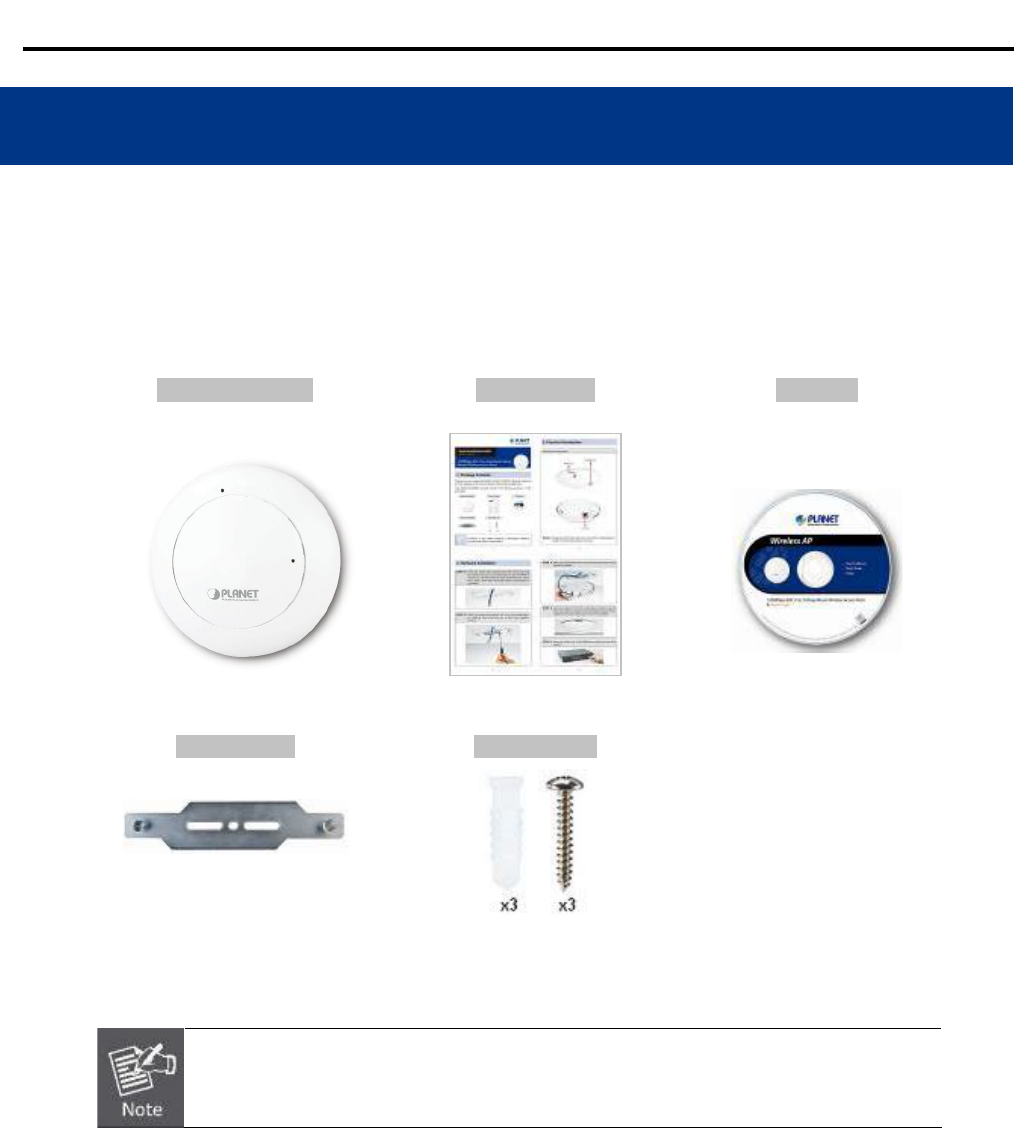
User Manual of WDAP-C7200AC
-1-
Chapter 1. Product Introduction
1.1 Package Contents
Thank you for choosing PLANET WDAP-C7200AC. Before installing the AP, please verify the contents inside the
package box.
WDAP-C7200AC Quick Guide CD-ROM
(User Manual included)
Quick Guide Mounting Kit
If there is any item missing or damaged, please contact the seller immediately.
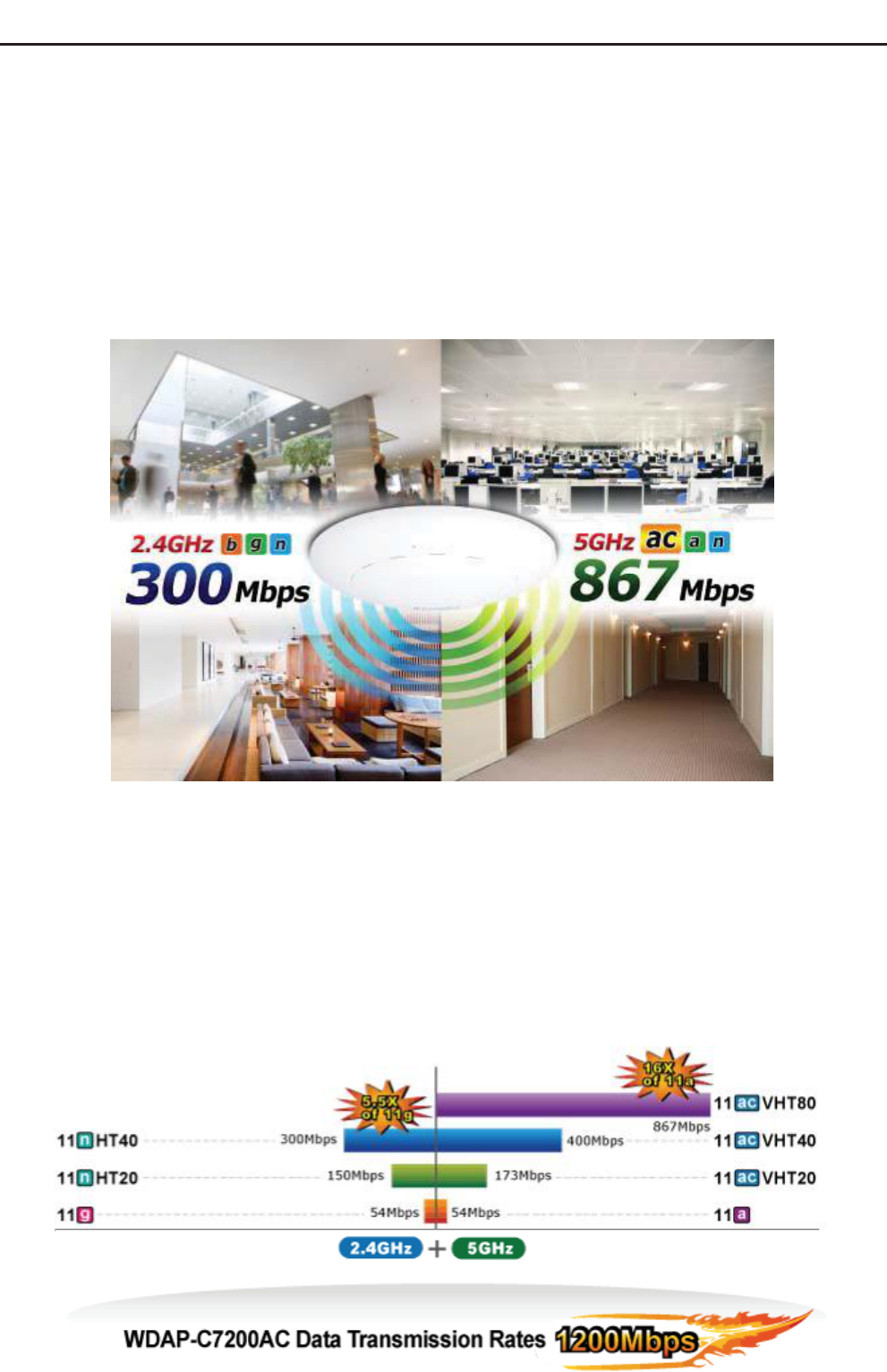
User Manual of WDAP-C7200AC
-2-
1.2 Product Description
Ceiling Mount Designed for Highly-efficient Wireless Coverage
Featuring attractive flying saucer appearance and ceiling-mount design, the WDAP-C7200AC can be firmly
installed on the ceiling or the wall conveniently. The ceiling-mount design is smartly integrated into the
environment. Its streamlined body without the protruding antennas also gives effects of embellishment in the
surroundings. Moreover, the WDAP-C7200AC is compliant with the IEEE 802.3at PoE standard, so it is easy
and flexible in client-side installation. It is definitely nice to have this eye-catching access point mount on the
ceilings and walls of villas, hotels, exhibit halls, and other establishments.
Brand-new 11ac Wireless Technology
The WDAP-C7200AC supports IEEE 802.11a/b/g/n/ac dual band standards with 2T2R MIMO technology;
therefore, it provides the wireless speed up to 300+867Mbps, which is 16X faster than the 11a access point at
5GHz frequency and 5.5X faster than the 11g access point at 2.4GHz frequency. Moreover, the
WDAP-C7200AC is equipped with Gigabit Ethernet Port. Compared with the general wireless APs, the
WDAP-C7200AC offers faster transmission speed for the network applications and less interference to enhance
data throughput. The incredible wireless speed makes it ideal for handling multiple HD movie streams,
high-resolution on-line games, stereo music, VoIPs and data streams at the same time stably and smoothly.
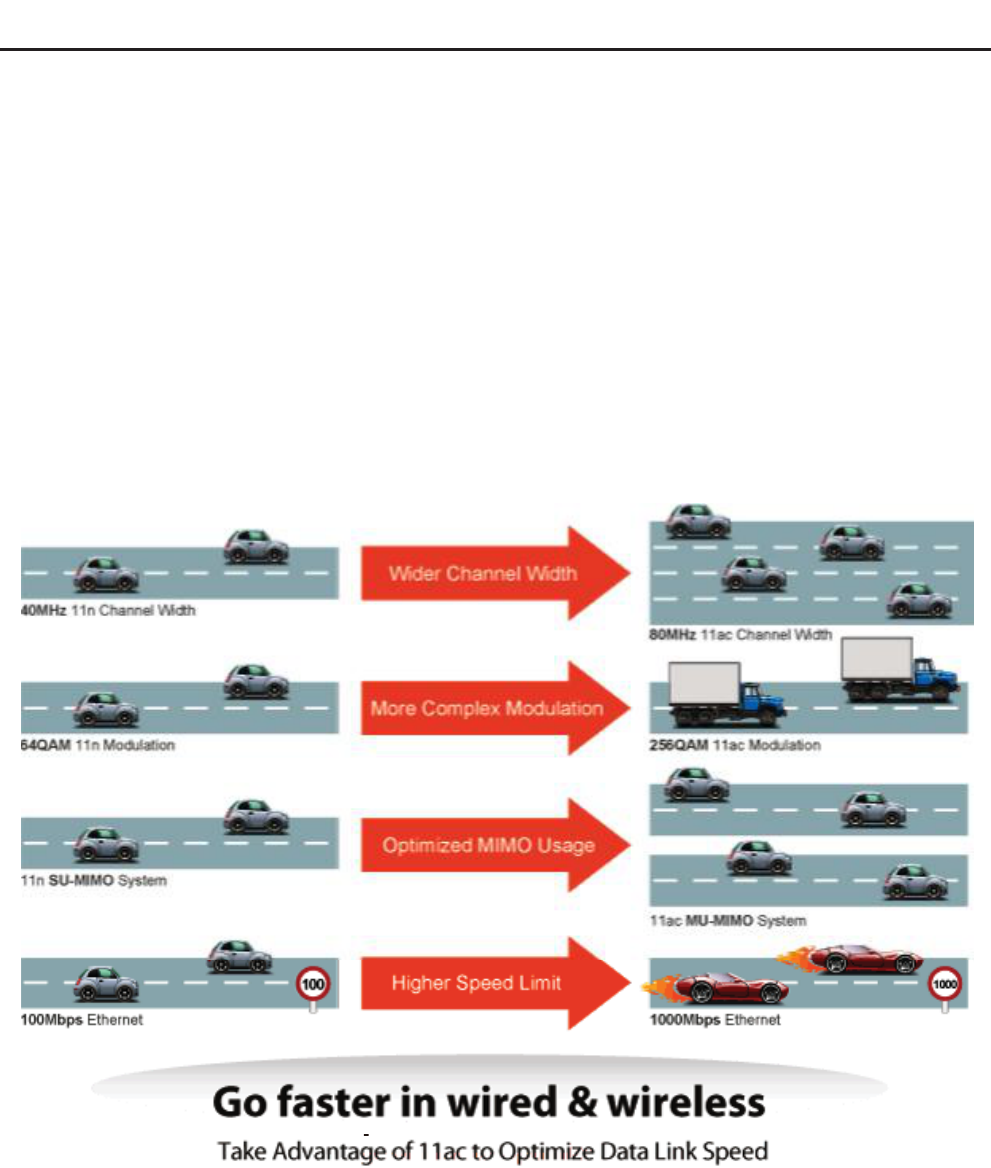
User Manual of WDAP-C7200AC
-3-
11ac Innovations Bring Excellent Data Link Speed
The WDAP-C7200AC is built-in with high power amplifier and 4 highly-sensitive antennas which provide
stronger signal and excellent coverage even in the wide-ranging or bad environment. With adjustable transmit
power option, the administrator can flexibly reduce or increase the output power for various environments, thus
reducing interference to achieve maximum performance. To provide extremely high-speed user experience, the
WDAP-C7200AC adopts IEEE 802.11ac technology to extend the 802.11n 40MHz channel binding to 80MHz
and the implementation of 256-QAM modulation where higher transmitting/receiving rates go up to 867Mbps in
5GHz less interference frequency band. In addition, the WDAP-C7200AC is equipped with gigabit LAN port to
eliminate the restriction of 100Mbps Fast Ethernet wired connection to let users fully enjoy the high speed
provided by wireless. The IEEE 802.11ac also optimizes MU-MIMO (Multi-User MIMO) mechanism to serve
multiple devices simultaneously.
Full Support of Wireless Security Encryption and Wireless Value-added Features
In aspect of security, besides 64/128-bit WEP encryption, the WDAP-C7200AC is integrated with WPA / WPA2,
WPA-PSK / WPA2-PSK and 802.1x Radius authority to secure and protect your wireless LAN. It provides the
wireless MAC filtering and SSID broadcast control to consolidate the wireless network security and prevent
unauthorized wireless connection. Being an access point, the WDAP-C7200AC supports the VLAN function to
allow multiple SSIDs (10 sets of SSIDs) to access Internal VLAN topology. Moreover, its Wi-Fi Multimedia (WMM)
mechanism provides enhanced QoS over wireless connection for better performance in multimedia transmission
like on-line gaming and video streaming, which are classified as a top priority.
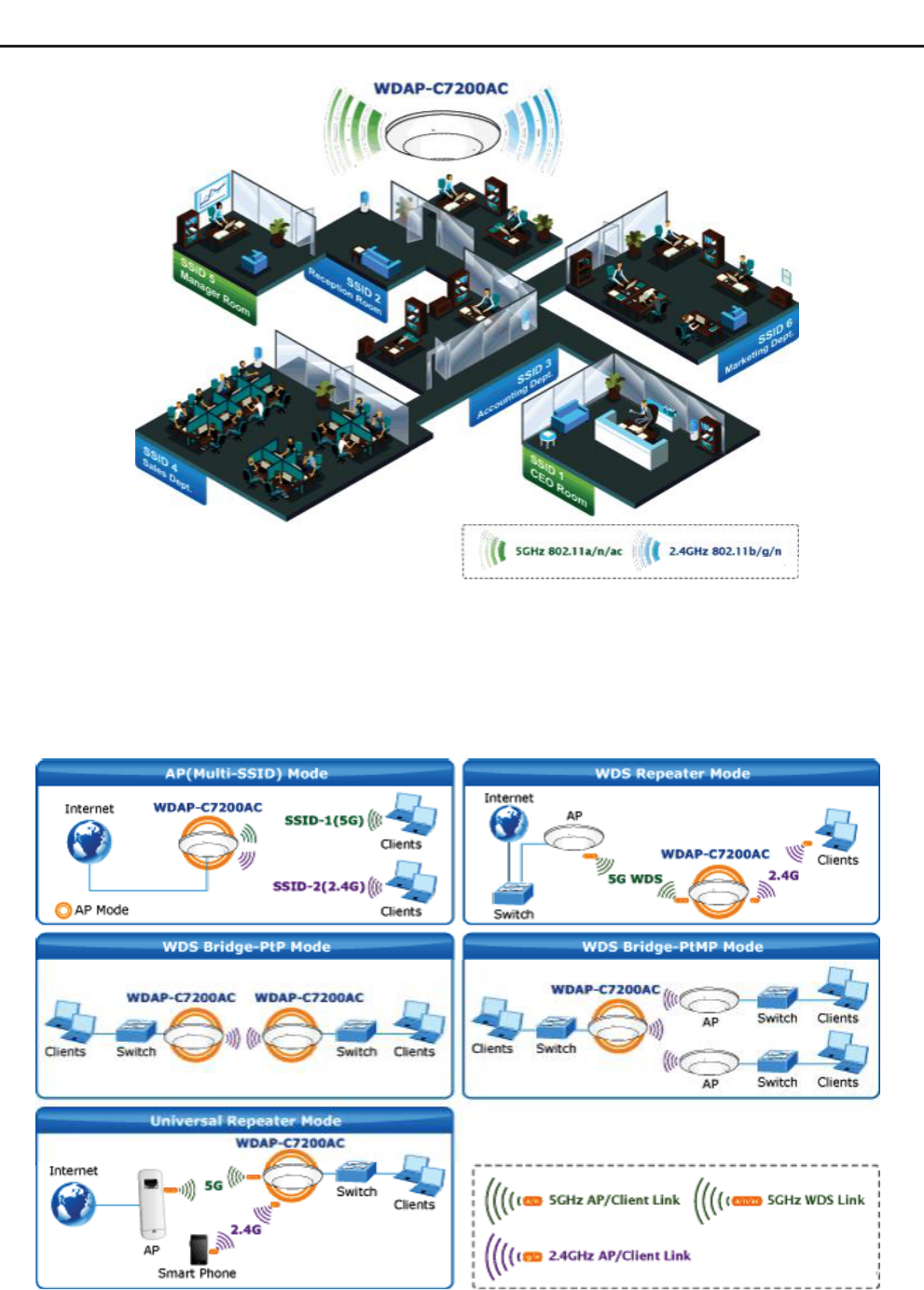
User Manual of WDAP-C7200AC
-4-
Multiple Operation Modes for Various Applications
The WDAP-C7200AC supports AP, Client, WDS Bridge, Repeater and Universal Repeater modes, through
which it provides more flexibility for users when wireless network is established. Compared with general wireless
access point, the WDAP-C7200AC offers more powerful and flexible capability for wireless clients.
Flexible Deployment with PoE Feature
Compliant with the IEEE 802.3at Power over Ethernet standard, the WDAP-C7200AC can be powered and
networked by a single UTP cable. It thus reduces the needs of extra cables and dedicated electrical outlets on
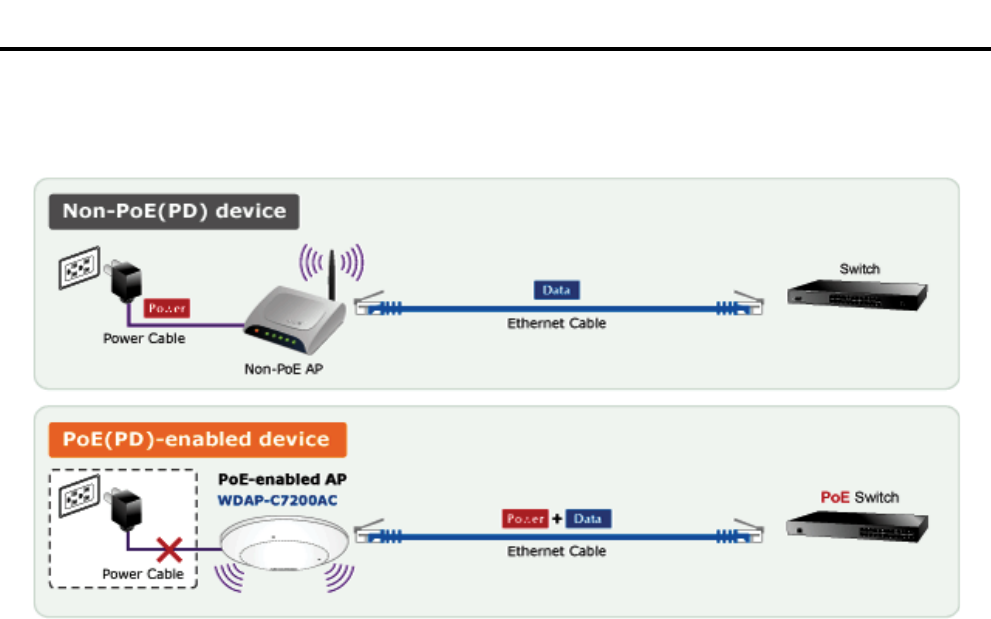
User Manual of WDAP-C7200AC
-5-
the wall, ceiling or any other place where it is difficult to reach. The wireless network deployment becomes more
flexible and worry-free from the power outlet locations.
Easy Installation and Management
With user-friendly Web UI and step-by-step Quick Setup Wizard, the WDAP-C7200AC is easy to install, even for
users who never experience setting up a wireless network. Furthermore, with SNMP-based management
interface, the WDAP-C7200AC is convenient to be managed and configured remotely in a small business
wireless network.
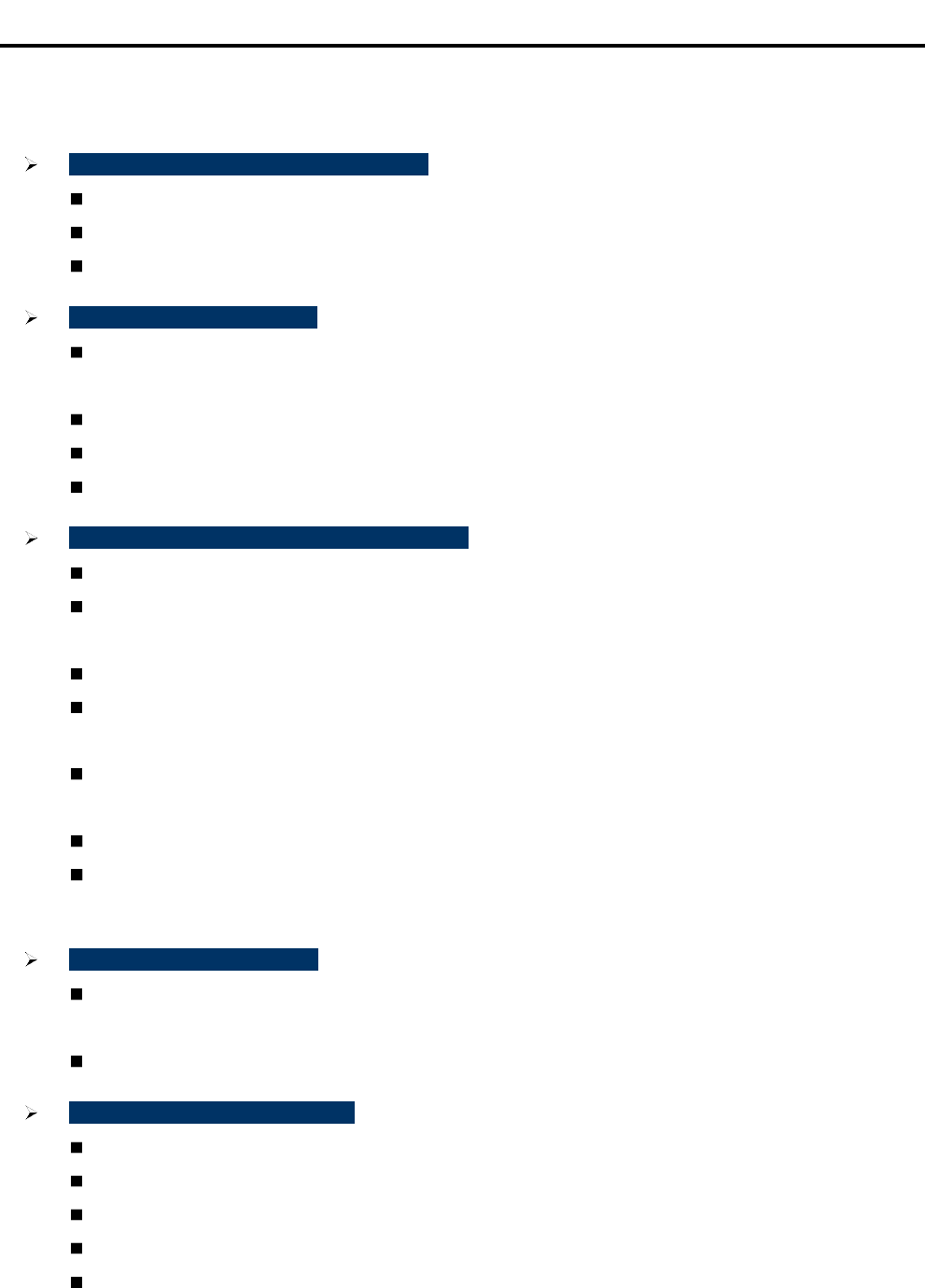
User Manual of WDAP-C7200AC
-6-
1.3 Product Features
Standard Compliant Hardware Interface
Complies with IEEE 802.11ac (draft 2.0) and IEEE 802.11a/b/g/n standards
1 x 10/100/1000Base-TX Port with 1-port PoE (PD, Powered Device)
IEEE 802.3at Power over Ethernet design
RF Interface Characteristics
Features 2.4GHz (802.11b/g/n) and 5GHz (802.11a/n/ac) concurrent dual band for more efficiency
of carrying high load traffic
2T2R MIMO technology for enhanced throughput and coverage
Provides multiple adjustable transmit power control
High speed up to 1.2Gbps (300Mbps for 2.4GHz + 867Mbps for 5GHz) wireless data rate
Comprehensive Wireless Advanced Features
Multiple Wireless Modes: AP, Client, WDS PtP/ PtMP, WDS Repeater, Universal Repeater
Supports up to 10 multiple-SSIDs (2.4GHz+5GHz) to allow users to access different networks
through a single AP
Supports VLAN function to limit the clients to access the specific internal network resource
Supports WMM (Wi-Fi Multimedia) and wireless QoS to enhance the efficiency of multimedia
application
Supports IAPP (Inter Access Point Protocol) and wireless roaming to enable clients to roam across
different wireless networks
Supports 5-level Transmitting Power Control to adapt various environments
Supports wireless schedule to automatically enable or disable the wireless function based on
predefined schedule
Secure Network Connection
Advanced security: 64/128-bit WEP, WPA / WPA2, WPA-PSK / WPA2-PSK (TKIP/AES encryption)
and 802.1x Radius Authentication
Supports MAC address filtering
Easy Installation & Management
Flexible deployment with standard 802.3at PoE/ PD supported
Web-based UI and Quick Setup Wizard for easy configuration
Remote Management allows configuration from a remote site
SNMP-based management interface
System status monitoring includes DHCP Client and System Log
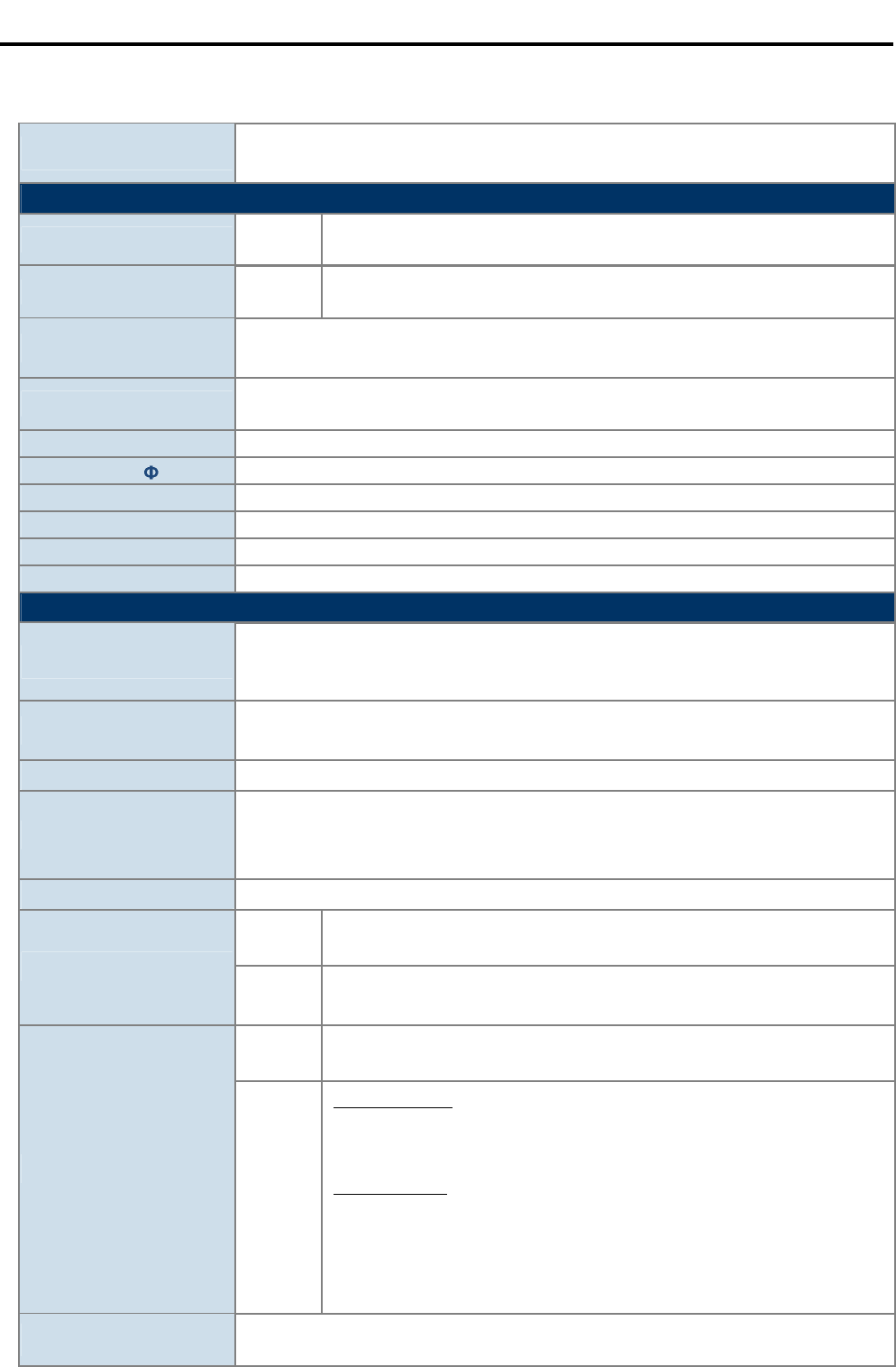
User Manual of WDAP-C7200AC
-7-
1.4 Product Specifications
Product WDAP-C7200AC
1200Mbps 802.11ac Dual Band Ceiling Mount Wireless Access Point
Hardware Specifications
Interfaces LAN 1 x 10/100/1000Base-T RJ45 port
Auto-negotiation and Auto MDI/MDI-X
Antennas Gain: 2 x 2.4GHz 3dBi PCBA antenna
2 x 5GHz 2.5dBi PCBA antenna
Reset Button Reset button on the top cover
Press over 7 seconds to reset the device to factory default
LED Indicators PWR
Allow LED to turn off via software control
Material Plastic
Dimensions ( x H) 194 x 49 mm
Weight 300 ±5g
Power Requirements 802.3at PoE, 48-56V DC input
Power Consumption 20W (max.)
Mounting Ceiling Mount
Wireless Interface Specifications
Standard
IEEE 802.11ac (Draft 2.0) 5GHz
IEEE 802.11a/n 5GHz
IEEE 802.11b/g/n 2.4GHz
Antenna Structure 802.11ac: 2T2R MU-MIMO
802.11n: 2T2R MIMO
Modulation DSSS
Data Modulation
802.11ac: OFDM (BPSK / QPSK / 16QAM / 64QAM / 256QAM)
802.11a/g/n: OFDM (BPSK / QPSK / 16QAM / 64QAM)
802.11b: DSSS (DBPSK / DQPSK / CCK)
Band Mode 2.4G / 5G concurrent mode
2.4GHz America/ FCC: 2.412~2.462GHz
Europe/ ETSI: 2.412~2.484GHz
Frequency Range
5GHz America/ FCC: 5.180~5.240GHz, 5.725~5.850GHz
Europe/ ETSI: 5.180~5.240GHz
2.4GHz America/ FCC: 1~11
Europe/ ETSI: 1~13
Operating Channels
5GHz
America/ FCC:
36, 40, 44, 48, 149, 153, 157, 161, 165
Europe/ ETSI:
36, 40, 44, 48
5GHz channel list will vary in different countries according to their
regulations.
Channel Width 802.11ac: 20/40/80MHz
802.11n: 20/40MHz
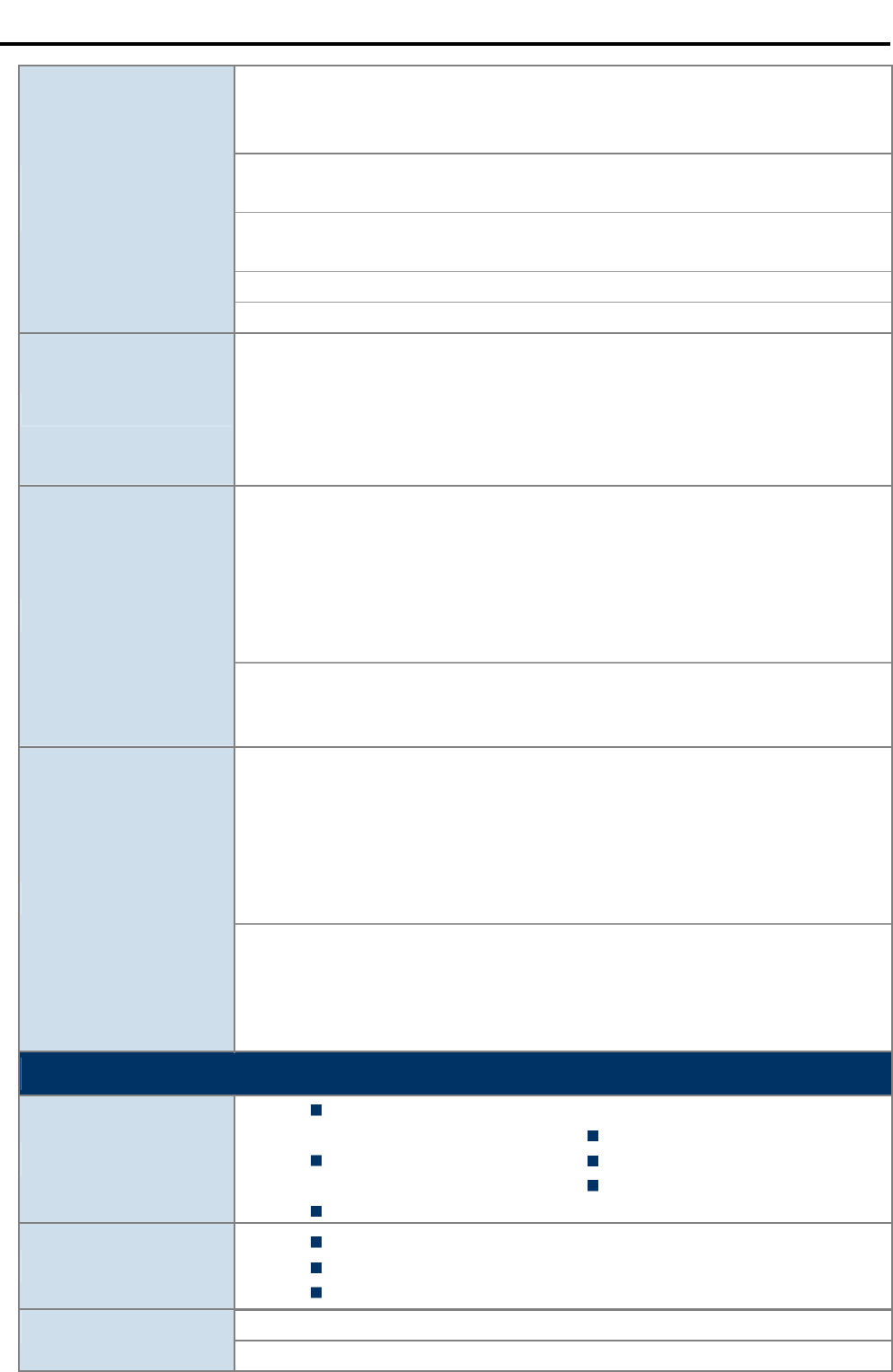
User Manual of WDAP-C7200AC
-8-
802.11ac (VHT20, Nss2-MCS8): Up to 173.3Mbps
802.11ac (VHT40, Nss2-MCS9): Up to 400Mbps
802.11ac (VHT80, Nss2-MCS9): Up to 867Mbps
802.11n (HT40): 270/243/216/162/108/81/54/27Mbps
135/121.5/108/81/54/40.5/27/13.5Mbps (dynamic)
802.11n (HT20): 130/117/104/78/52/39/26/13Mbps
65/58.5/52/39/26/19.5/13/6.5Mbps (dynamic)
802.11g: 54/48/36/24/18/12/9/6Mbps (dynamic)
Data Transmission
Rates
802.11b: 11/5.5/2/1Mbps (dynamic)
Transmission Distance
802.11ac (draft): up to 30m
802.11n: up to 70m
802.11g: up to 30m
The estimated transmission distance is based on the theory. The actual
distance will vary in different environments.
5GHz:
802.11ac (VHT20): 22dBm
802.11ac (VHT40): 22dBm
802.11ac (VHT80): 22dBm
802.11n (HT20): 22dBm
802.11n (HT40): 22dBm
802.11a: 22dBm
Max. RF Power
2.4GHz:
802.11n: 17 ±2.5dBm
802.11b/g: 20 ±2.5dBm
5GHz:
802.11ac (VHT20): -91dBm @ Nss1-MCS0, -64dBm @ Nss2-MCS8
802.11ac (VHT40): -89dBm @ Nss1-MCS0, -59dBm @ Nss2-MCS9
802.11ac (VHT80): -86dBm @ Nss1-MCS0, -56dBm @ Nss2-MCS9
802.11n (HT20): -92dBm @ MCS0, -71dBm @ MCS7
802.11n (HT40): -89dBm @ MCS0, -66dBm @ MCS15
802.11a: -93 @ 6Mbps, -75dBm @ 54Mbps
Receive Sensitivity
2.4GHz:
802.11n 20MHz (MCS7): -69dBm @10% PER
802.11n 40MHz (MCS15): -66dBm @10% PER
802.11g (54Mbps): -74dBm @10% PER
802.11b (11Mbps): -88dBm @10% PER
Software Features
Wireless Mode
Universal Repeater
(AP+Client)
Repeater
(WDS+AP)
AP (Access Point)
WDS PTP (Point to Point)
WDS PTMP (Point to Multipoint)
Client
Encryption Security
WEP (64/128-bit) encryption security
WPA / WPA2 (TKIP/AES)
WPA-PSK / WPA2-PSK (TKIP/AES)
Provides wireless LAN ACL (Access Control List) filtering
Wireless Security
Wireless MAC address filtering
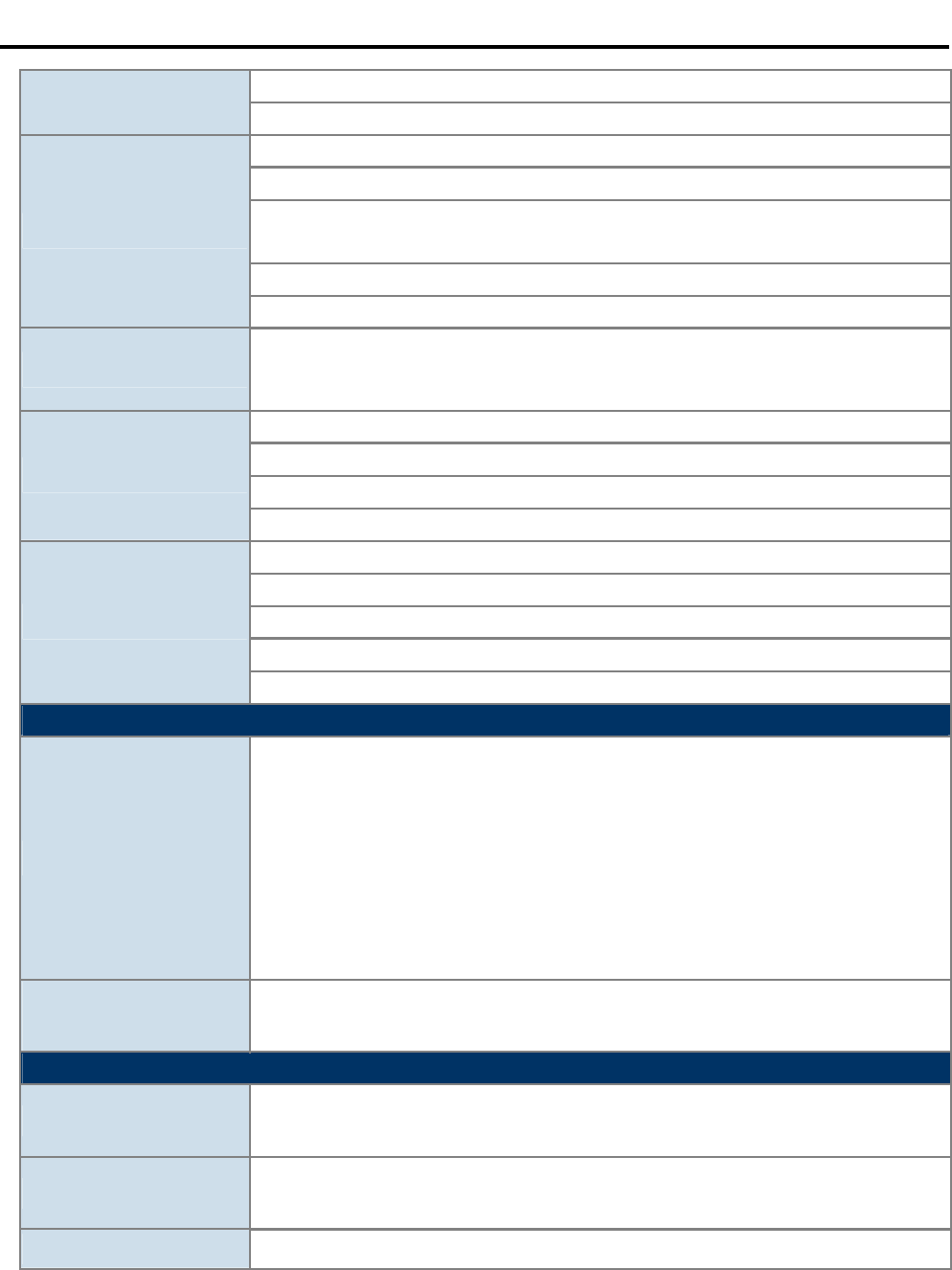
User Manual of WDAP-C7200AC
-9-
Supports WPS (Wi-Fi Protected Setup)
Enable/ Disable SSID Broadcast
WMM (Wi-Fi Multimedia): 802.11e Wireless QoS
Multiple SSID: up to 5 at 2.4GHz and 5GHz, respectively
Wireless Isolation: Enables to isolate each connected wireless client from
communicating with each other
IAPP (Inter Access Point Protocol): 802.11f Wireless Roaming
Wireless Advanced
Provides Wireless Statistics
Max. Clients
Wire: 253
2.4GHz Wireless: 32
5GHz Wireless: 32
Built-in DHCP server supporting static IP address distributing
Supports UPnP
Supports 802.1d Spanning Tree
LAN
Supports 802.1Q VLAN
Web-based (HTTP) management interface
SNTP time synchronize
Easy firmware upgrade
Supports Scheduling Reboot
System Management
Supports Smart Discovery Utility
Standards Conformance
IEEE Standards
IEEE 802.11ac (Draft 2.0, 2T2R, up to 867Mbps)
IEEE 802.11n (2T2R, up to 300Mbps)
IEEE 802.11g
IEEE 802.11b
IEEE 802.11i
IEEE 802.3 10Base-T
IEEE 802.3u 100Base-TX
IEEE 802.3ab 1000Base-T
IEEE 802.3x Flow Control
Other Protocols and
Standards CSMA/CA, CSMA/CD, TCP/IP, DHCP, ICMP, SNTP
Environment & Certification
Temperature
Operating: 0 ~ 50 degrees C
Storage: -40 ~ 70 degrees C
Humidity
Operating: 10 ~ 90% (non-condensing)
Storage: 5 ~ 90% (non-condensing)
Regulatory FCC Part 15B & 15C, IC, RoHS

User Manual of WDAP-C7200AC
-10-
Chapter 2. Hardware Installation
Please follow the instructions below to connect WDAP-C7200AC to the existing network devices and your computers.
2.1 Product Outlook
Dimensions: 194 x 49 mm ( x H)
Drawing :
Figure 2-1 WDAP-C7200AC Product Drawing
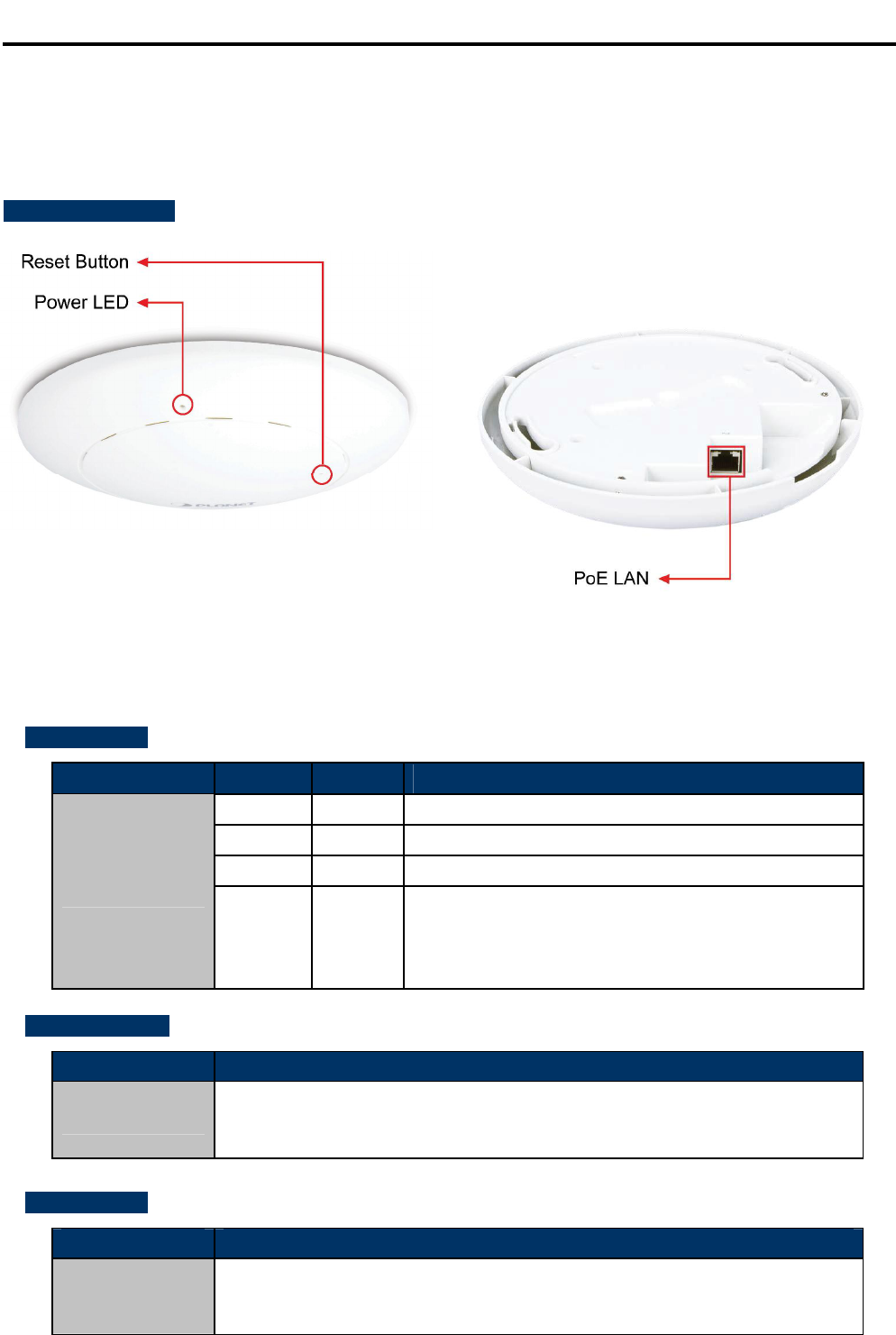
User Manual of WDAP-C7200AC
-11-
2.1.1 Panel Layout
The front and rear panel provide a simple interface monitoring the AP. Figure 2-2 shows the hardware interface
of the WDAP-C7200AC.
Hardware Interface
Figure 2-2 WDAP-C7200AC Panel Layout
2.1.2 Hardware Description
LED definition
LED COLOR STATUS FUNCTION
Green On Device power on
Green Off Device power off (control by S/W)
Orange On System initializing, turned it off when system completed
PWR
Orange Blinking
Detect and identify the LED (control by S/W)
1) Position LED on: LED blinks continuously.
2) Position LED off: the LED is off.
Button definition
Object Description
Reset To restore to the factory default setting, press and hold the Reset Button over 7
seconds, and then release it.
Port definition
Object Description
PoE Port
(802.3at PoE)
10/100/1000Mbps RJ-45 port , Auto MDI/ MDI-X
Connect PoE port to the IEEE 802.3at PSE to power on the device.
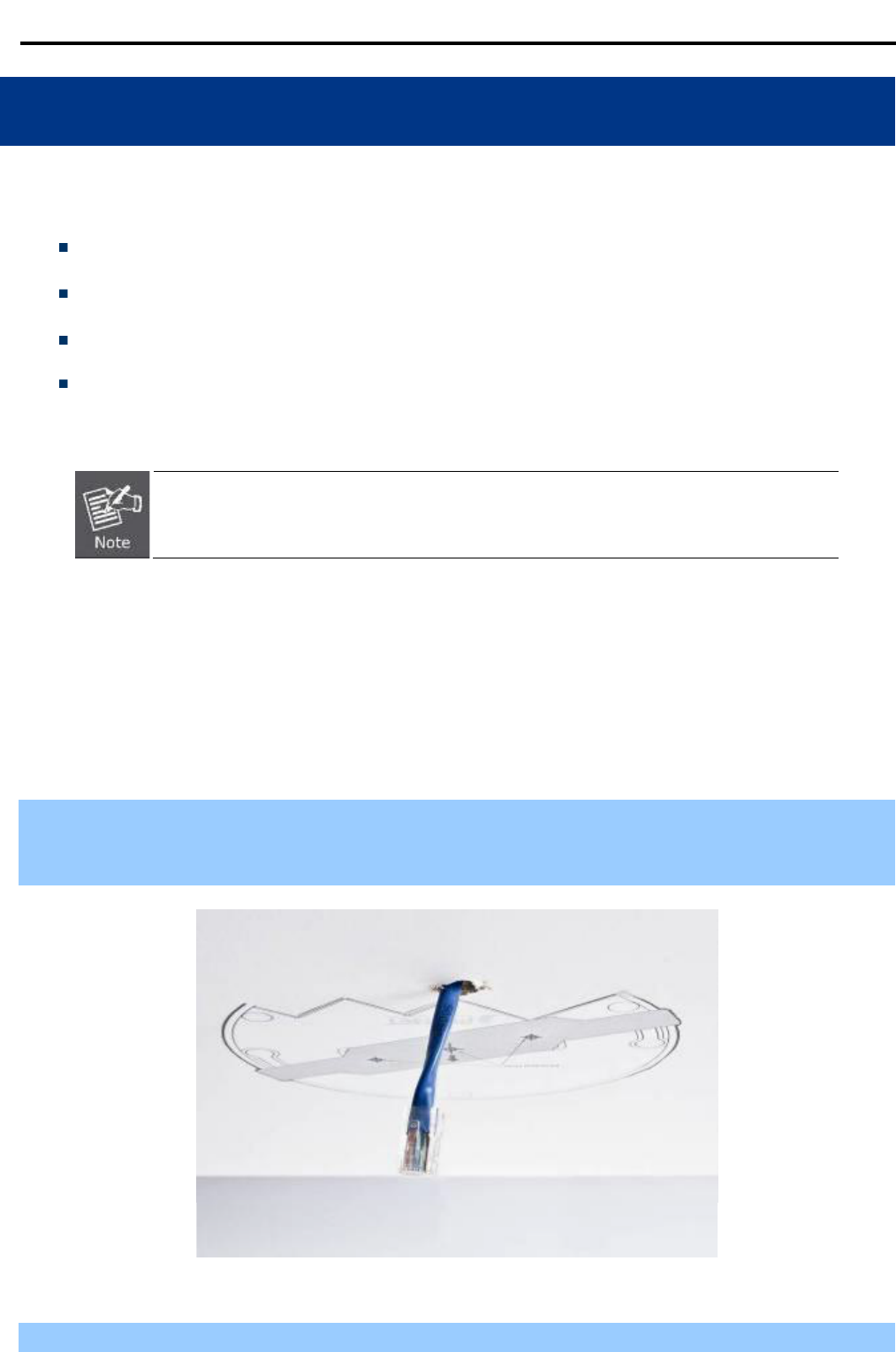
User Manual of WDAP-C7200AC
-12-
Chapter 3. Connecting to the AP
3.1 System Requirements
Broadband Internet Access Service (Cable/xDSL/Ethernet connection)
One IEEE 802.3at PoE switch (supply power to the WDAP-C7200AC)
PCs with a working Ethernet Adapter and an Ethernet cable with RJ-45 connectors
PCs running Windows 98/ME, NT4.0, 2000/XP, Windows Vista / Win 7, MAC OS 9 or later, Linux,
UNIX or other platforms compatible with TCP/IP protocols
1. The AP in the following instructions refers to PLANET WDAP-C7200AC.
2. It is recommended to use Internet Explore 7.0 or above to access the AP.
3.2 Installing the AP
Before installing the AP, make sure your PoE switch is connected to the Internet through the broadband service
successfully at this moment. If there is any problem, please contact your local ISP. After that, please install the
AP according to the following steps. Don't forget to pull out the power plug and keep your hands dry.
Step 1. Drill the outlet hole indicated on the mounting label and stick the given mounting label to the installation
location to let the Ethernet cable penetrate the outlet hole. Then, drill the mounting holes as indicated
on the label.
Figure 3-1 WDAP-C7200AC Installation Diagram 1
Step 2. Take the mounting bracket, put it on the target place by aligning the holes and fix it with the supplied
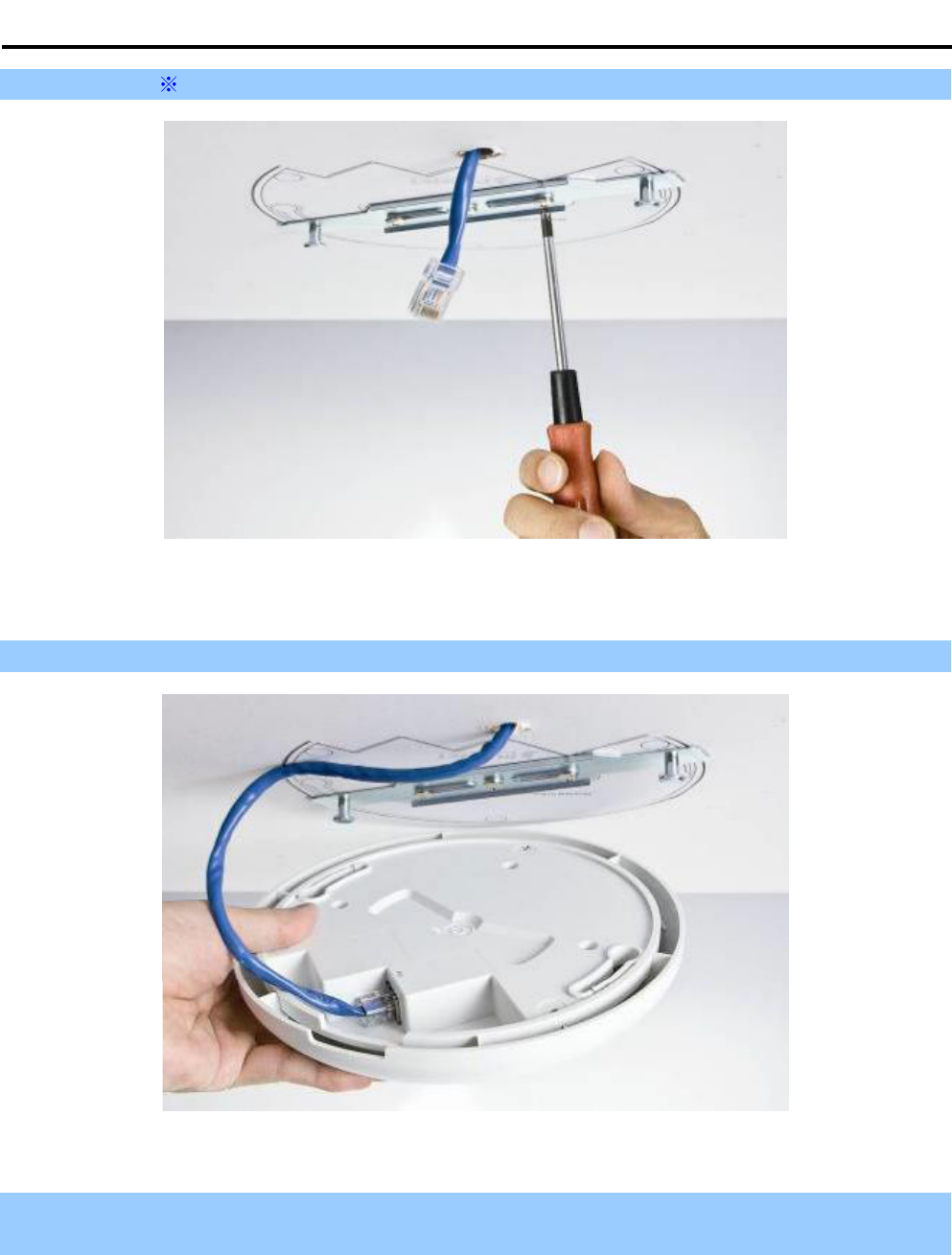
User Manual of WDAP-C7200AC
-13-
screws. IEEE 802.3at PoE switch is required.
Figure 3-2 WDAP-C7200AC Installation Diagram 2
Step 3. Plug the RJ-45 Ethernet cable into the PoE port of the WDAP-C7200AC.
Figure 3-3 WDAP-C7200AC Installation Diagram 3
Step 4. Load the device into the mounting bracket, and be sure the device is mated with two fixed screws.
Then, rotate the device clockwise to lock it in position.
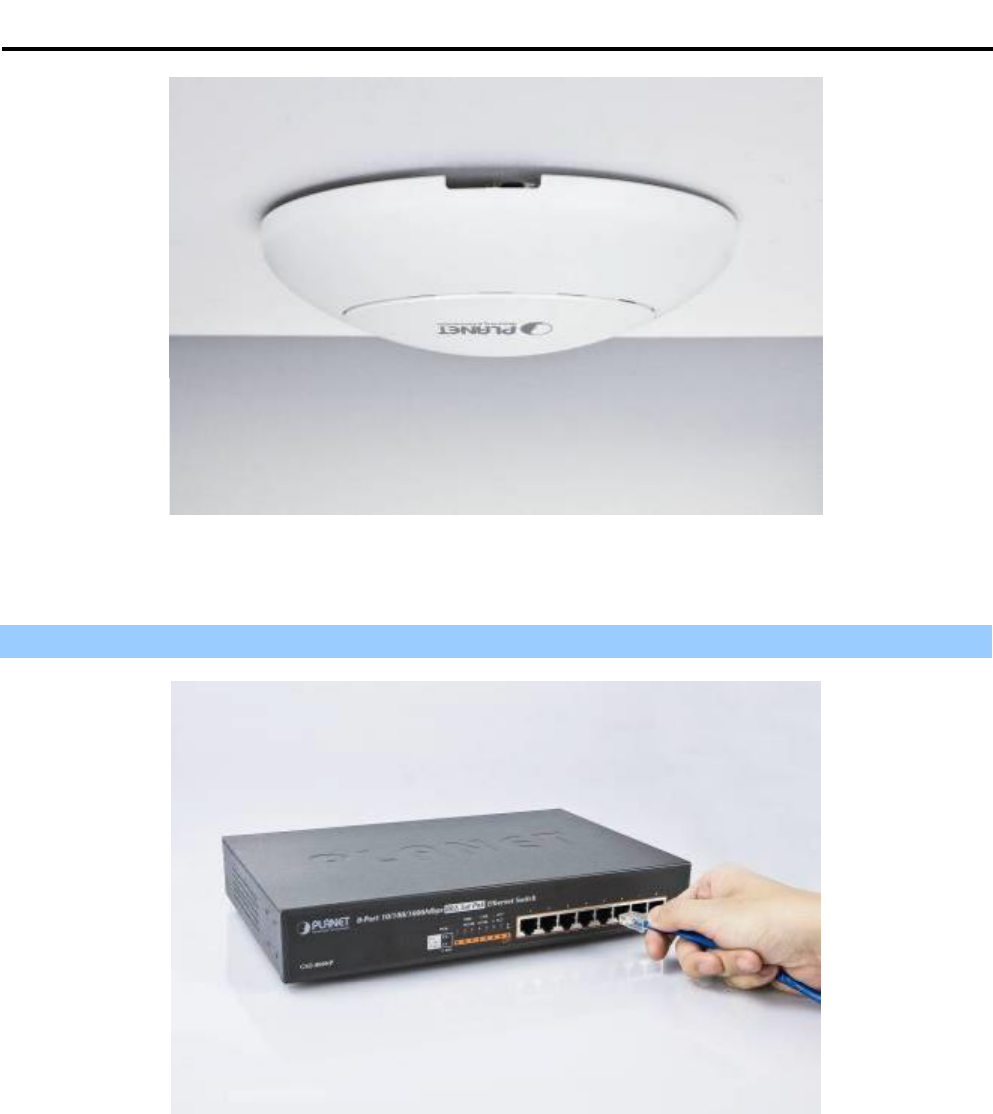
User Manual of WDAP-C7200AC
-14-
Figure 3-4 WDAP-C7200AC Installation Diagram 4
Step 5. Plug the other end of the Ethernet cable into the PoE switch.
Figure 3-5 WDAP-C7200AC Installation Diagram 4

User Manual of WDAP-C7200AC
-15-
Chapter 4. Quick Installation Guide
This chapter will show you how to configure the basic functions of your AP within minutes.
A computer with wired Ethernet connection to the Wireless AP is required for the first-time
configuration.
4.1 Manual Network Setup - TCP/IP Configuration
The default IP address of the WDAP-C7200AC is 192.168.1.253. And the default Subnet Mask is 255.255.255.0.
These values can be changed as you want. In this guide, we use all the default values for description.
Connect the WDAP-C7200AC with your PC by an Ethernet cable plugging in LAN port on one side and in LAN
port of PC on the other side. Please power on the WDAP-C7200AC by PoE switch through the PoE port.
In the following sections, well introduce how to install and configure the TCP/IP correctly in Windows 7. And the
procedures in other operating systems are similar. First, make sure your Ethernet Adapter is working, and refer
to the Ethernet adapter manual if needed.
4.1.1 Configuring the IP Address Manually
Summary:
Set up the TCP/IP Protocol for your PC.
Configure the network parameters. The IP address is 192.168.1.xxx (if the default IP address of the
WDAP-C7200AC is 192.168.1.253, and the DSL router is 192.168.1.254, the "xxx" can be configured
to any number from 1 to 252), Subnet Mask is 255.255.255.0.
1Select Use the following IP address radio button, and then configure the IP address of the PC.
2For example, as the default IP address of the WDAP-C7200AC is 192.168.1.253 and the DSL router is
192.168.1.254, you may choose from 192.168.1.1 to 192.168.1.252.
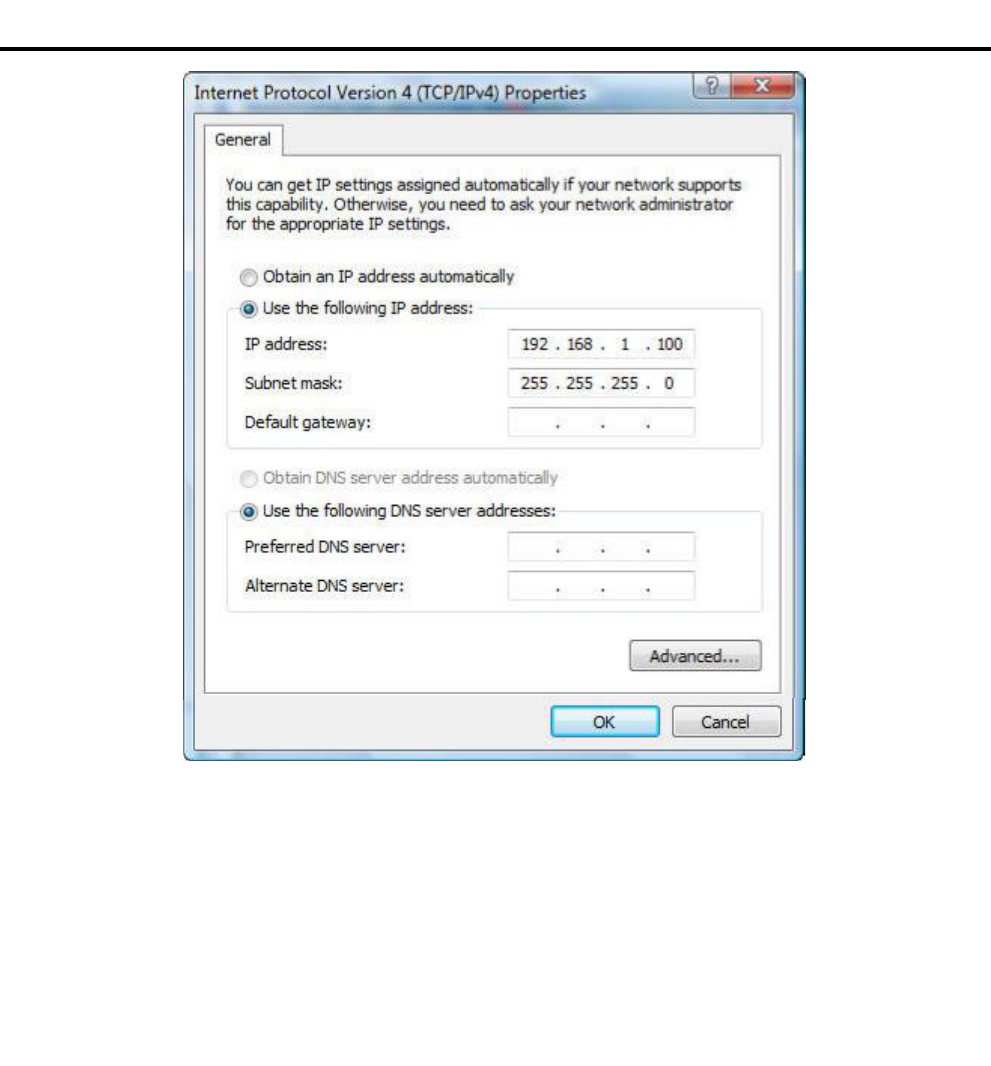
User Manual of WDAP-C7200AC
-16-
Figure 4-1 TCP/IP Setting
Now click OK to save your settings.
Now, you can run the Ping command in the command prompt to verify the network connection between your
PC and the AP. The following example is in Windows 7 OS. Please follow the steps below:
1. Click on Start > Run.
2. Type cmd in the Search box.
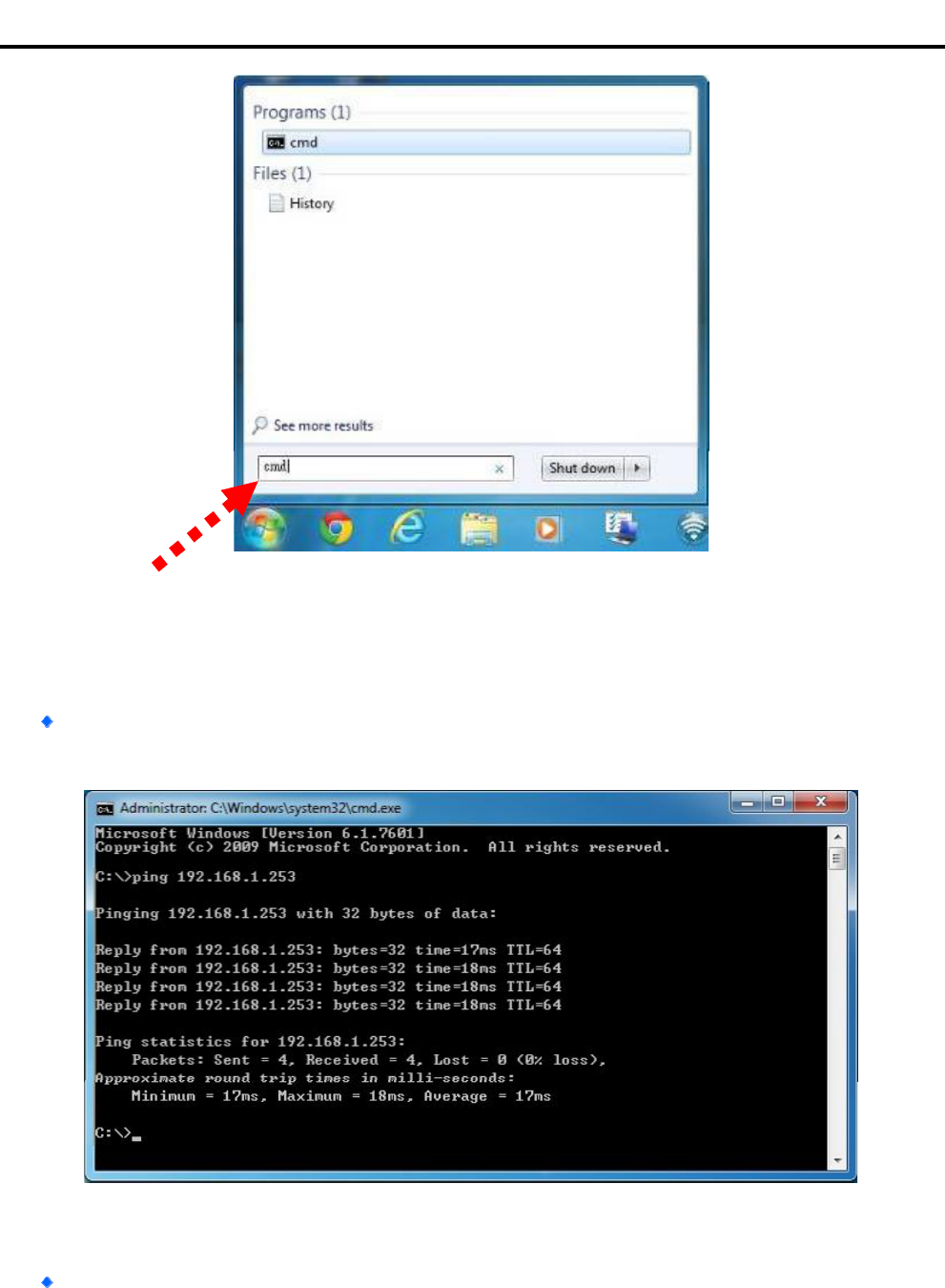
User Manual of WDAP-C7200AC
-17-
Figure 4-2 Windows Start Menu
3. Open a command prompt, type ping 192.168.1.253 and then press Enter.
If the result displayed is similar to Figure 4-3, it means the connection between your PC and the AP
has been established well.
Figure 4-3 Successful result of Ping command
If the result displayed is similar to Figure 4-4, it means the connection between your PC and the AP
has failed.
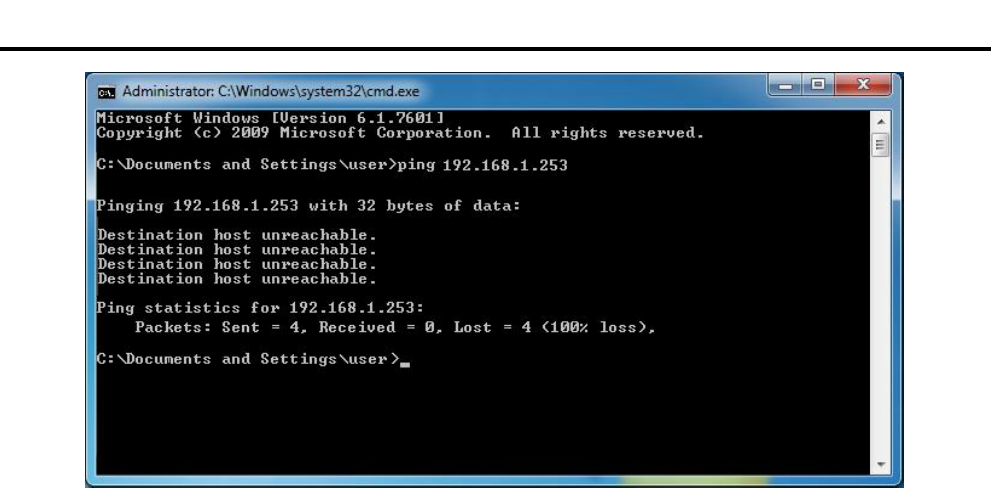
User Manual of WDAP-C7200AC
-18-
Figure 4-4 Failed Result of Ping Command
If the address is 0.0.0.0, check your adapter installation, security settings, and the settings on your AP. Some
firewall software programs may block a DHCP request on newly installed adapters.
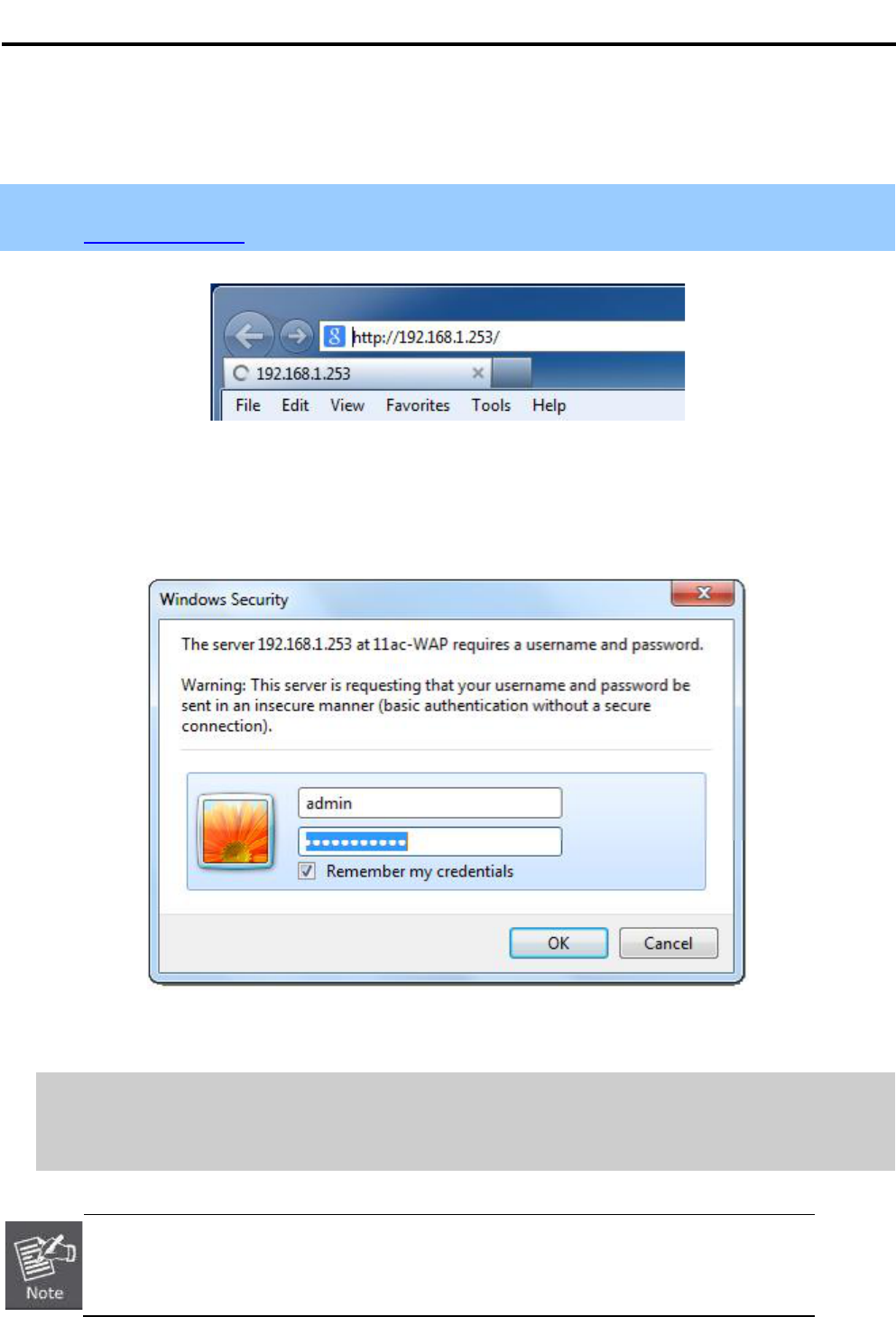
User Manual of WDAP-C7200AC
-19-
4.2 Starting Setup in the Web UI
It is easy to configure and manage the AP with the web browser.
Step 1. To access the configuration utility, open a web-browser and enter the default IP address
http://192.168.1.253 in the web address field of the browser.
Figure 4-5 Login by default IP address
After a moment, a login window will appear. Enter admin for the User Name and Password, both in lower case
letters. Then click the OK button or press the Enter key.
Figure 4-6 Login Window
Default IP Address: 192.168.1.253
Default User name: admin
Default Password: admin
If the above screen does not pop up, it may mean that your web-browser has been set to a
proxy. Go to Tools menu>Internet Options>Connections>LAN Settings on the screen that
appears, cancel the Using Proxy checkbox, and click OK to finish it.
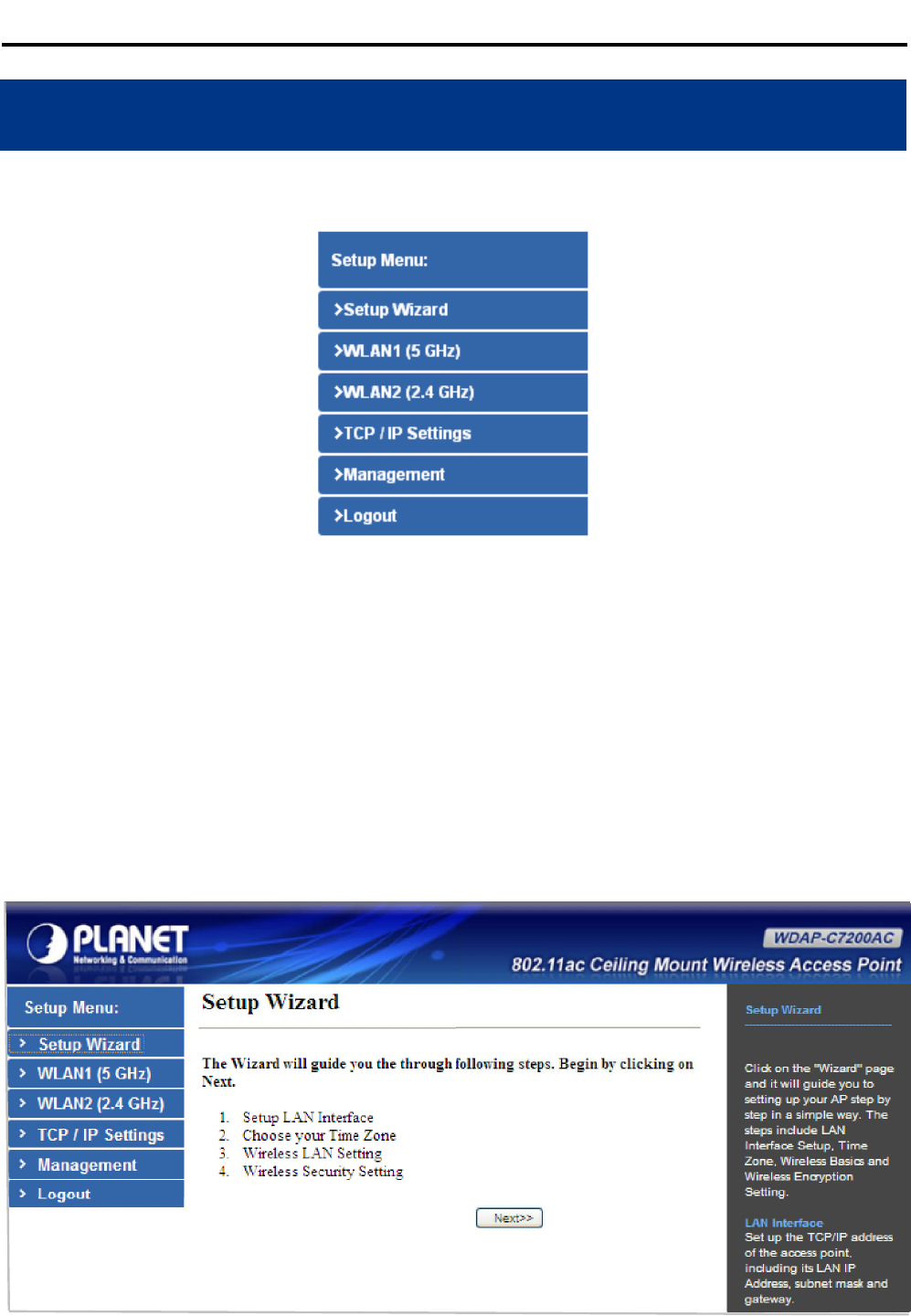
User Manual of WDAP-C7200AC
-20-
Chapter 5. Configuring the AP
This chapter delivers a detailed presentation of AP’s functionalities and features under 6 main menus below,
allowing you to manage the AP with ease.
Figure 5-1 Main Menu
During operation, if you are not clear about a certain feature, you can refer to the “Help” section in the right side
of the screen to read all related helpful info.
5.1 Setup Wizard
The Setup Wizard will guide the user to configure the WDAP-C7200AC easily and quickly. Select the Setup
Wizard on the left side of the screen and by clicking on Next on the Setup Wizard screen shown below, you will
then name your WDAP-C7200AC and set up its security.
Figure 5-2 Setup Wizard
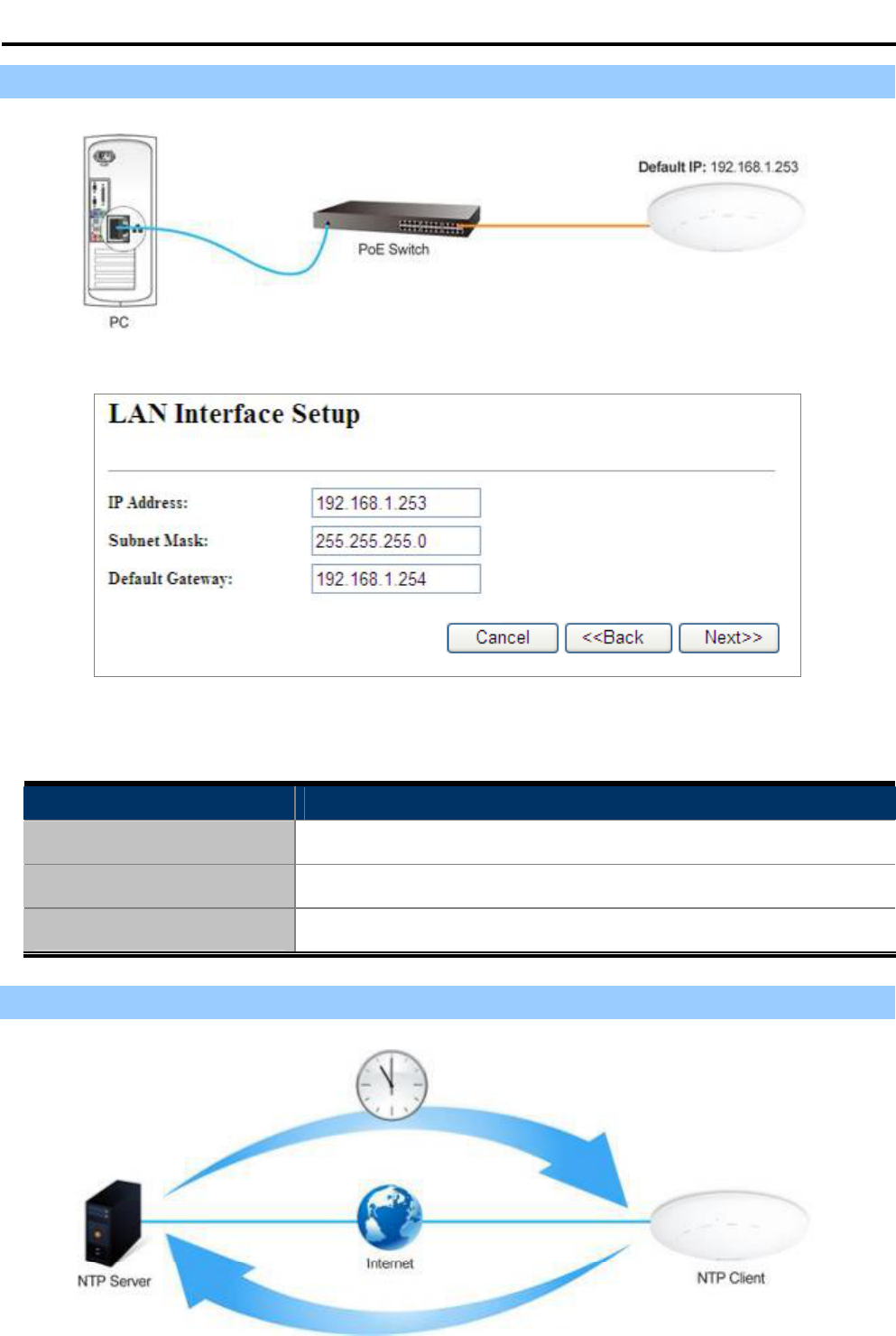
User Manual of WDAP-C7200AC
-21-
Step 1: LAN Interface Setup
Figure 5-3 LAN Interface SetupTopology
Figure 5-4 Wizard LAN Interface Setup
The page includes the following fields:
Object Description
IP Address Displays the current IP address of the AP. (Default = 192.168.1.253)
Subnet Mask Displays LAN mask of the AP. (Default = 255.255.255.0)
Default Gateway IP address of the associated router. (Default = 192.168.1.254)
Step 2: Time Zone Setting
Figure 5-5 Time Zone Setup Topology
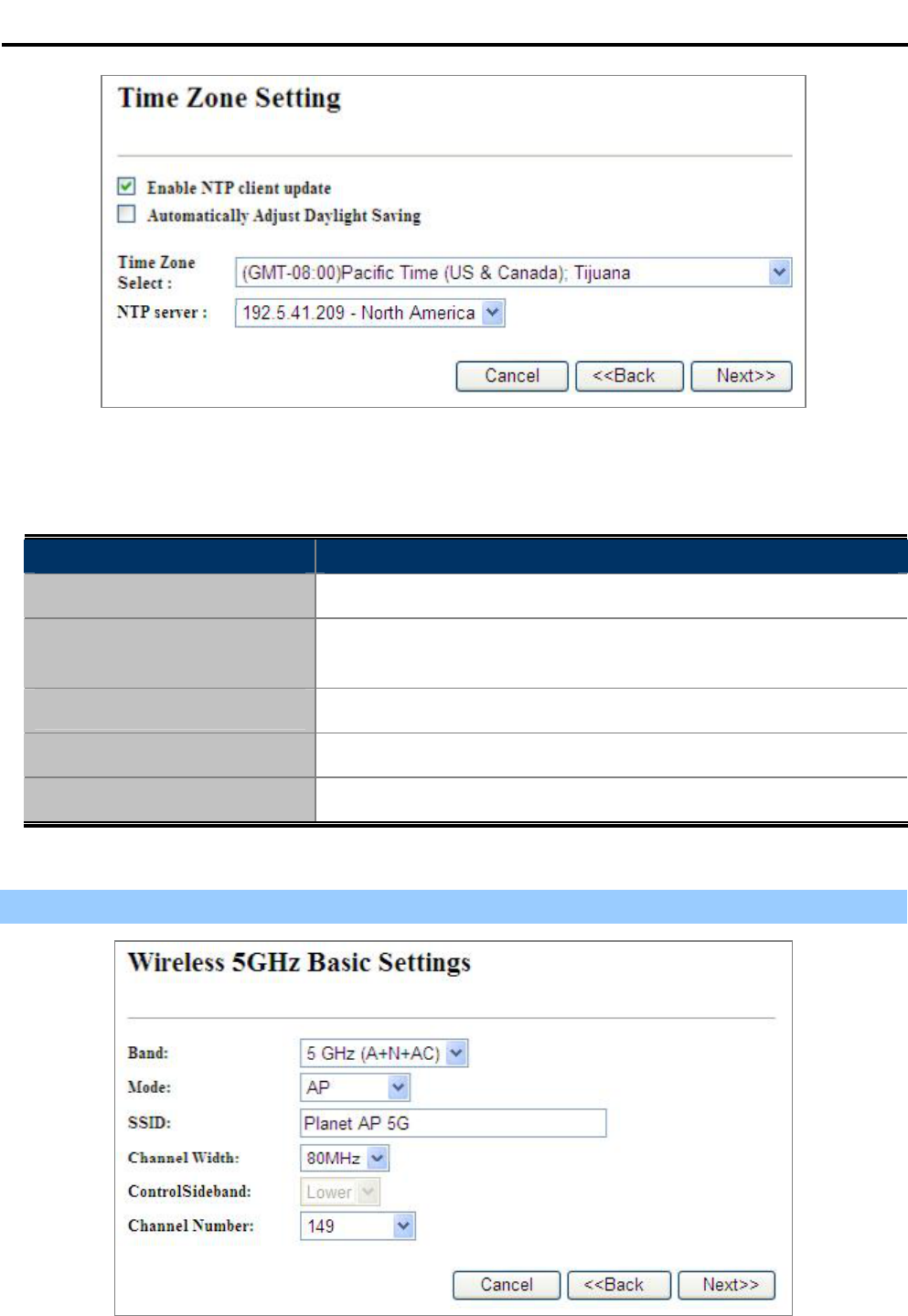
User Manual of WDAP-C7200AC
-22-
Figure 5-6 Wizard Time Zone Setup
The page includes the following fields:
Object Description
Enable NTP client update Check this box to connect NTP Server and synchronize internet time.
Automatically adjust
Daylight Saving
Check this box and system will adjust the daylight saving
automatically.
Time Zone Select Select the Time Zone from the drop-down menu.
NTP Server Select the NTP Server from the drop-down menu.
Enable NTP client update Check this box to connect NTP Server and synchronize internet time.
Step 3: Wireless 5GHz Basic Settings
Figure 5-7 Wizard Wireless 5GHz Basic Settings
The page includes the following fields:
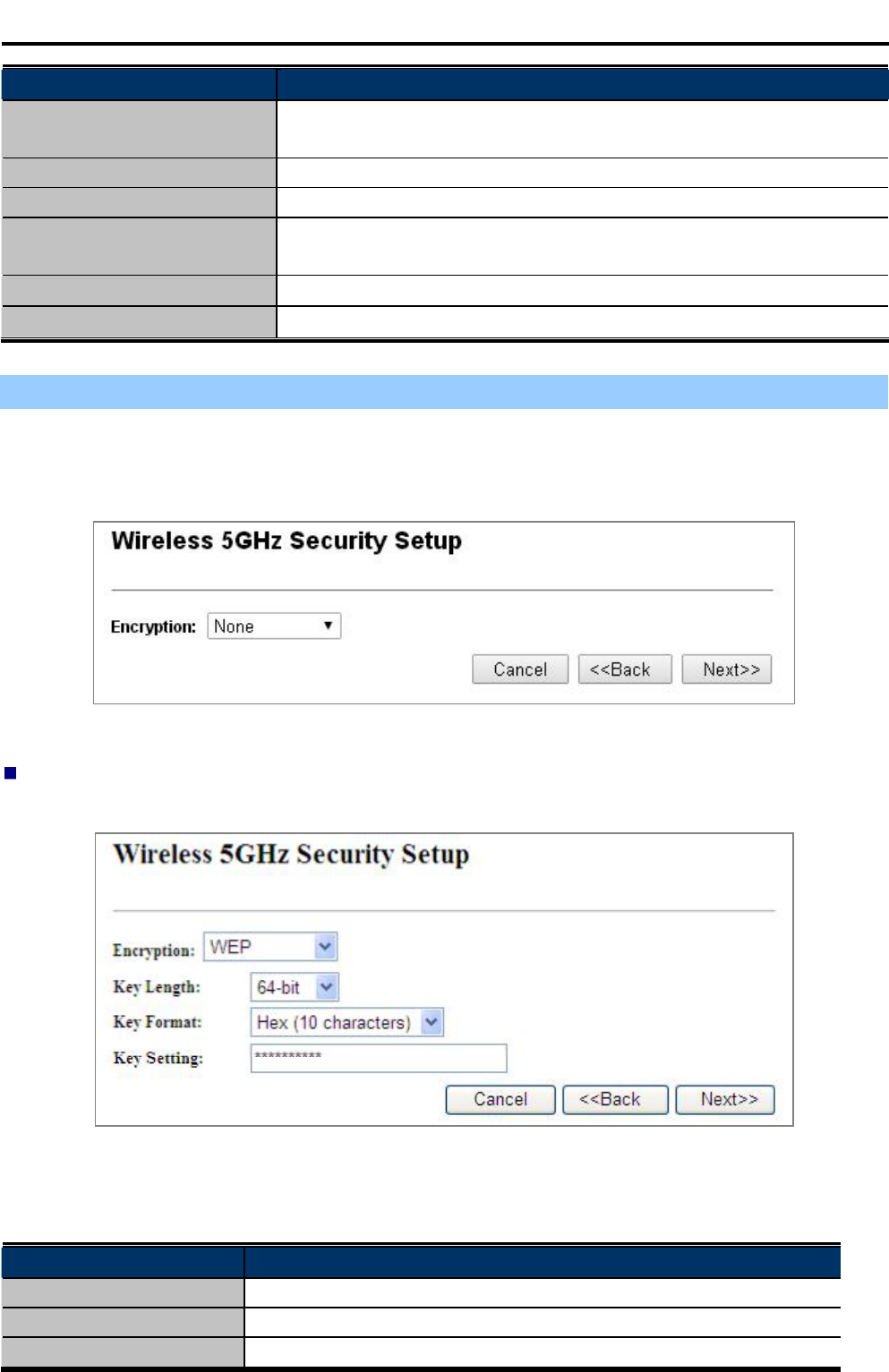
User Manual of WDAP-C7200AC
-23-
Object Description
Band Supports 802.11a, 802.11n, 802.11ac and mixed. Please choose its band
according to your clients.
Mode Supports AP, Client, WDS and AP+WDS mode.
SSID Service Set Identifier identifies your wireless network.
Channel Width Select 80MHz if you use 802.11ac; select 40MHz if you use 802.11n;
otherwise, 20MHz for the 802.11a mode.
Control Sideband It is only valid when you choose channel width 40MHz.
Channel Number Indicates the channel setting for the AP.
Step 4: Wireless 5GHz Security Settings
Secure your wireless network by turning on the WPA or WEP security feature on the router. For this section you
can set WEP and WPA-PSK security mode.
Figure 5-8 Wizard Wireless 5GHz Security Setup
Encryption: WEP
The following picture shows how to set the WEP security.
Figure 5-9 5GHz Wireless Security Setup WEP Setting
The page includes the following fields:
Object Description
Key length WEP supports 64-bit or 128-bit security key.
Key Format User can enter key in ASCII or Hex format.
Key Setting Enter the key whose format is limited by the Key format, ASCII or Hex.
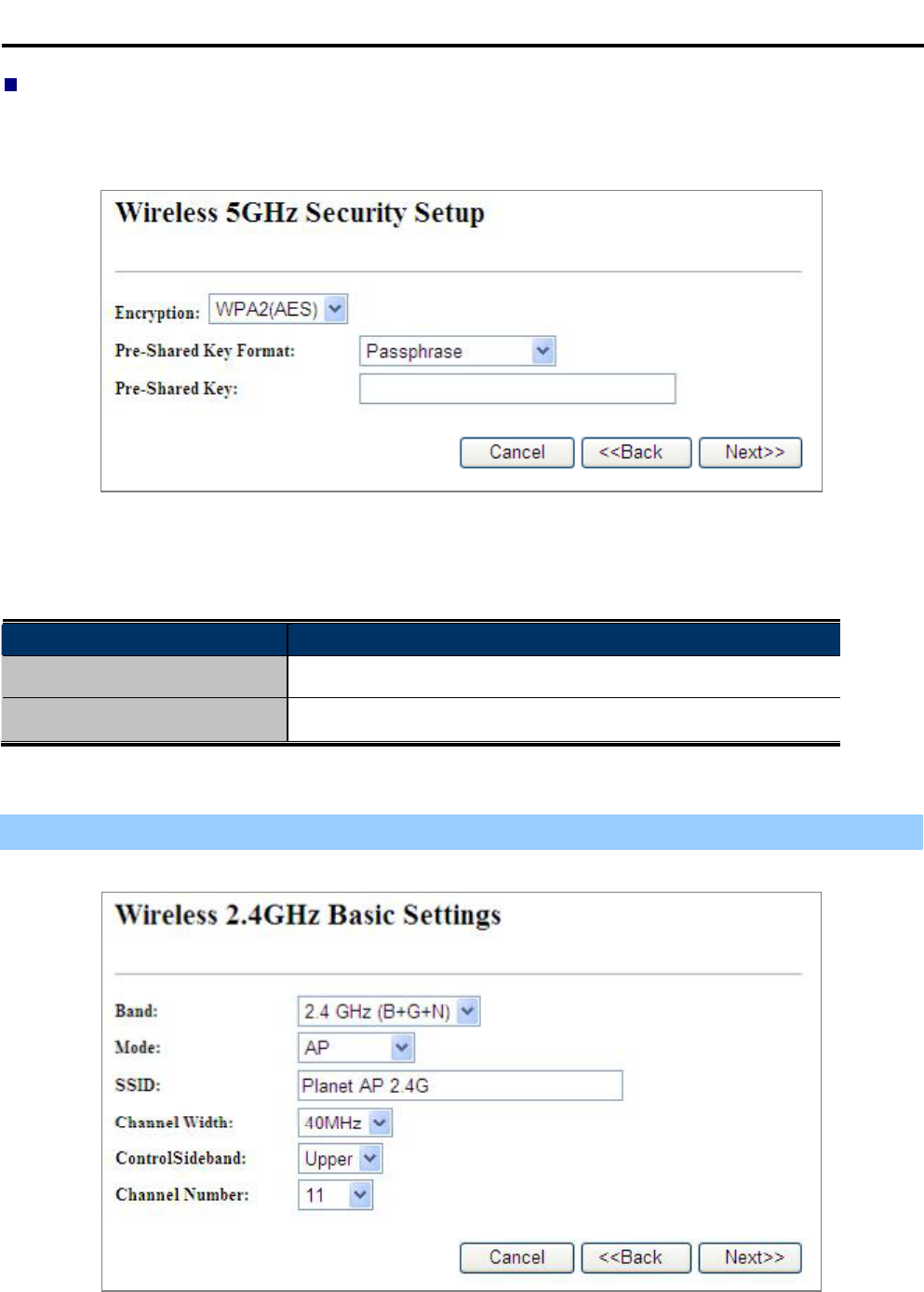
User Manual of WDAP-C7200AC
-24-
Encryption: WPA-PSK
The following picture shows how to set up WPA-PSK security. You can select WPA (TKIP),WPA2 (AES) and
Mixed mode.
Figure 5-10 5GHz Wireless Security Setup WPA Setting
The page includes the following fields:
Object Description
Pre-Shared Key Format Specify the format of the key, pass phrase or hex.
Pre-Shared Key Enter the key whose format is limited by the key format.
Step 5: Wireless 2.4GHz Basic Settings
Figure 5-11 Wizard Wireless 2.4GHz Basic Settings
The page includes the following fields:
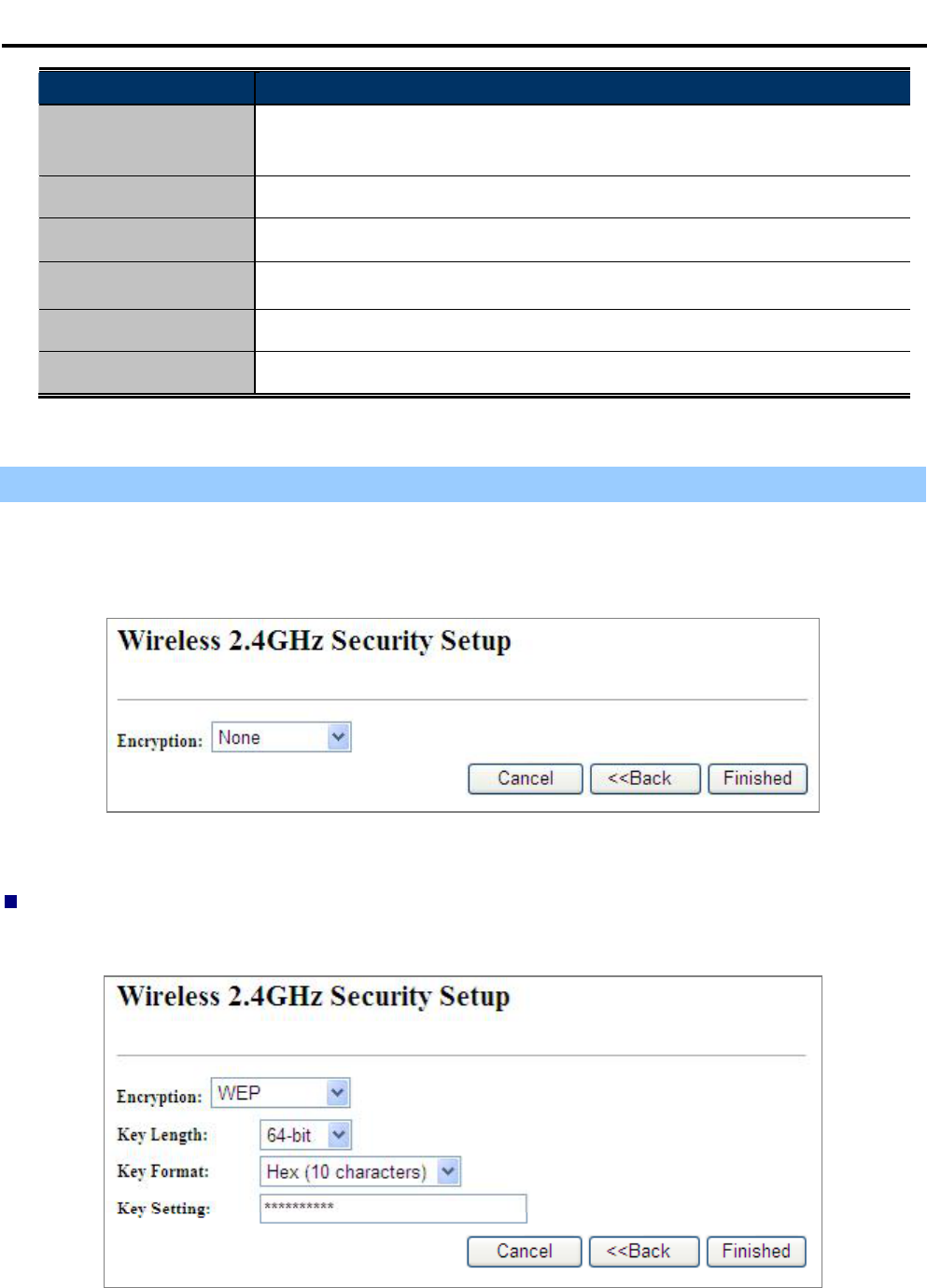
User Manual of WDAP-C7200AC
-25-
Object Description
Band Supports 802.11b, 802.11g, 802.11n and mixed. Please choose its band
according to your clients.
Mode Supports AP, Client, WDS and AP+WDS mode.
SSID Service Set Identifier, it identifies your wireless network.
Channel Width Select 40MHz if you use 802.11n, otherwise 20MHz for the 802.11b/g mode.
Control Sideband It is only valid when you choose channel width 40MHz.
Channel Number Indicates the channel setting for the AP.
Step 6: Wireless 2.4GHz Security Settings
Secure your wireless network by turning on the WPA or WEP security feature on the router. For this section you
can set WEP and WPA-PSK security mode.
Figure 5-12 Wizard Wireless 2.4GHz Security Setup
Encryption: WEP
The following picture shows how to set the WEP security.
Figure 5-13 2.4GHz Wireless Security Setup WEP Setting
The page includes the following fields:
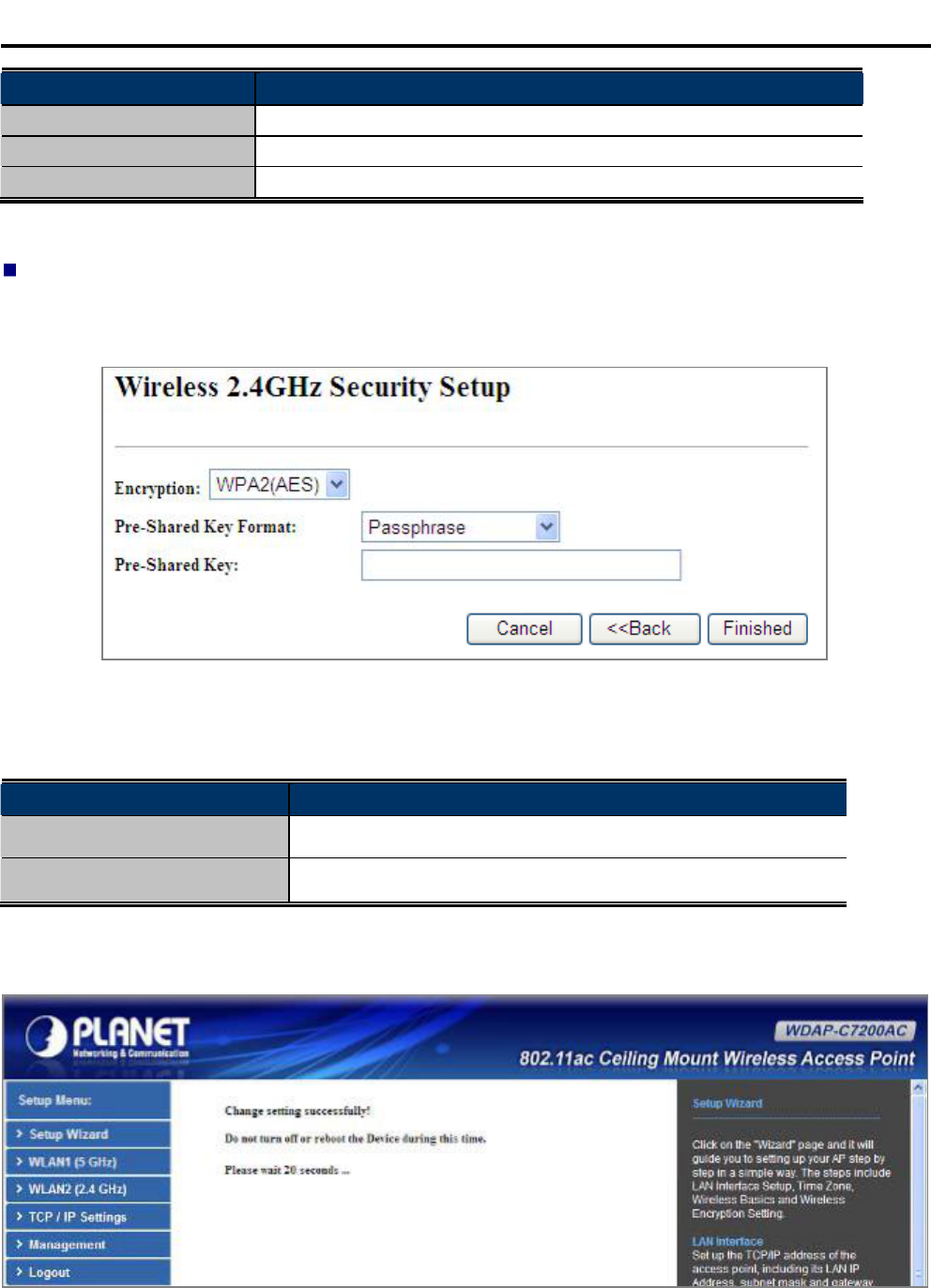
User Manual of WDAP-C7200AC
-26-
Object Description
Key Length WEP supports 64-bit or 128-bit security key.
Key Format User can enter key in ASCII or Hex format.
Key Setting Enter the key whose format is limited by the Key format, ASCII or Hex.
Encryption: WPA-PSK
The following picture shows how to set WPA-PSK security. You can select WPA (TKIP),WPA2 (AES) and
Mixed mode.
Figure 5-14 2.4GHz Wireless Security Setup WPA Setting
The page includes the following fields:
Object Description
Pre-Shared Key Format Specify the format of the key, pass phrase or hex.
Pre-Shared Key Enter the key whose format is limited by the key format.
Click the Finished button to make your wireless configuration to take effect and finish the Setup Wizard.
Figure 5-15 Setup Wizard - Finished
After rebooting, please check whether you can access the Internet or not on the Status page.
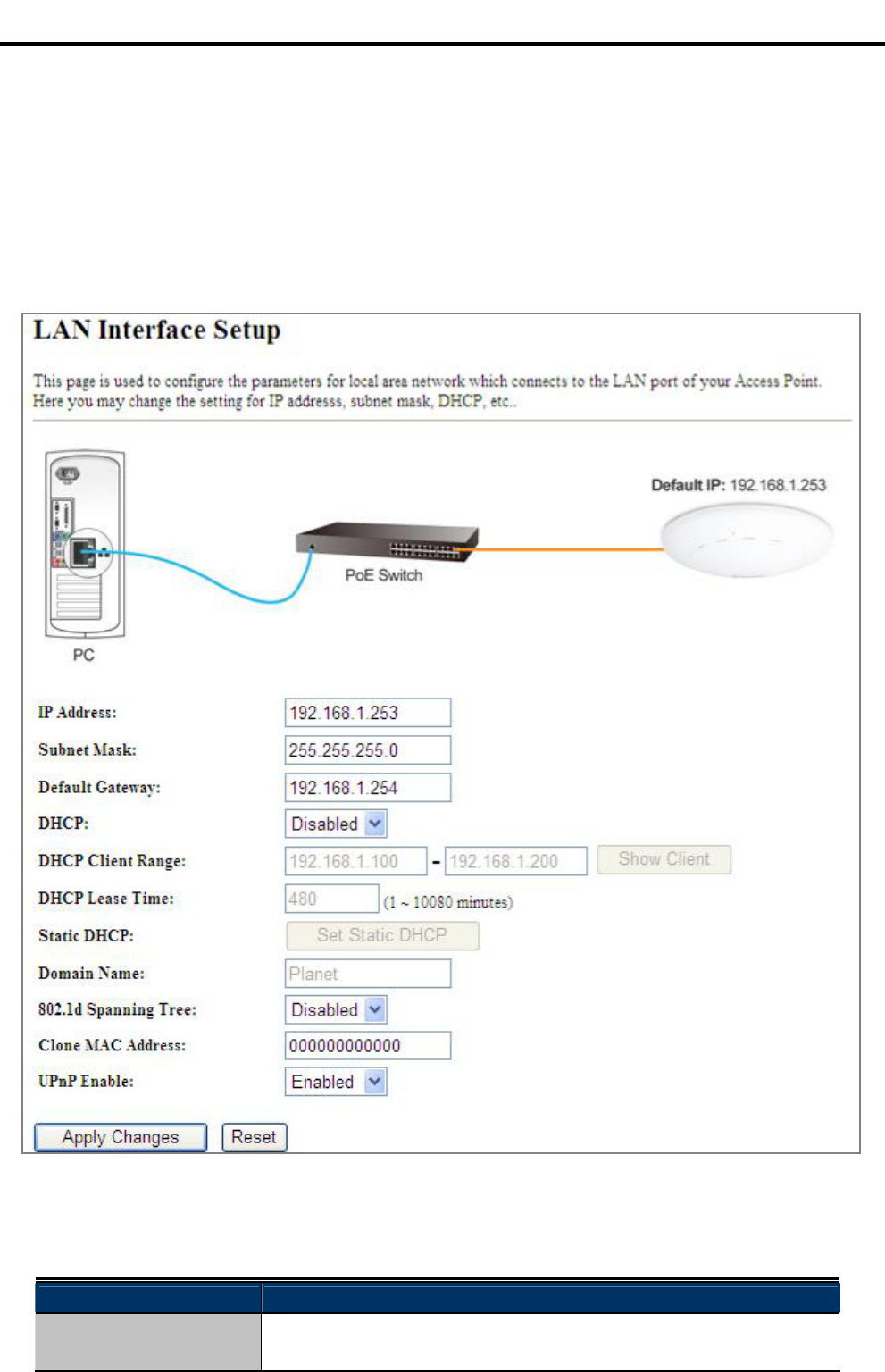
User Manual of WDAP-C7200AC
-27-
5.2 TCP / IP Settings
This page is used to configure the parameters for local area network which connects to the LAN port of your AP.
Here you may change the setting for IP address, subnet mask, DHCP, etc.
5.2.1 LAN Settings
On the LAN Settings page, you can configure the IP parameters of the LAN on the screen as shown below.
Figure 5-16 LAN Setting
The page includes the following fields:
Object Description
IP Address The default LAN IP address of the WDAP-C7200AC is 192.168.1.253.
You can change it according to your request.

User Manual of WDAP-C7200AC
-28-
Subnet Mask Default is 255.255.255.0. You can change it according to your request.
Default Gateway Default is 192.168.1.253. You can change it according to your request.
DHCP You can select a Disabled,Client, and Server. Default is Disabled,
meaning the WDAP-C7200AC must connect to a router to assign IP
addresses to clients.
DHCP Client Range For the Server mode, you must enter the DHCP client IP address
range in the field. And you can click the Show Client button to show
the Active DHCP Client Table.
Static DHCP Click the Set Static DHCP button and you can reserve some IP
addresses for those network devices with the specified MAC
addresses anytime when they request IP addresses.
Domain Name Default is Planet.
802.1d Spanning Tree You can enable or disable the Spanning Tree function.
Clone MAC Address You can input an MAC address here for using clone function.
UPnP Enable You can enable or disable the UPnP function.
The UPnP feature allows the devices, such as Internet computers, to
access the local host resources or devices as needed. UPnP devices
can be automatically discovered by the UPnP service application on
the LAN.
If you change the IP address of LAN, you must use the new IP address to login the
A P.
When the IP address of the WDAP-C7200AC is changed, the clients on the
network often need to wait for a while or even reboot before they can access the
new IP address. For an immediate access to the AP, please flush the netbios
cache on the client computer by running the nbtstat command before using
the device name of the WDAP-C7200AC to access its Web Management page.
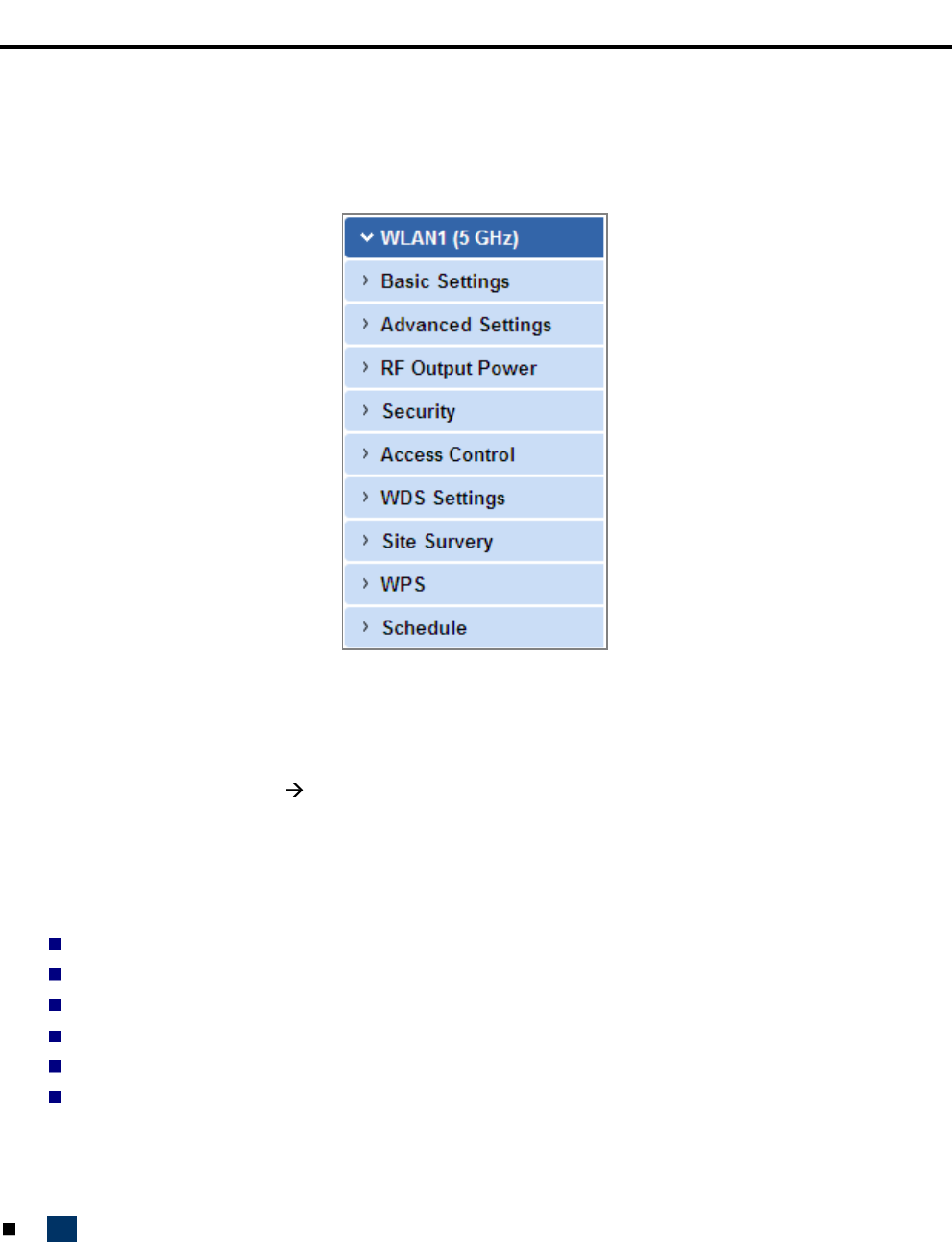
User Manual of WDAP-C7200AC
-29-
5.3 WLAN1 (5GHz)
The wireless menu of WLAN1 (5GHz) contains submenus of the settings about wireless network. Please refer to
the following sections for the details.
Figure 5-17 5GHz Wireless Main Menu
5.3.1 Basic Settings
Choose menu WLAN1 (5GHz) Basic Settings and you can configure the 5GHz basic settings for the
wireless network on this page. After the configuration is done, please click the Apply Changes button to save
the settings.
First of all, the wireless AP supports multiple wireless modes for different network applications, which include:
AP
Multiple SSIDs
Universal Repeater
Client
WDS
AP+WDS
It is so easy to combine the WDAP-C7200AC with the existing wired network. The WDAP-C7200AC definitely
provides a total network solution for the home and the SOHO users.
AP
Standard Access Point
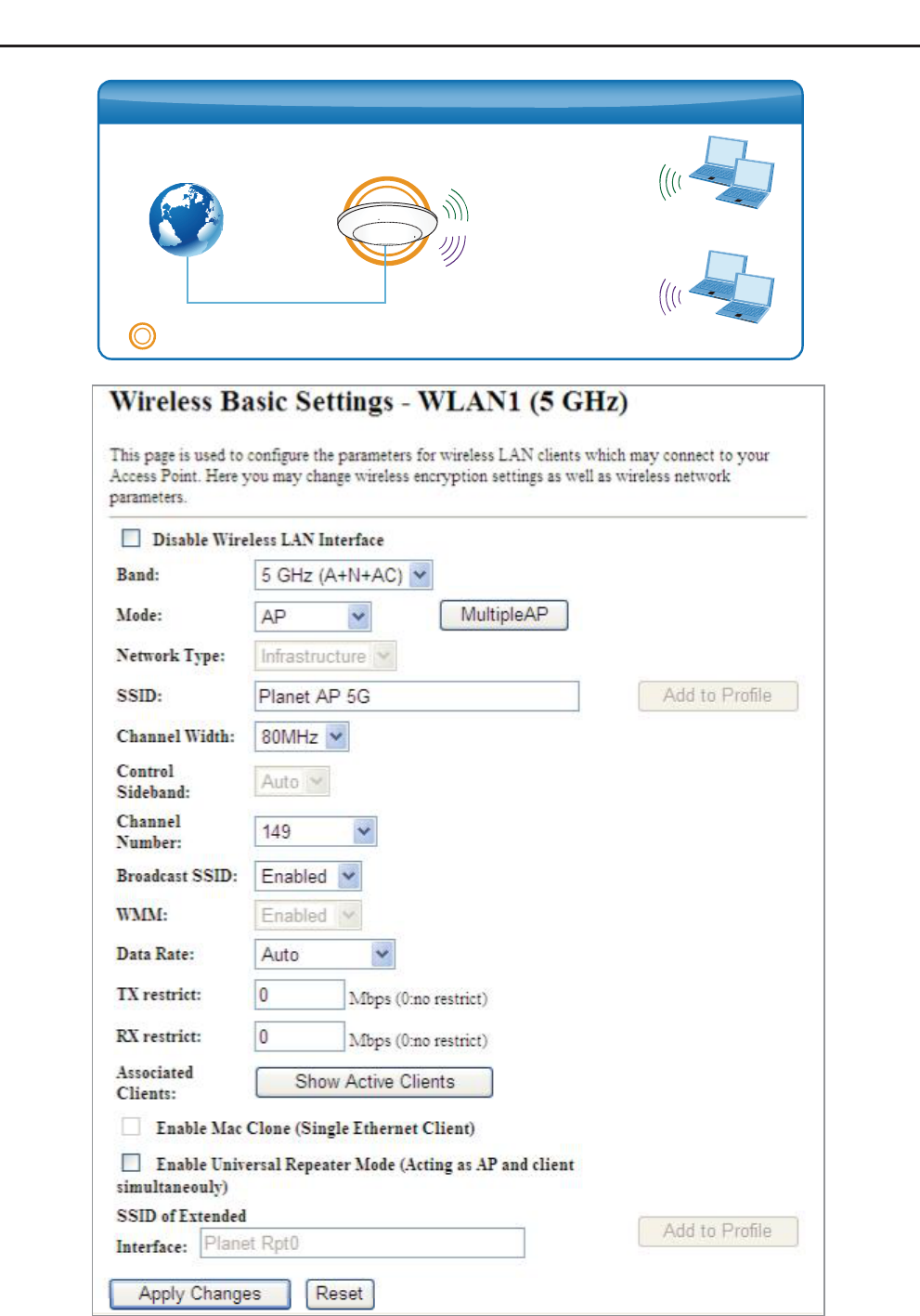
User Manual of WDAP-C7200AC
-30-
Figure 5-18 5GHz Wireless Basic Settings of AP
The page includes the following fields:
AP(Multi-SSID) Mode
Clients
Clients
SSID-1(5G)
SSID-2(2.4G)
Internet WDAP-C7200AC
AP Mode
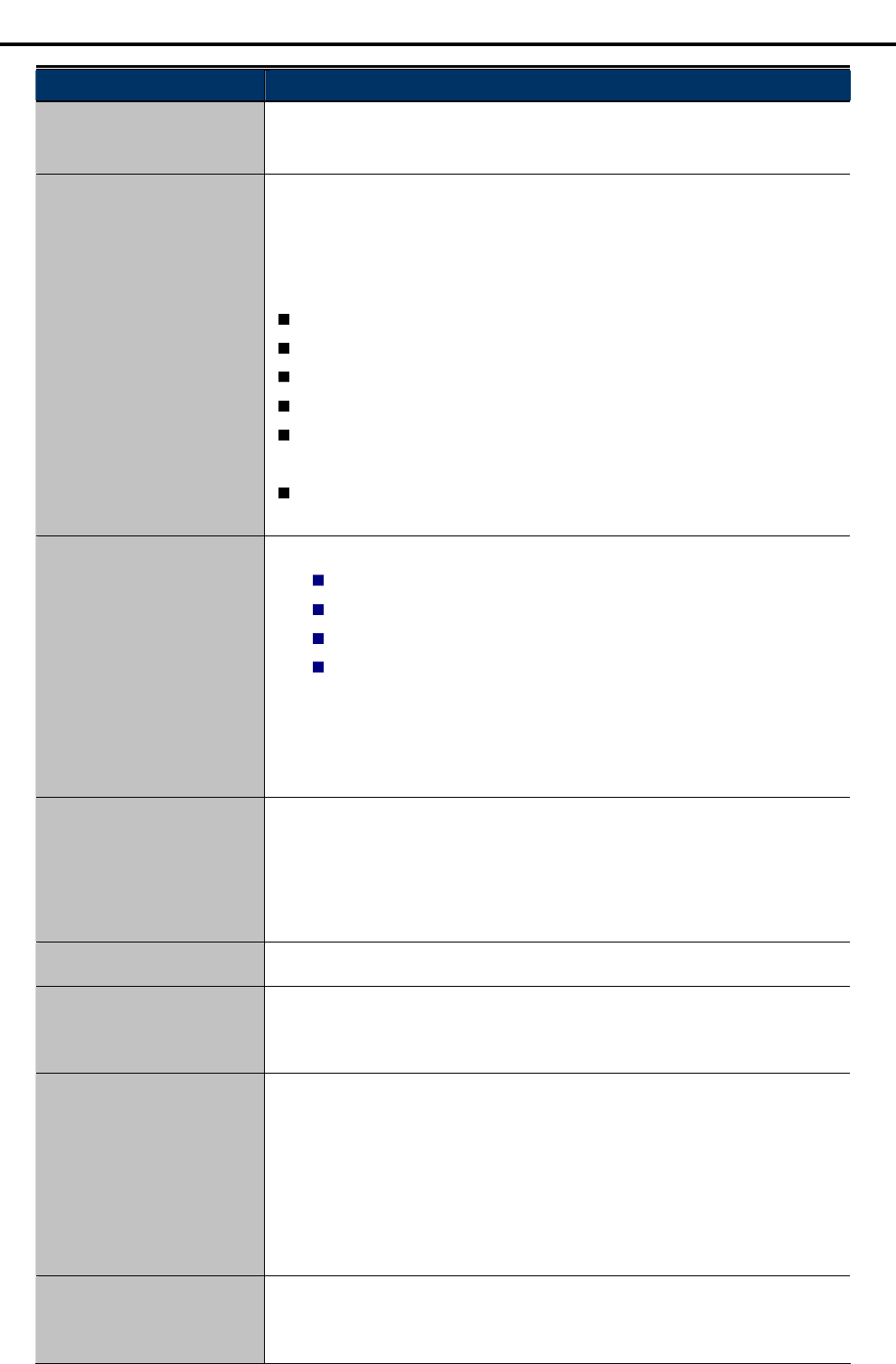
User Manual of WDAP-C7200AC
-31-
Object Description
Disable Wireless LAN
Interface
Check the box to disable the wireless function.
Band Select the desired mode. Default is 5GHz (A+N+AC). It is strongly
recommended that you set the Band to 5GHz (A+N+AC), and all of
802.11a, 802.11n, and 802.11ac wireless stations can connect to the
WDAP-C7200AC.
5 GHz (A): 802.11a mode, rate is up to 54Mbps
5 GHz (N): 802.11n mode, rate is up to 300Mbps
5 GHz (AC): 802.11n mode, rate is up to 867Mbps(2T2R)
5 GHz (A+N): 802.11a/n mode, rate is up to 300Mbps
5 GHz (N+AC): 802.11n/ac mode, rate is up to 300Mbps or
867Mbps
5 GHz (A+N+AC): 802.11a/n/ac mode, rate is up to 54Mbps,
300Mbps, or 867Mbps
Mode There are four kinds of wireless mode selections:
AP
Client
WDS
AP+WDS
If you select WDS or AP+WDS, please click WDS Settings submenu
for the related configuration. Furthermore, click the Multiple AP
button to enable multiple SSID functions.
SSID The ID of the wireless network. User can access the wireless network
through it only. However, if you switch to Client Mode, this field
becomes the SSID of the AP you want to connect with.
Default: Planet AP 5G
Channel Width You can select 20MHz,40MHz or 80MHz.
Channel Number You can select the operating frequency of wireless network.
Default: 149
Broadcast SSID If you enable Broadcast SSID, every wireless station located within
the coverage of the AP can discover its signal easily. If you are building
a public wireless network, enabling this feature is recommended. In
private network, disabling Broadcast SSID can provide better
wireless network security.
Default is Enabled.
Data Rate Set the wireless data transfer rate to a certain value. Since most of
wireless devices will negotiate with each other and pick a proper data
transfer rate automatically, its not necessary to change this value
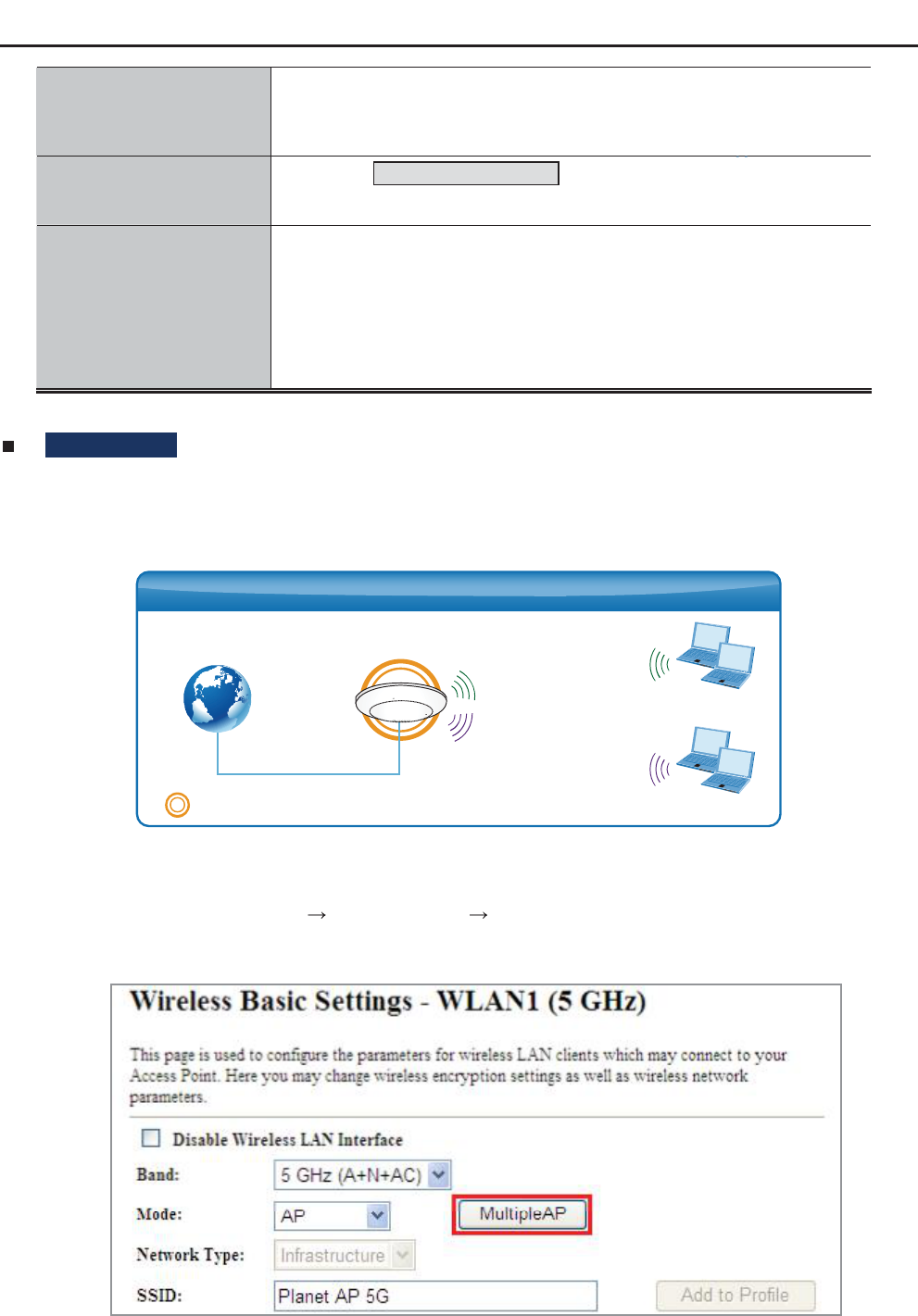
User Manual of WDAP-C7200AC
-32-
unless you know what will happen after modification.
Default is “Auto.
Associated Clients Click the “Show Active Clients” button to show the status table of
active wireless clients.
Enable Universal
Repeater Mode
(Acting as AP and client
simultaneously)
Universal Repeater is a technology used to extend wireless coverage.
To enable Universal Repeater Mode, check the box and enter the
SSID you want to broadcast in the field below. Then please click
“Security” submenu for the related settings of the AP you want to
connect with.
Multiple-SSID
Enable multiple-SSID can broadcast multiple WLAN SSID's using virtual interfaces. You can have different
encryption settings for each WLAN and you can restrict what they have access to.
Choose menu “WLAN1 (5GHz) Basic Settings Multiple AP” to configure the device as a general
wireless access point with multiple SSIDs.
Figure 5-19 5GHz Wireless Basic Settings – Multiple AP
AP(Multi-SSID) Mode
AP(Multi-SSID) Mode
Clients
Clients
SSID-1(5G)
SSID-2(2.4G)
Internet WDAP-C7200AC
AP Mode
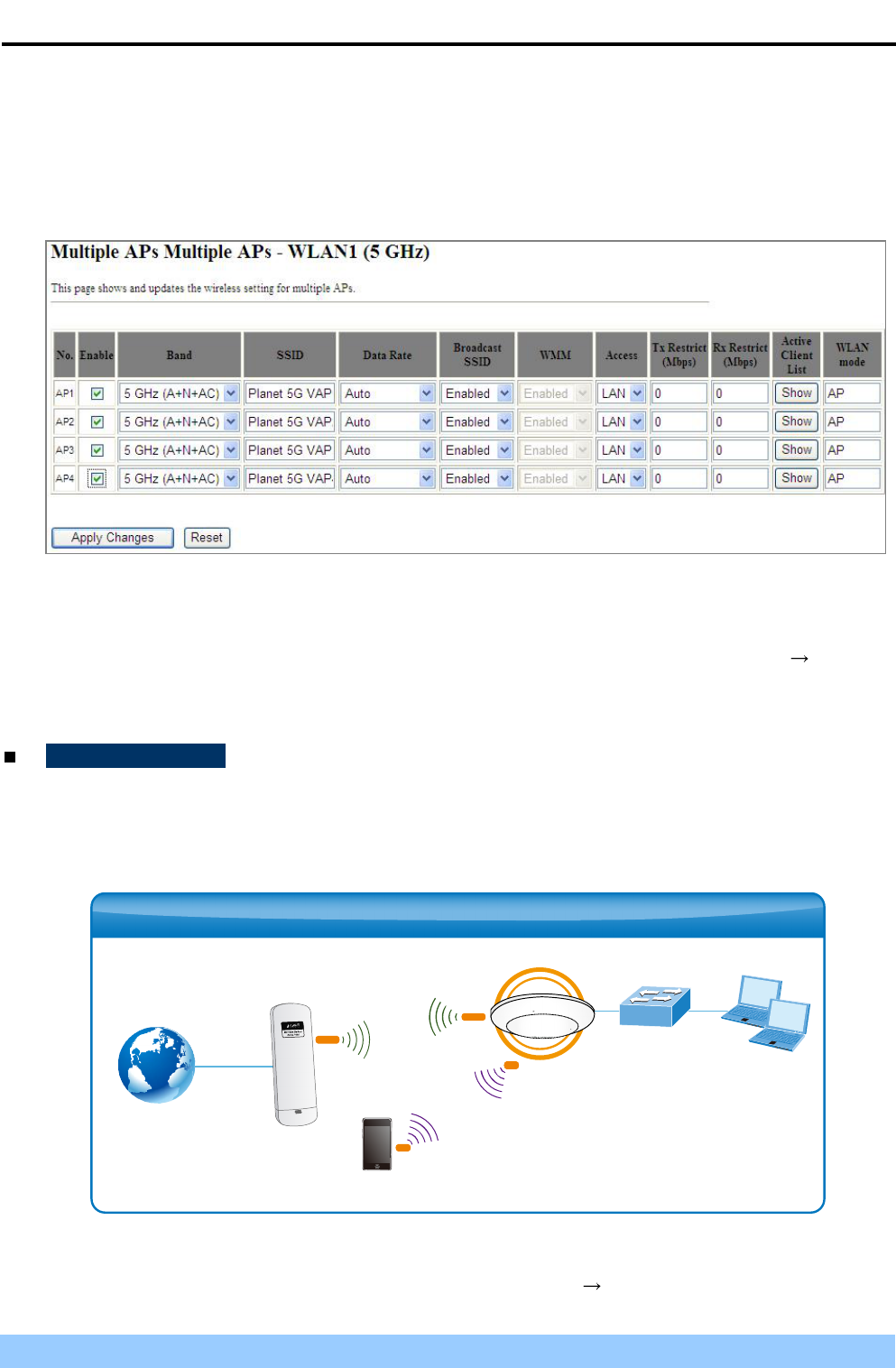
User Manual of WDAP-C7200AC
-33-
The device supports up to four multiple Service Set Identifiers. You can back to the Basic Settings page to
set the Primary SSID. The SSID’s factory default setting is Planet 5G VAP1~4 (Multiple-SSID 1~4). The
SSID can be easily changed to connect to an existing wireless network or to establish a new wireless
network. When the information for the new SSID is finished, click the Apply Changes button to let your
changes take effect.
Figure 5-20 5GHz Multiple-SSID
Once you have applied and saved those settings, you can then go to the “WLAN1 (5GHz) Security”
page on the AP to set up security settings for each of the SSIDs.
Universal Repeater
This mode allows the AP with its own BSS to relay data to a root AP to which it is associated with WDS
disabled. The wireless repeater relays signal between its stations and the root AP for greater wireless
range.
1. Example of how to configure Universal Repeater Mode. Please take the following steps:
To configure each wireless parameter, please go to the “WLAN1 (5GHz) Basic Settings” page.
Step 1. Configure wireless mode to “AP” and then check “Enable Universal Repeater Mode (Acting as AP
2.4G
5G
Clients
Smart Phone
Switch
WDAP-C7200AC
AP
Universal Repeater Mode
Internet
g/n
g/n
a/n/ac
a/n/ac
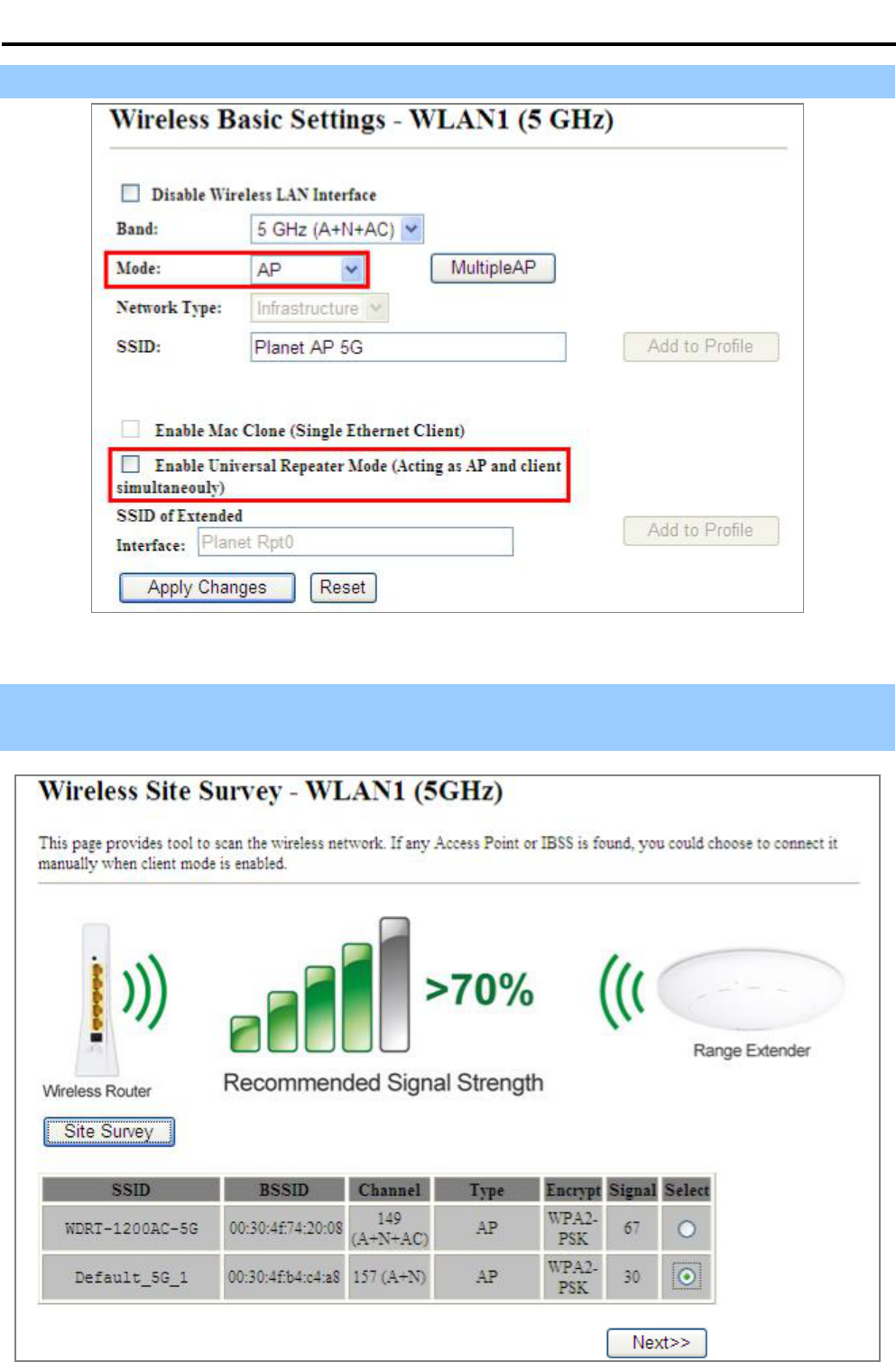
User Manual of WDAP-C7200AC
-34-
and client simultaneously). Click Apply Changes to take effect.
Figure 5-21 5GHz Universal Repeater-1
Step 2. Go to 5GHz Site Survey page to find the root AP. Select the root AP that you want to repeat the signal
and then click Next.
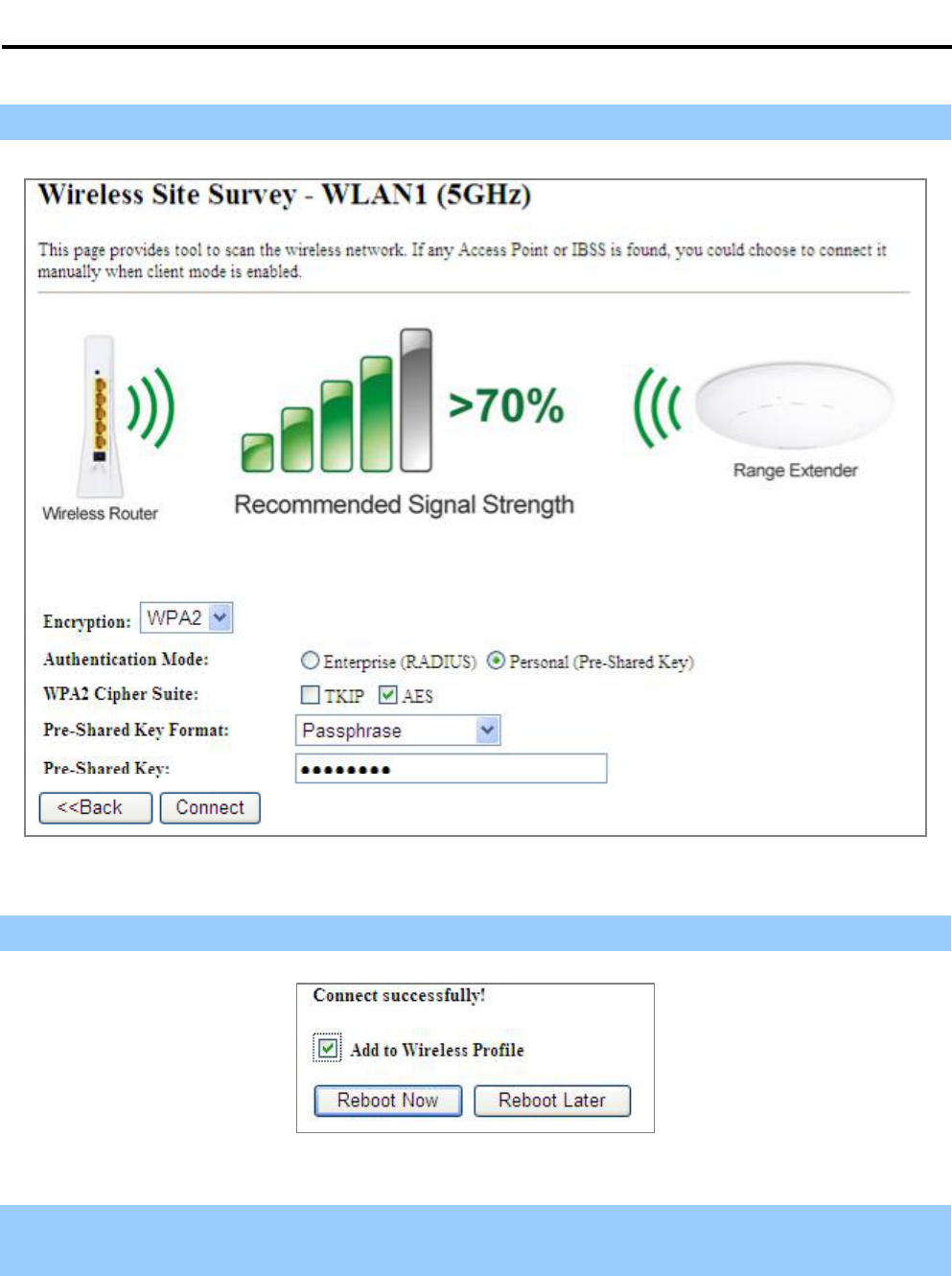
User Manual of WDAP-C7200AC
-35-
Figure 5-22 5GHz Universal Repeater-2
Step 3. Select the correct encryption method and enter the security key. Then, click Connect.
Figure 5-23 5GHz Universal Repeater-3
Step 4. Check Add to Wireless Profile and click Reboot Now.
Figure 5-24 5GHz Universal Repeater-4
Step 5. Go to Management-> Status page to check whether the state of Repeater interface should be
Connected.
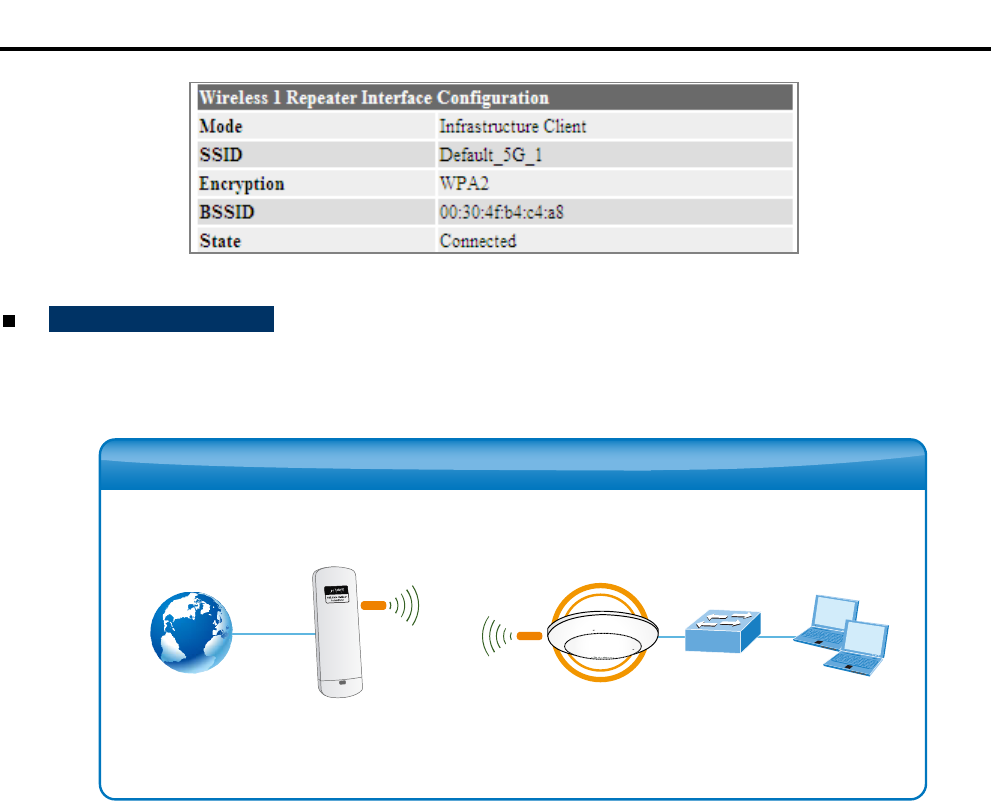
User Manual of WDAP-C7200AC
-36-
Figure 5-25 5GHz Universal Repeater-5
Client (Infrastructure)
Combine the Wireless Router to the Ethernet devices such as TV, game player, or HDD and DVD, to make
them be wireless stations.
5G
Clients
Switch
WDAP-C7200AC
AP
Station (Client Mode)
Internet
a/n /ac
a/n /ac
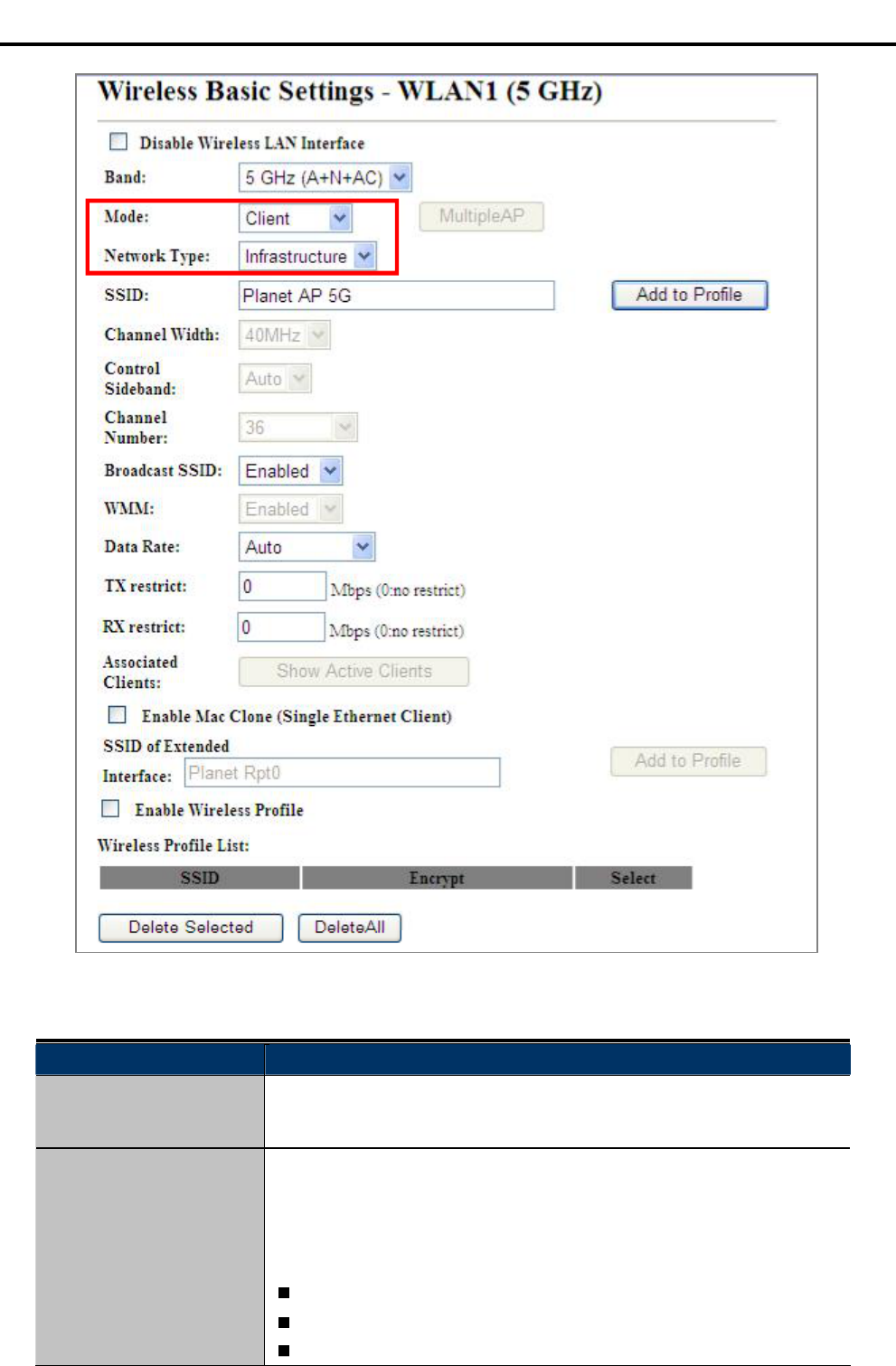
User Manual of WDAP-C7200AC
-37-
Figure 5-26 5GHz Wireless Basic Settings Client
The page includes the following fields:
Object Description
Disable Wireless LAN
Interface
Check the box to disable the wireless function.
Band Select the desired mode. Default is 5GHz (A+N+AC). It is strongly
recommended that you set the Band to 5GHz (A+N+AC), and all of
802.11a, 802.11n, and 802.11ac wireless stations can connect to the
WDAP-C7200AC.
5 GHz (A): 802.11a mode, rate is up to 54Mbps
5 GHz (N): 802.11n mode, rate is up to 300Mbps
5 GHz (AC): 802.11n mode, rate is up to 867Mbps(2T2R)

User Manual of WDAP-C7200AC
-38-
5 GHz (A+N): 802.11a/n mode, rate is up to 300Mbps
5 GHz (N+AC): 802.11n/ac mode, rate is up to 300Mbps or
867Mbps
5 GHz (A+N+AC): 802.11a/n/ac mode, rate is up to 54Mbps,
300Mbps, or 867Mbps
Mode There are four kinds of wireless mode selections:
AP
Client
WDS
AP+WDS
If you select WDS or AP+WDS, please click WDS Settings submenu
for the related configuration. Furthermore, click the Multiple AP
button to enable multiple SSID function.
Network Type In Infrastructure, the wireless LAN serves as a wireless station. And
the user can use the PC equipped with the WDAP-C7200AC to access
the wireless network via other access points. In Ad hoc, the wireless
LAN will use the Ad-hoc mode to operate.
Default is Infrastructure.
Note: Only while the wireless mode is set to Client, then the
Network Type can be configured.
SSID The ID of the wireless network. User can access the wireless network
via its ID. However, if you switch to Client mode, this field becomes the
SSID of the AP you want to connect with.
Default: Planet AP 5G
Broadcast SSID If you enable Broadcast SSID, every wireless station located within
the coverage of the WDAP-C7200AC can discover its signal easily. If
you are building a public wireless network, enabling this feature is
recommended. In private network, disabling Broadcast SSID can
provide better wireless network security.
Default is Enabled.
Data Rate Set the wireless data transfer rate to a certain value. Since most of
wireless devices will negotiate with each other and pick a proper data
transfer rate automatically, its not necessary to change this value
unless you know what will happen after modification.
Default is Auto.
Enable Mac Clone
(Single Ethernet Client)
Enable Mac Clone.
Example of how to configure Client Mode. Please take the following steps:
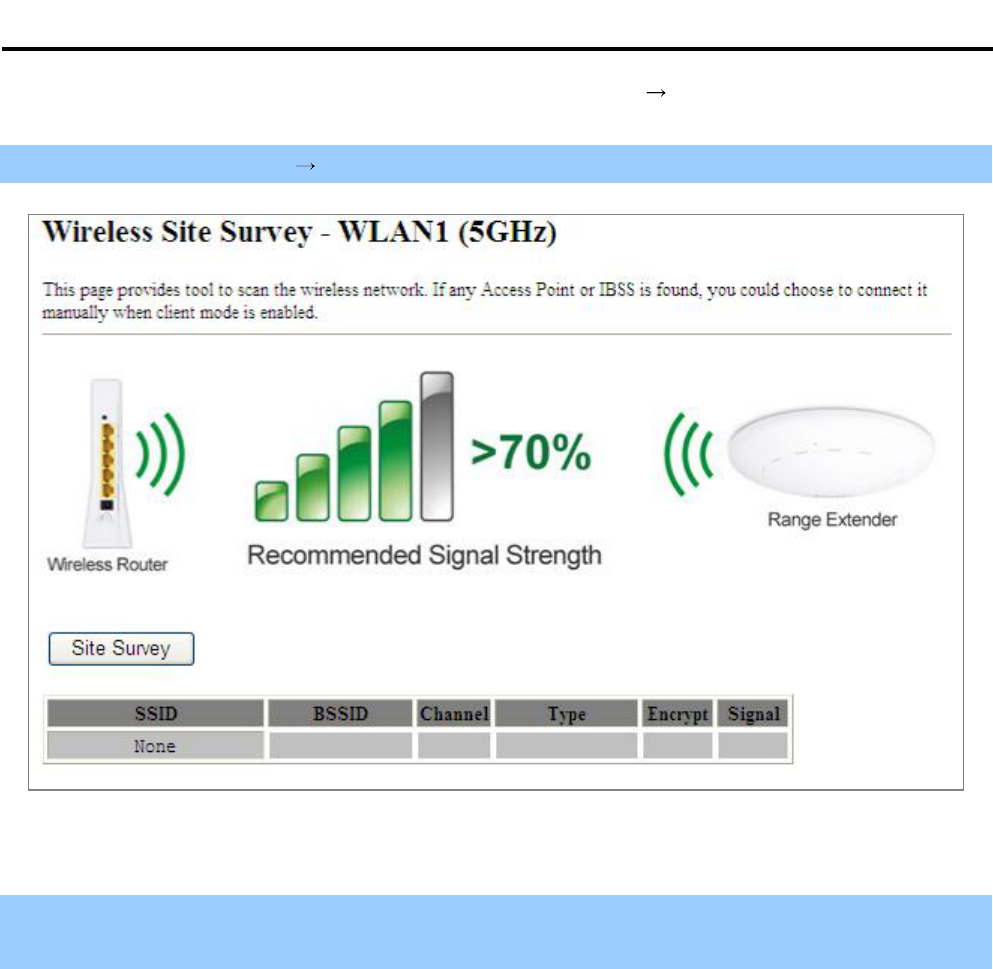
User Manual of WDAP-C7200AC
-39-
To configure each wireless parameter, please go to the WLAN1 (5GHz) Basic Settings page.
Step 1. Go to WLAN1 (5GHz) Site Survey page and click Site Survey button.
Figure 5-27 Client Survey
Step 2. Choose the root AP from the list. If the root AP is not listed in the table, re-click Site Survey to update
the list.
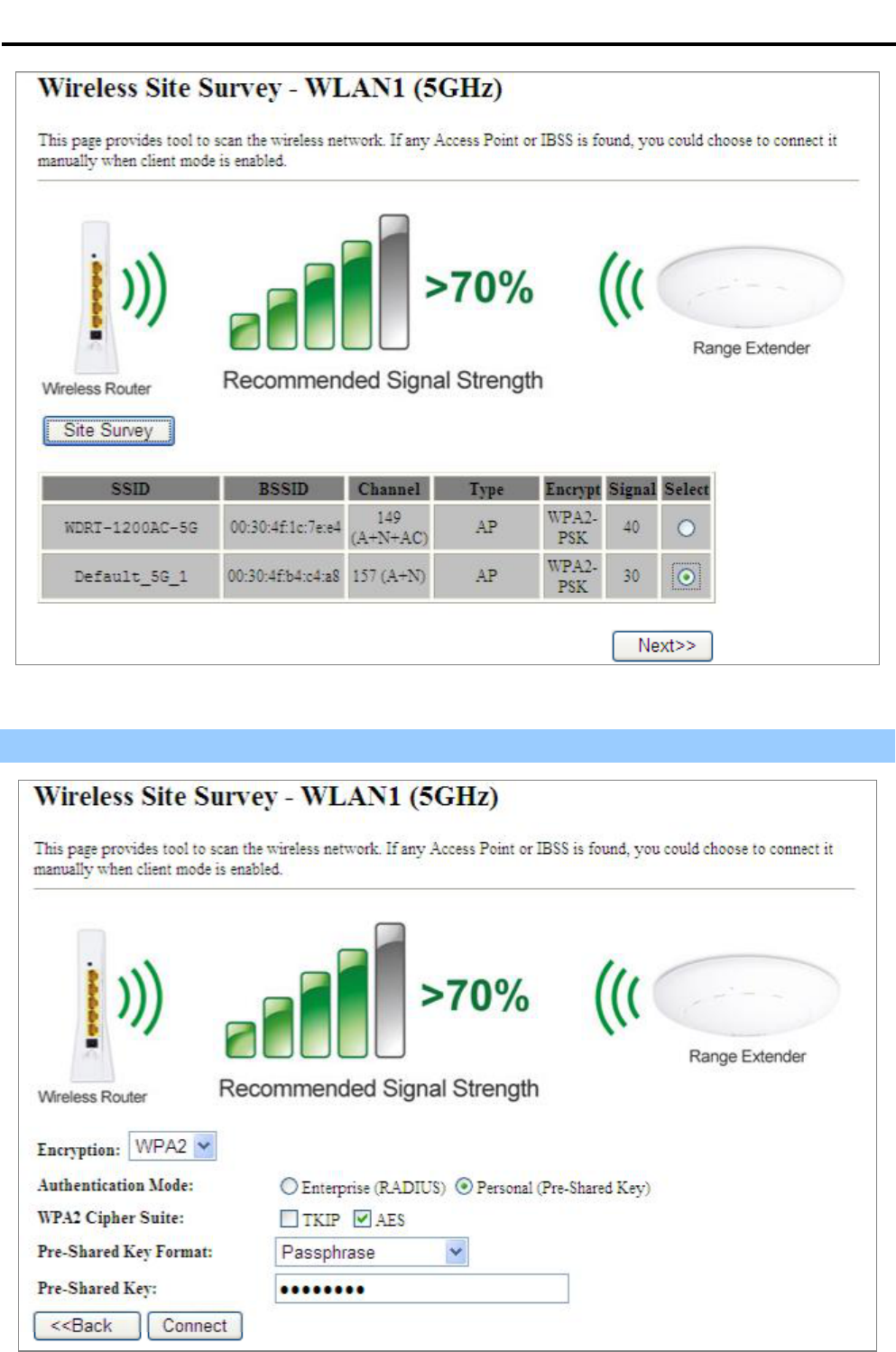
User Manual of WDAP-C7200AC
-40-
Figure 5-28 Client AP List
Step 3. Enter the Security Key of the root AP and then click Connect.
Figure 5-29 Client Security
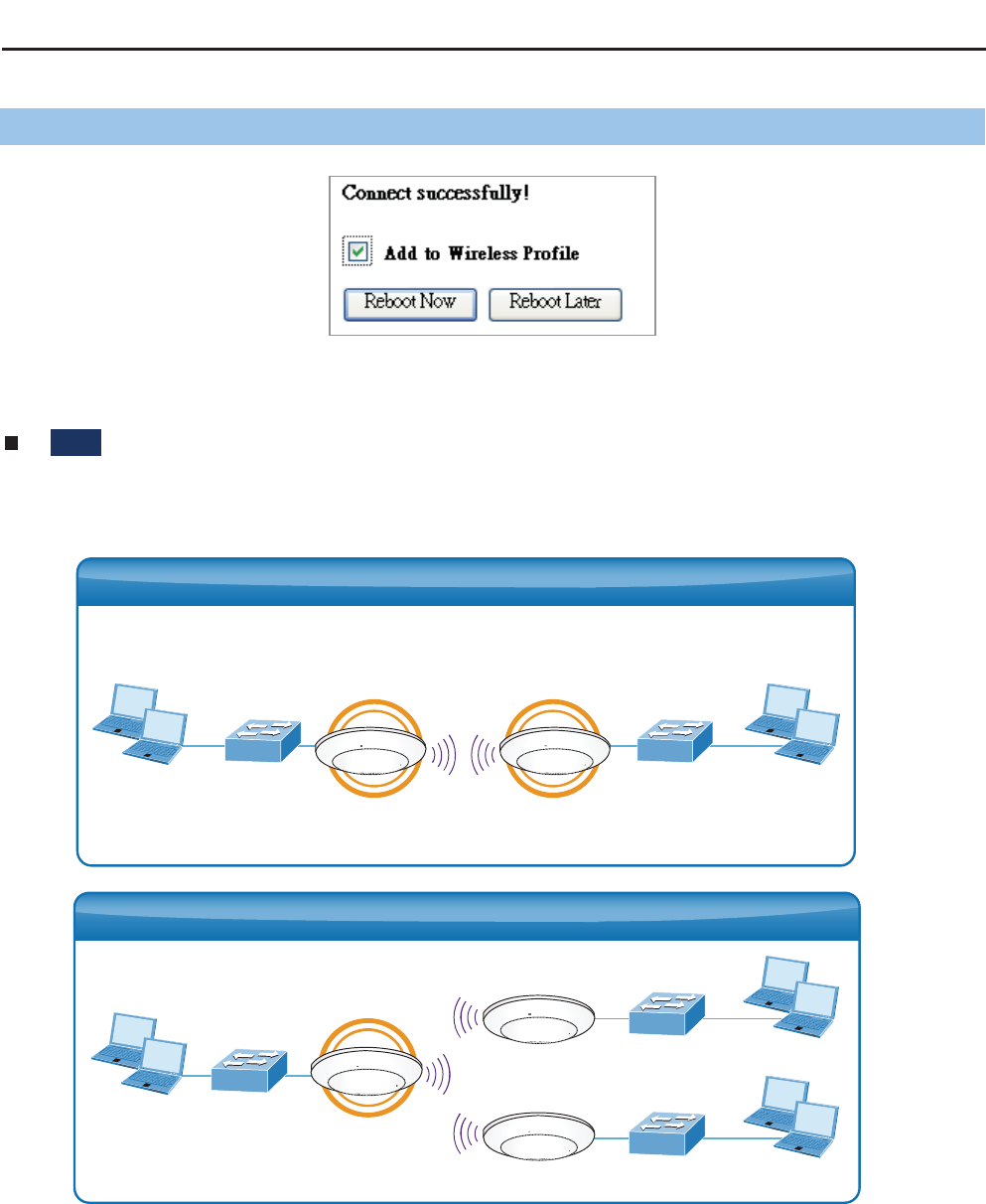
User Manual of WDAP-C7200AC
-41-
Step 4. Wait until the connection established. Check the “Add to Wireless Profile” option and then reboot it.
Figure 5-30 Client – Status
WDS
Connect this Wireless AP with up to 8 WDS-capable wireless APs to expand the scope of network.
AP ClientsSwitch
ClientsSwitch
Clients Switch
WDAP-C7200AC
AP
WDS Bridge-PtMP Mode
Clients ClientsSwitch Switch
WDAP-C7200AC WDAP-C7200AC
WDS Bridge-PtP Mode
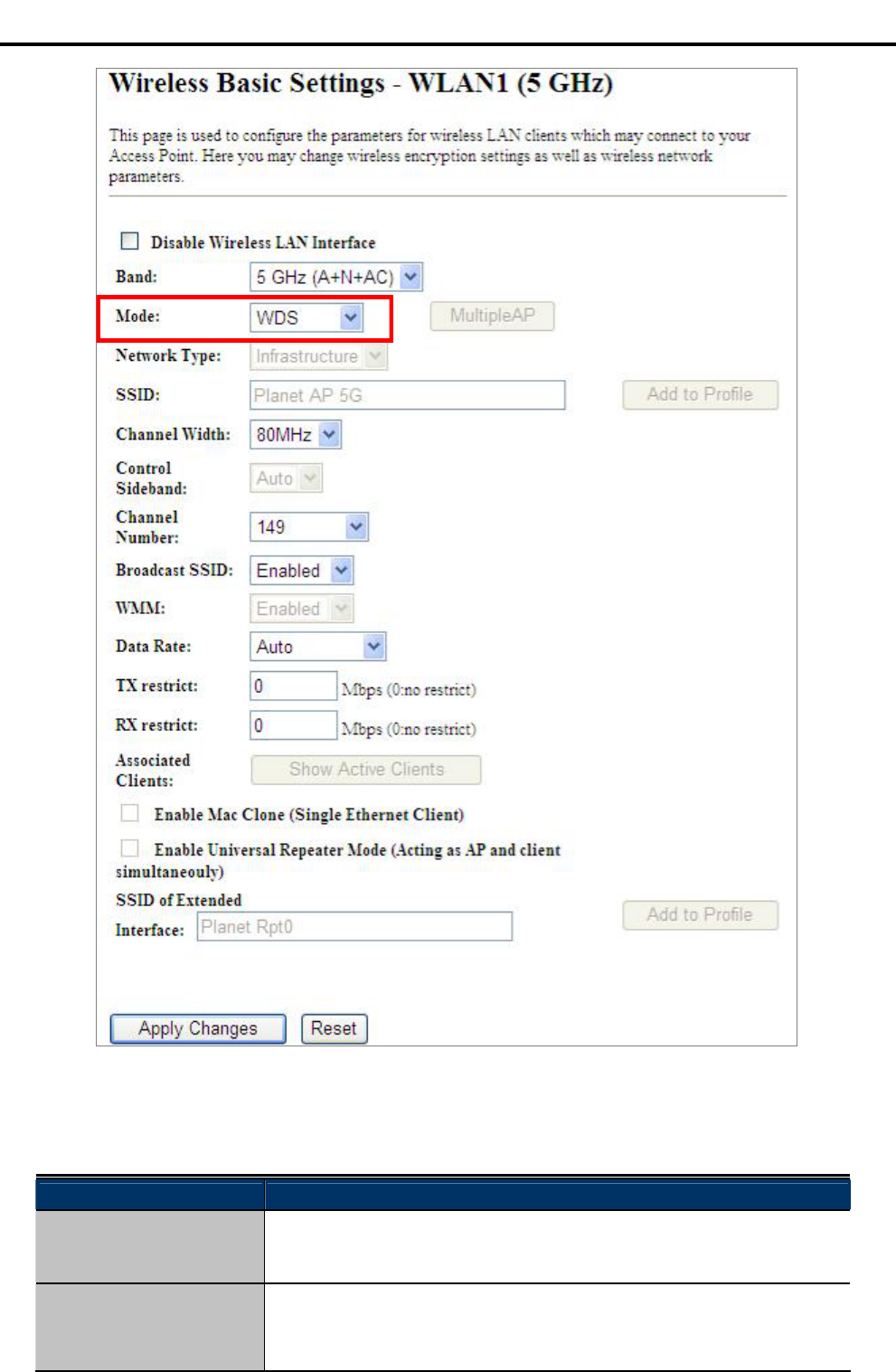
User Manual of WDAP-C7200AC
-42-
Figure 5-31 5GHz Wireless Basic Settings WDS
The page includes the following fields:
Object Description
Disable Wireless LAN
Interface
Check the box to disable the wireless function.
Band Select the desired mode. Default is 5GHz (A+N+AC). It is strongly
recommended that you set the Band to 5GHz (A+N+AC), and all of
802.11a, 802.11n, and 802.11ac wireless stations can connect to the

User Manual of WDAP-C7200AC
-43-
WDAP-C7200AC.
5 GHz (A): 802.11a mode, rate is up to 54Mbps
5 GHz (N): 802.11n mode, rate is up to 300Mbps
5 GHz (AC): 802.11n mode, rate is up to 867Mbps(2T2R)
5 GHz (A+N): 802.11a/n mode, rate is up to 300Mbps
5 GHz (N+AC): 802.11n/ac mode, rate is up to 300Mbps or
867Mbps
5 GHz (A+N+AC): 802.11a/n/ac mode, rate is up to 54Mbps,
300Mbps, or 867Mbps
Mode There are four kinds of wireless mode selections:
AP
Client
WDS
AP+WDS
If you select WDS or AP+WDS, please click WDS Settings submenu
for the related configuration. Furthermore, click the Multiple AP
button to enable multiple SSID function.
Channel Width You can select 20MHz,40MHz or 80MHz.
Control Sideband You can select Upper or Lower.
Channel Number You can select the operating frequency of wireless network.
Data Rate Set the wireless data transfer rate to a certain value. Since most of
wireless devices will negotiate with each other and pick a proper data
transfer rate automatically, its not necessary to change this value
unless you know what will happen after modification.
Default is Auto.
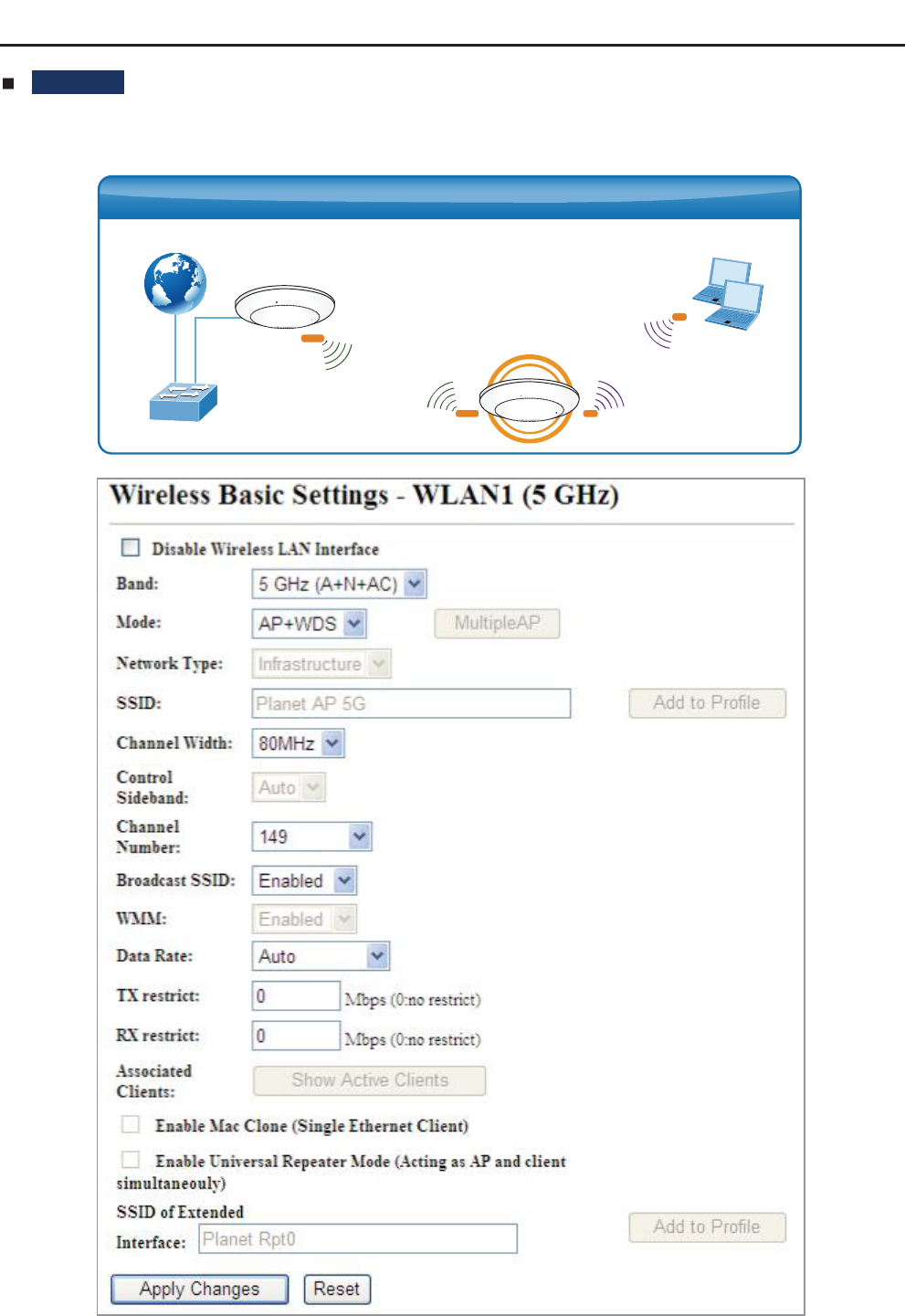
User Manual of WDAP-C7200AC
-44-
AP+ WDS
Connect this wireless AP with up to 8 WDS-capable wireless APs, and connect another AP to provide
service for all wireless stations within its coverage.
Figure 5-32 5GHz Wireless Basic Settings – WDS+AP
Switch
WDS Repeater Mode
Clients
5G WDS 2.4G
AP
Internet
WDAP-C7200AC
g/n
g/n
a/n/ac
a/n/ac
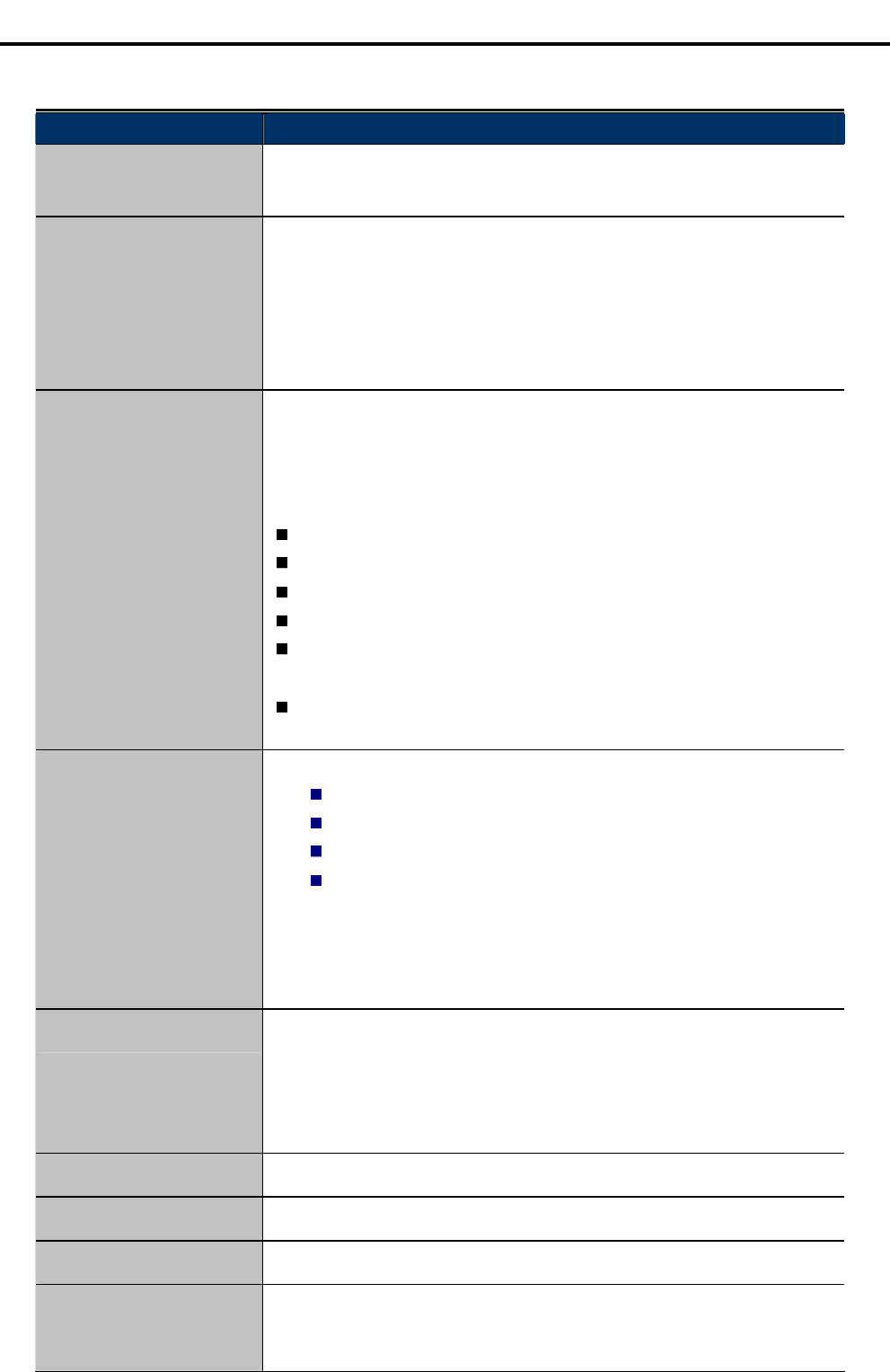
User Manual of WDAP-C7200AC
-45-
The page includes the following fields:
Object Description
Disable Wireless LAN
Interface
Check the box to disable the wireless function.
Country Select your region from the pull-down list.
This field specifies the region where the wireless function of the Router
can be used. It may be illegal to use the wireless function of the Router
in a region other than one of those specified in this field. If your country
or region is not listed, please contact your local government agency for
assistance.
Band Select the desired mode. Default is 5GHz (A+N+AC). It is strongly
recommended that you set the band to 5GHz (A+N+AC), and all of
802.11a, 802.11n, and 802.11ac wireless stations can connect to the
WDAP-C7200AC.
5 GHz (A): 802.11a mode, rate is up to 54Mbps
5 GHz (N): 802.11n mode, rate is up to 300Mbps
5 GHz (AC): 802.11n mode, rate is up to 867Mbps(2T2R)
5 GHz (A+N): 802.11a/n mode, rate is up to 300Mbps
5 GHz (N+AC): 802.11n/ac mode, rate is up to 300Mbps or
867Mbps
5 GHz (A+N+AC): 802.11a/n/ac mode, rate is up to 54Mbps,
300Mbps, or 867Mbps
Mode There are four kinds of wireless mode selections:
AP
Client
WDS
AP+WDS
If you select WDS or AP+WDS, please click WDS Settings submenu
for the related configuration. Furthermore, click the Multiple AP
button to enable multiple SSID functions.
SSID The ID of the wireless network. User can access the wireless network
via its ID only. However, if you switch to Client Mode, this field
becomes the SSID of the AP you want to connect with.
Default: Planet AP 5G
Channel Width You can select 20MHz,40MHz or 80MHz.
Control Sideband You can select Upper or Lower.
Channel Number You can select the operating frequency of wireless network.
Broadcast SSID If you enable Broadcast SSID, every wireless station located within
the coverage of the WDAP-C7200AC can discover its signal easily. If
you are building a public wireless network, enabling this feature is
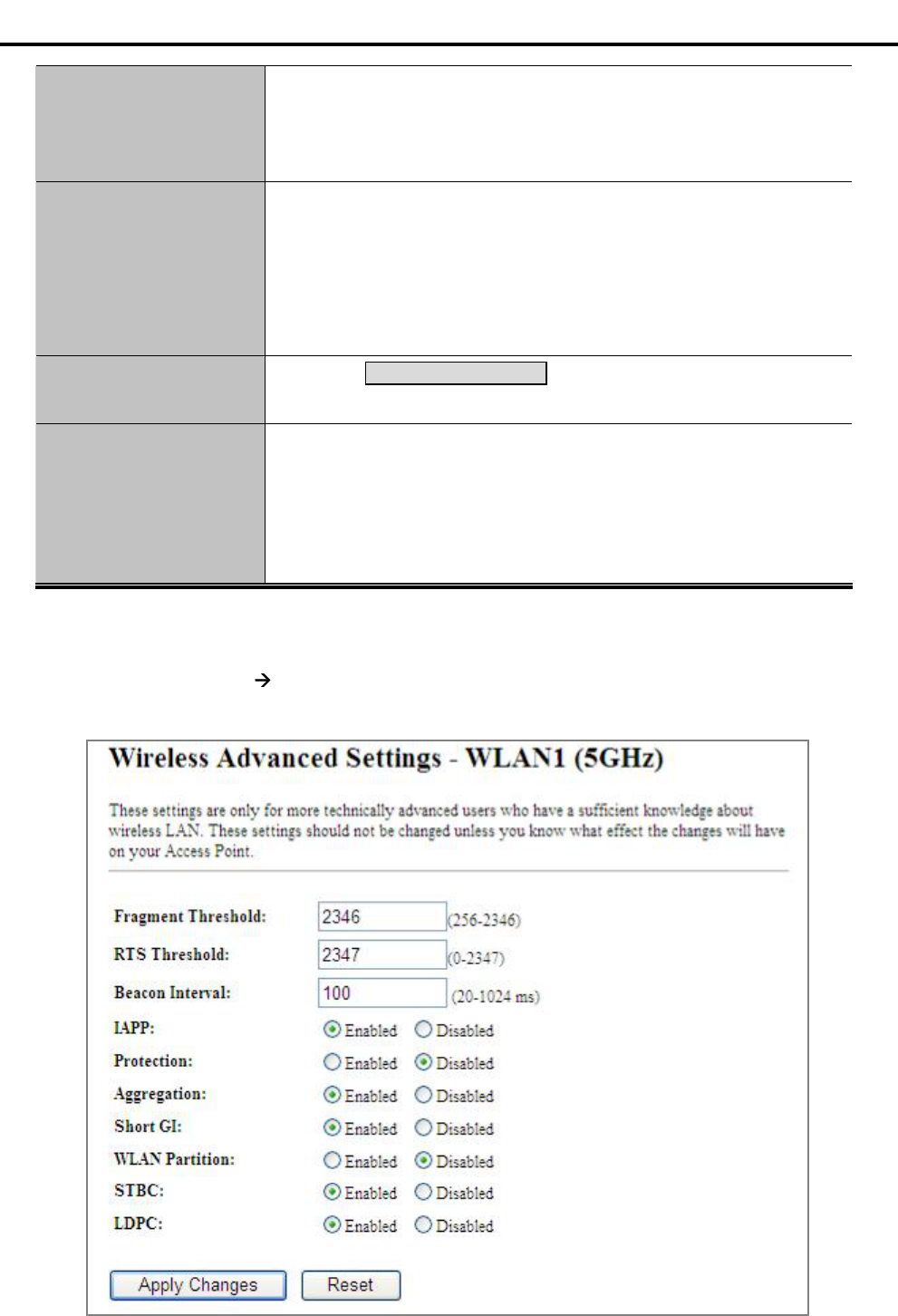
User Manual of WDAP-C7200AC
-46-
recommended. In private network, disabling Broadcast SSID can
provide better wireless network security.
Default is Enabled.
Data Rate Set the wireless data transfer rate to a certain value. Since most of
wireless devices will negotiate with each other and pick a proper data
transfer rate automatically, its not necessary to change this value
unless you know what will happen after modification.
Default is Auto.
Associated Clients Click the Show Active Clients button to show the status table of
active wireless clients.
Enable Universal
Repeater Mode
(Acting as AP and client
simultaneously)
Universal Repeater is a technology used to extend wireless coverage.
To enable Universal Repeater mode, check the box and enter the
SSID you want to broadcast in the field below. Then please click
Security submenu for the related settings of the AP you want to
connect with.
5.3.2 Advanced Settings
Choose menu WLAN1 (5GHz) Advanced Settings and you can configure the 5GHz advanced settings for
the wireless network on this page. After the configuration, please click the Apply button to save the settings.
Figure 5-33 Wireless Advanced Settings 5GHz
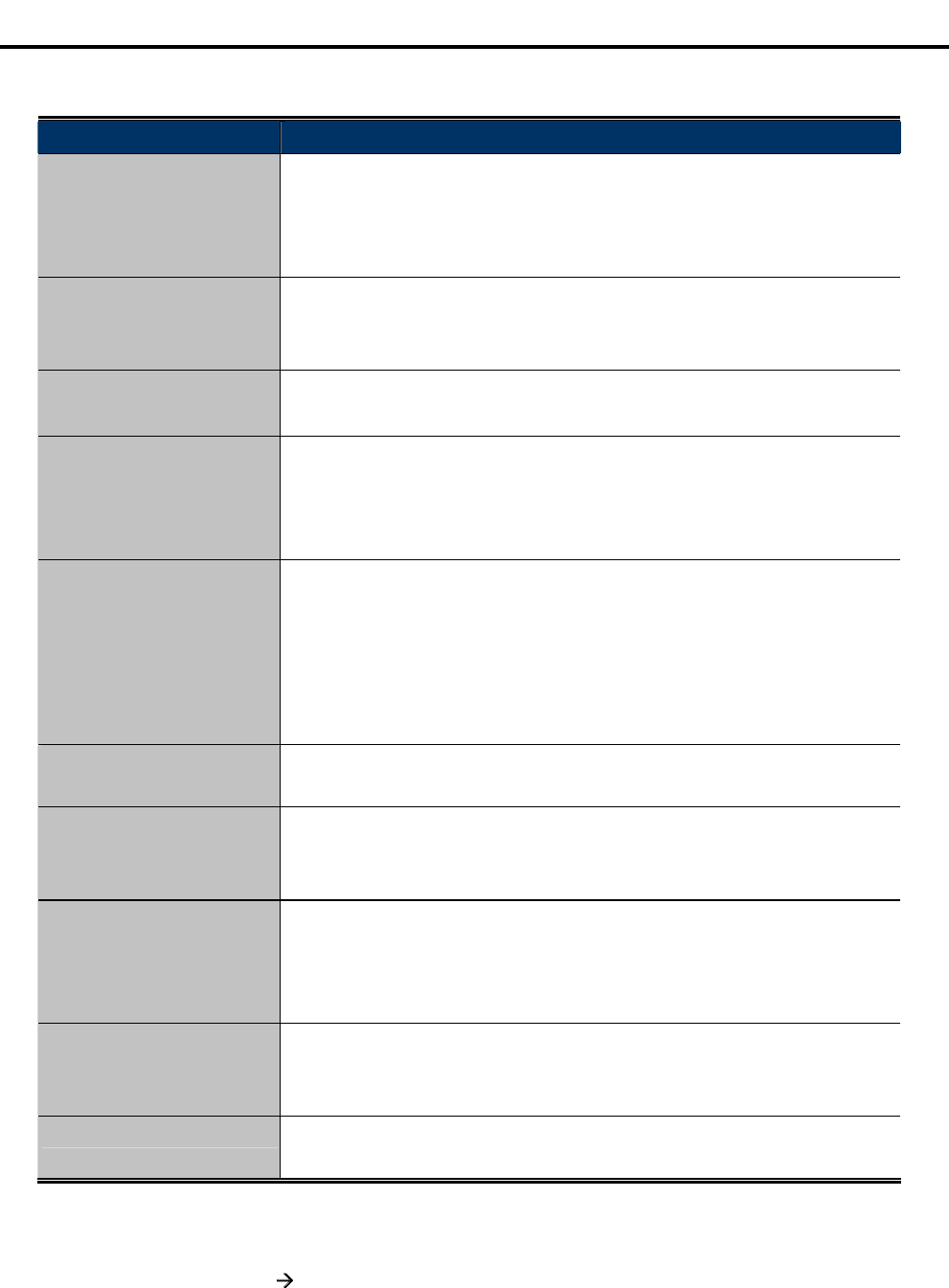
User Manual of WDAP-C7200AC
-47-
The page includes the following fields:
Object Description
Fragment Threshold You can specify the maximum size of packet during the fragmentation
of data to be transmitted. If you set this value too low, it will result in
bad performance.
Default is 2346.
RTS Threshold When the packet size is smaller than the RTS threshold, the access
point will not use the RTS/CTS mechanism to send this packet.
Default is 2347.
Beacon Interval The interval of time that this access point broadcasts a beacon.
Beacon is used to synchronize the wireless network. Default is 100.
IAPP IAPP (Inter-Access Point Protocol) enabled is recommended as it
describes an optional extension to IEEE 802.11 that provides wireless
access-point communications among multivendor systems.
Default is Enabled.
Protection It is recommended to enable the protection mechanism. This
mechanism can decrease the rate of data collision between 802.11b
and 802.11g wireless stations. When the protection mode is enabled,
the throughput of the AP will be a little lower due to the transmission of
heavy frame traffic.
Default is Disabled.
Aggregation It is a function where the values of multiple rows are grouped together.
Default is Enabled
Short GI It is used to set the time that the receiver waits for RF reflections to
settle out before sampling data.
Default is Enabled
WLAN Partition This feature is also called WLAN isolation or Block Relay. If this is
enabled, wireless clients cannot exchange data through the
WDAP-C7200AC.
Default is Disabled.
STBC Activate Space Time Blocking Code (STBC) which does not need
channel statement information (CSI).
Default Setting: "Enabled"
LDPC Low-density Parity-check Code is wireless data transmit algorithm.
Default Setting: "Enabled"
5.3.3 RF Output Power
Choose menu WLAN1 (5GHz) RF Output Power to adjust to different levels of transmitting power for the
wireless network according to various environments on this page. After the configuration, please click the Apply
Changes button to save the settings.
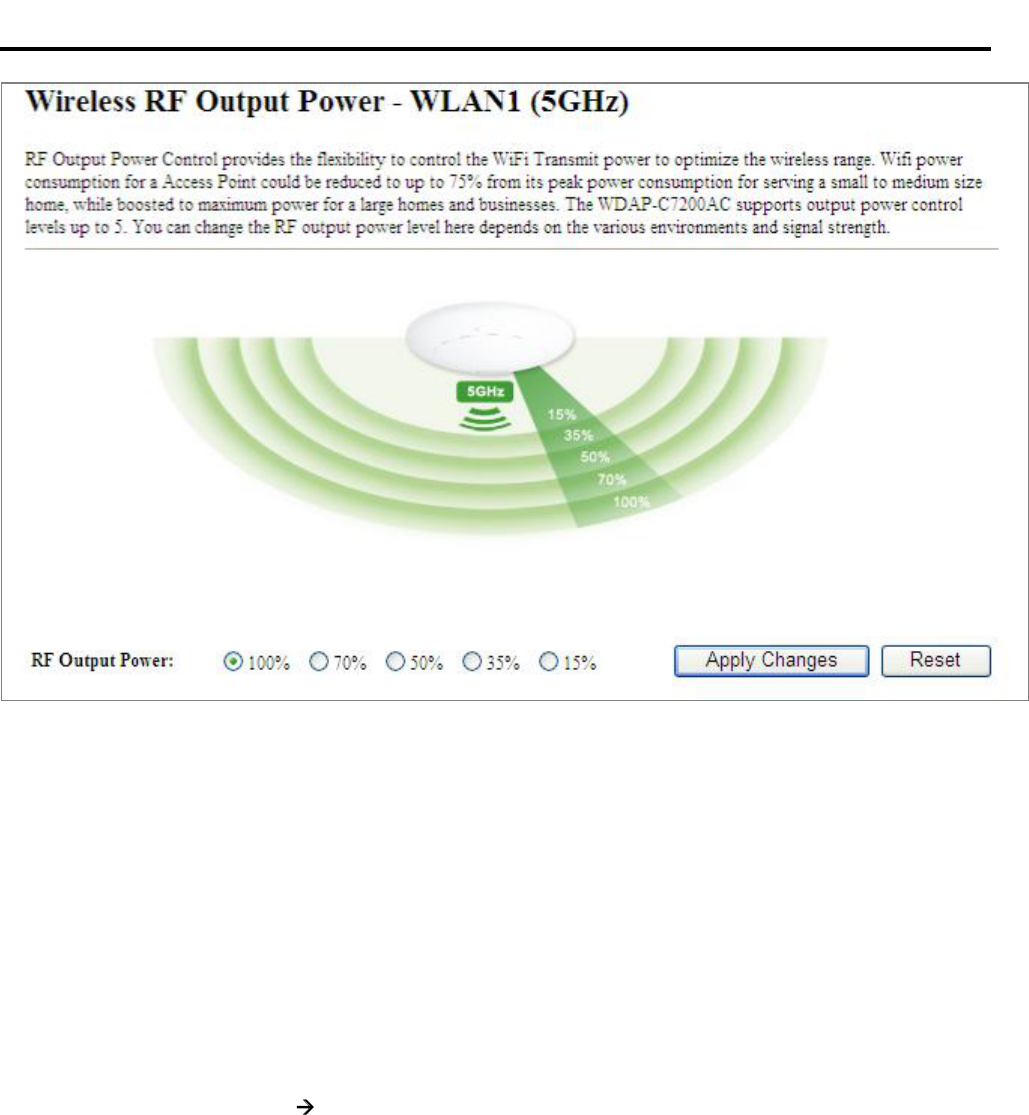
User Manual of WDAP-C7200AC
-48-
Figure 5-34 RF Output Power 5GHz
RF Output Power Control provides the flexibility to control the Wi-Fi transmit power to optimize the wireless
range. Wi-Fi power consumption for an Access Point could be reduced to up to 75% from its peak power
consumption for serving small to medium size homes, while boosted to maximum power for large homes and
businesses. The WDAP-C7200AC supports output power control levels up to 5. You can change the RF output
power level here in accordance with various environments and signal strength.
5.3.4 Security
Choose menu WLAN1 (5GHz) Security and you can configure the settings of wireless security for the
wireless network on this page. After the configuration, please click the Apply Changes button to save the
settings.
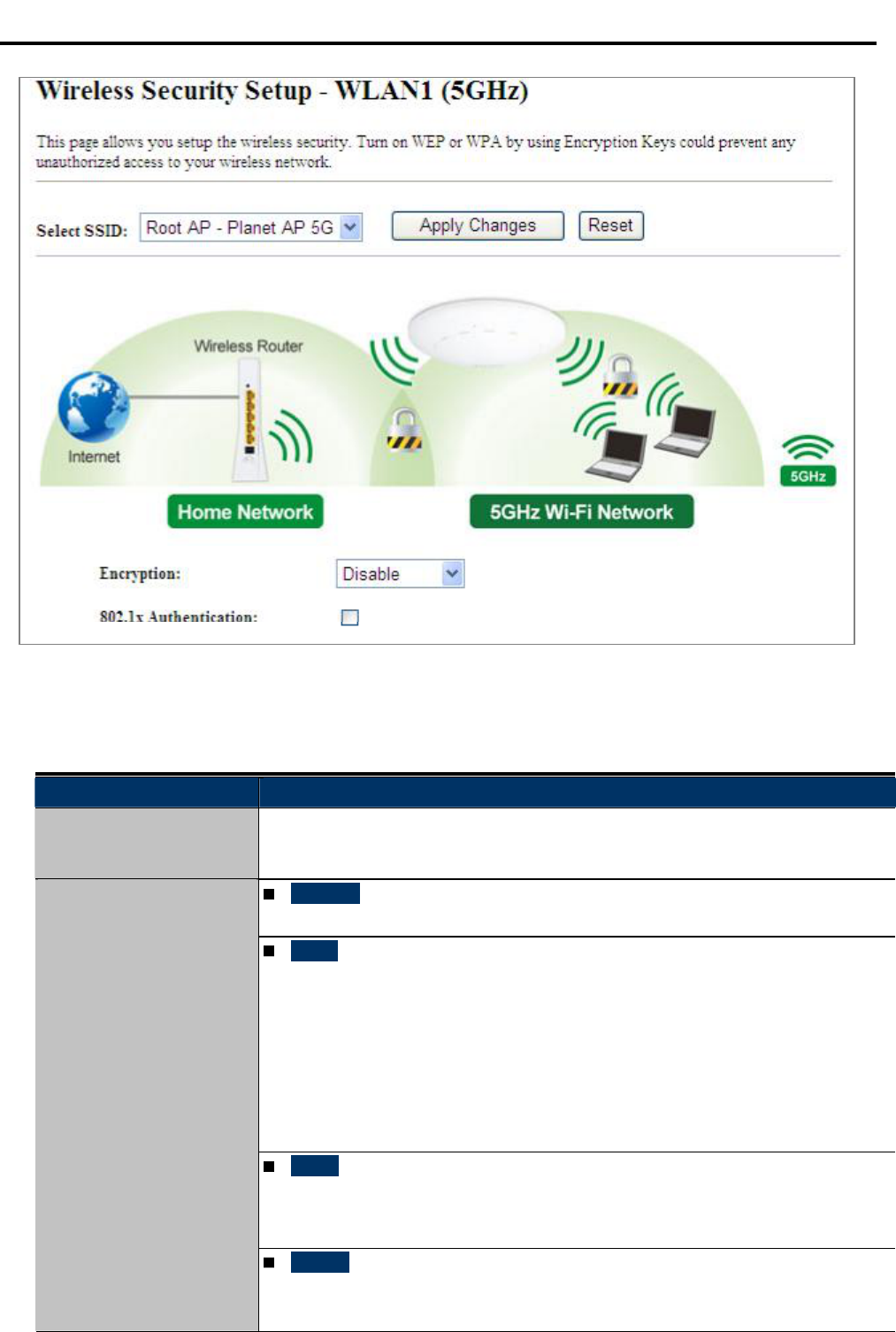
User Manual of WDAP-C7200AC
-49-
Figure 5-35 Wireless Security Settings 5GHz
The page includes the following fields:
Object Description
Select SSID Select the SSID you want to configure the wireless security function, which
includes the root one and the client one.
Disable:
No security setup for wireless connection.
WEP:
It is based on the IEEE 802.11 standard. And the default setting of
authentication is Automatic, which can select Open System or Shared Key
authentication type automatically based on the wireless station's capability
and request. Furthermore, you can select Key Length and enter 10 and 26
Hexadecimal digits (any combination of 0-9, a-f, A-F, zero key is not
promoted) or 5 and 13 ASCII characters in the Encryption Key field.
WPA:
WPA is a medium level encryption and is supported by most wireless devices
and operating systems.
Encryption
WPA2:
WPA2 is a high level encryption and is supported by most wireless devices
and operating systems.
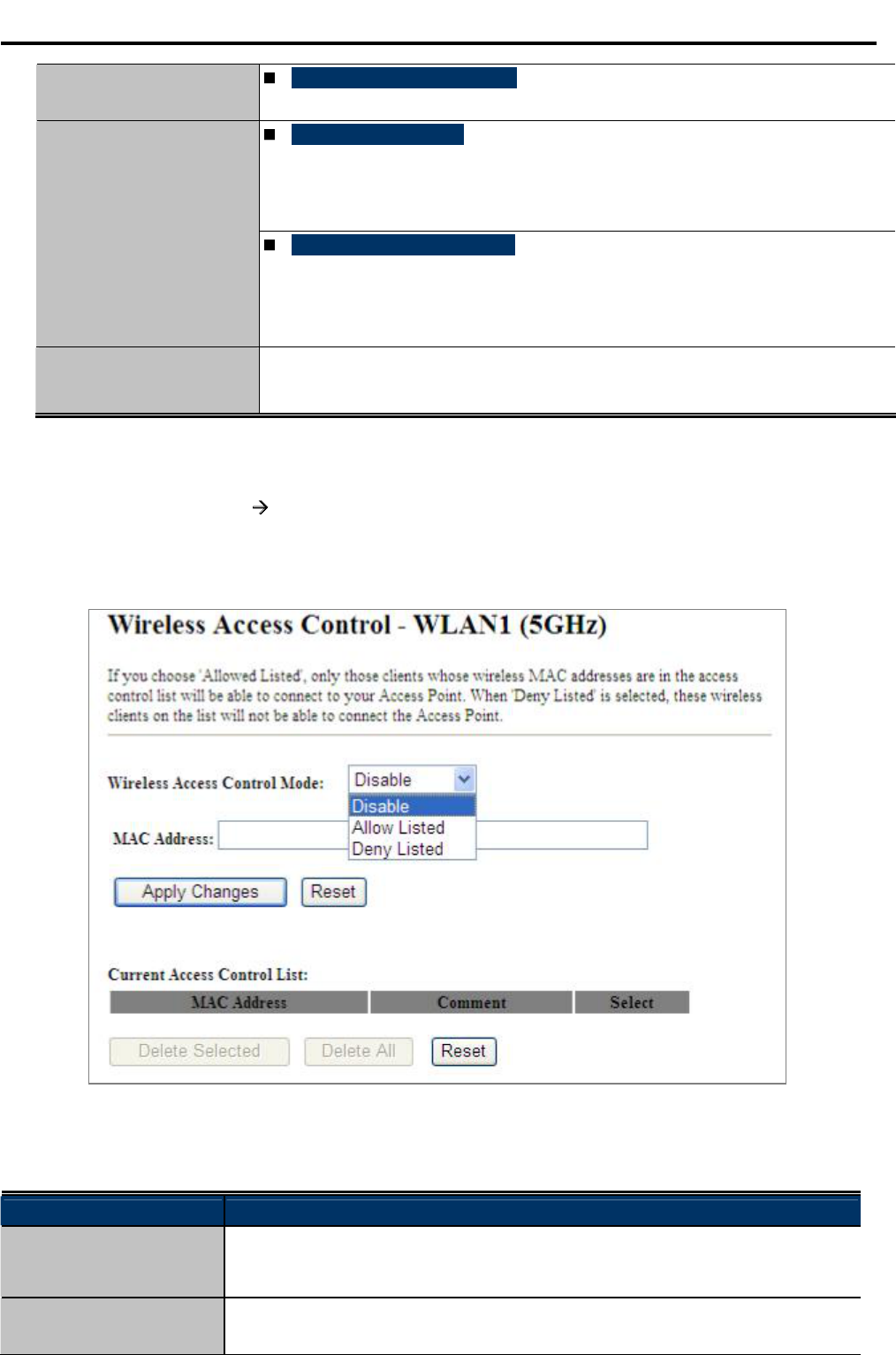
User Manual of WDAP-C7200AC
-50-
WPA / WPA2 / WPA-Mixed:
WPA Mixed Mode allows the use of both WPA and WPA2 at the same time.
Enterprise (RADIUS)
When you select the authentication mode based on Enterprise (Radius
Server), please enter the IP Address,Port, and Password of the Radius
Server.
Authentication Mode
Personal (Pre-Shared Key)
When you select the other authentication mode based on Personal
(Pre-Shared Key), please enter at least 8 ASCII characters (Passphrase) or
64 Hexadecimal characters. All of the Cipher Suites support TKIP and AES.
802.1x Authentication Enable 802.1x authentication function and then please enter the IP Address,
Port, and Password of the Radius Server.
5.3.5 Access Control
Choose menu WLAN1 (5GHz) Access Control to allow or deny the computer of specified MAC address to
connect with the WDAP-C7200AC on this page. After the configuration, please click the Apply Changes button
to save the settings.
Figure 5-36 Wireless Access Control 5GHz
The page includes the following fields:
Object Description
Wireless Access
Control Mode
You can choose to set the Allowed-List, Denied-List, or disable this function.
MAC Address Enter the MAC address you want to allow or deny connection to the
WDAP-C7200AC in the field.
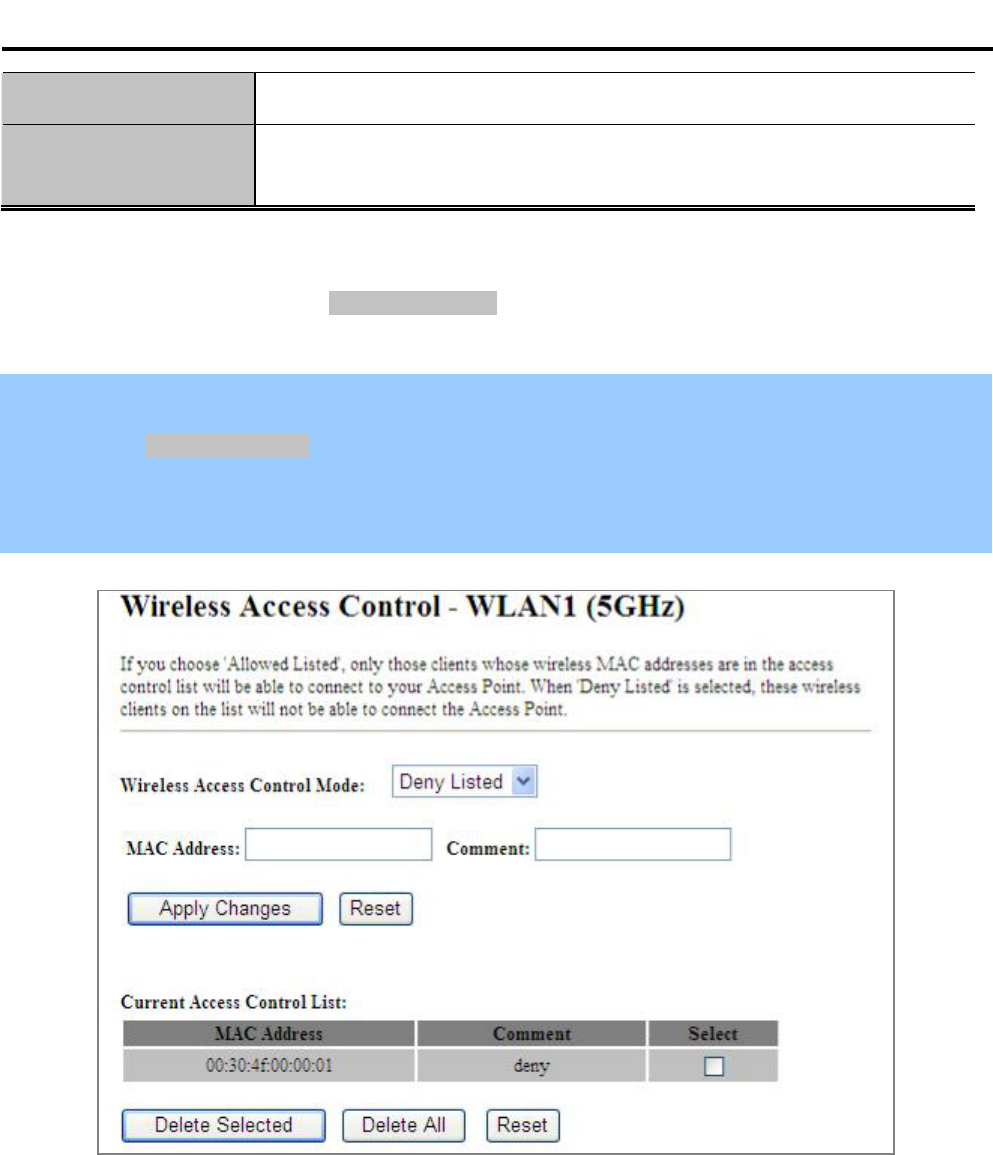
User Manual of WDAP-C7200AC
-51-
Comment You can make some comment on each MAC address on the list.
Current Access Control
List
You can select some MAC addresses and click the Delete Selected button to
delete it.
To deny a PC at the MAC address of 00:30:4F:00:00:01 (for example) to connect to your wireless network, do as
follows:
Step 1. Select Deny from MAC Address Filter drop-down menu.
Step 2. Enter 00:30:4F:00:00:01 in the MAC address box and click Add.
Step 3. Click the OK button to save your settings and you can add more MAC addresses, if you like, simply
repeat the above steps.
Figure 5-37 Wireless Access Control Deny
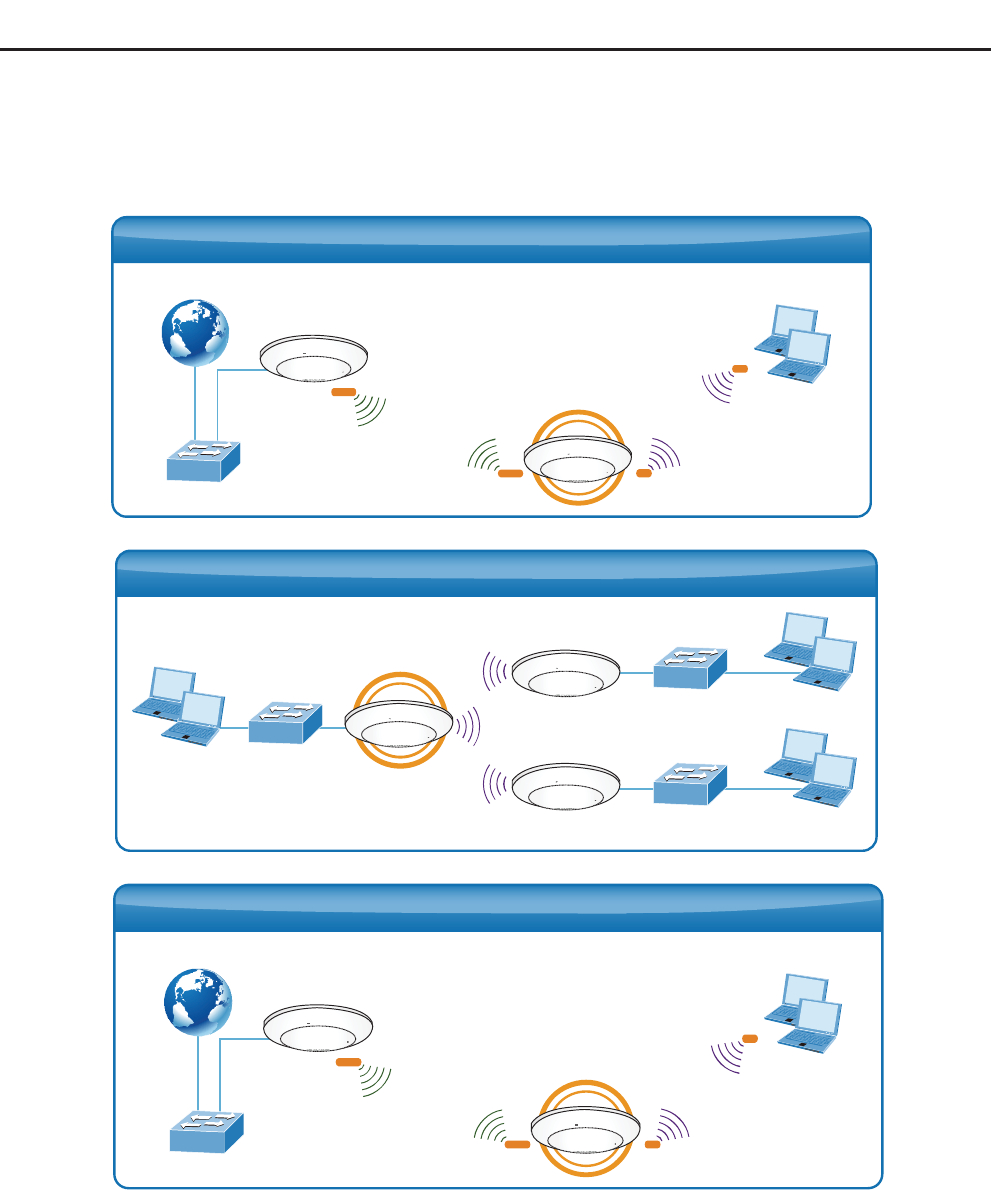
User Manual of WDAP-C7200AC
-52-
5.3.6 WDS
WDS (Wireless Distribution System) feature can be used to extend your existing 2.4G or 5G wireless network
coverage. Here we present you how to configure such feature in 2.4GHz, which also applies to 5GHz.
Before configuring the WDS Setting page, you have to select the wireless mode to “WDS” on the WLAN1 (5GHz)
-> Basic Settings web page.
Switch
WDS Repeater Mode
Clients
5G WDS 2.4G
AP
Internet
WDAP-C7200AC
g/n
g/n
a/n/ac
a/n/ac
AP ClientsSwitch
ClientsSwitch
Clients Switch
WDAP-C7200AC
AP
WDS Bridge-PtMP Mode
Switch
WDS Repeater Mode
Clients
5G WDS 2.4G
AP
Internet
WDAP-C7200AC
g/n
g/n
a/n/ac
a/n/ac
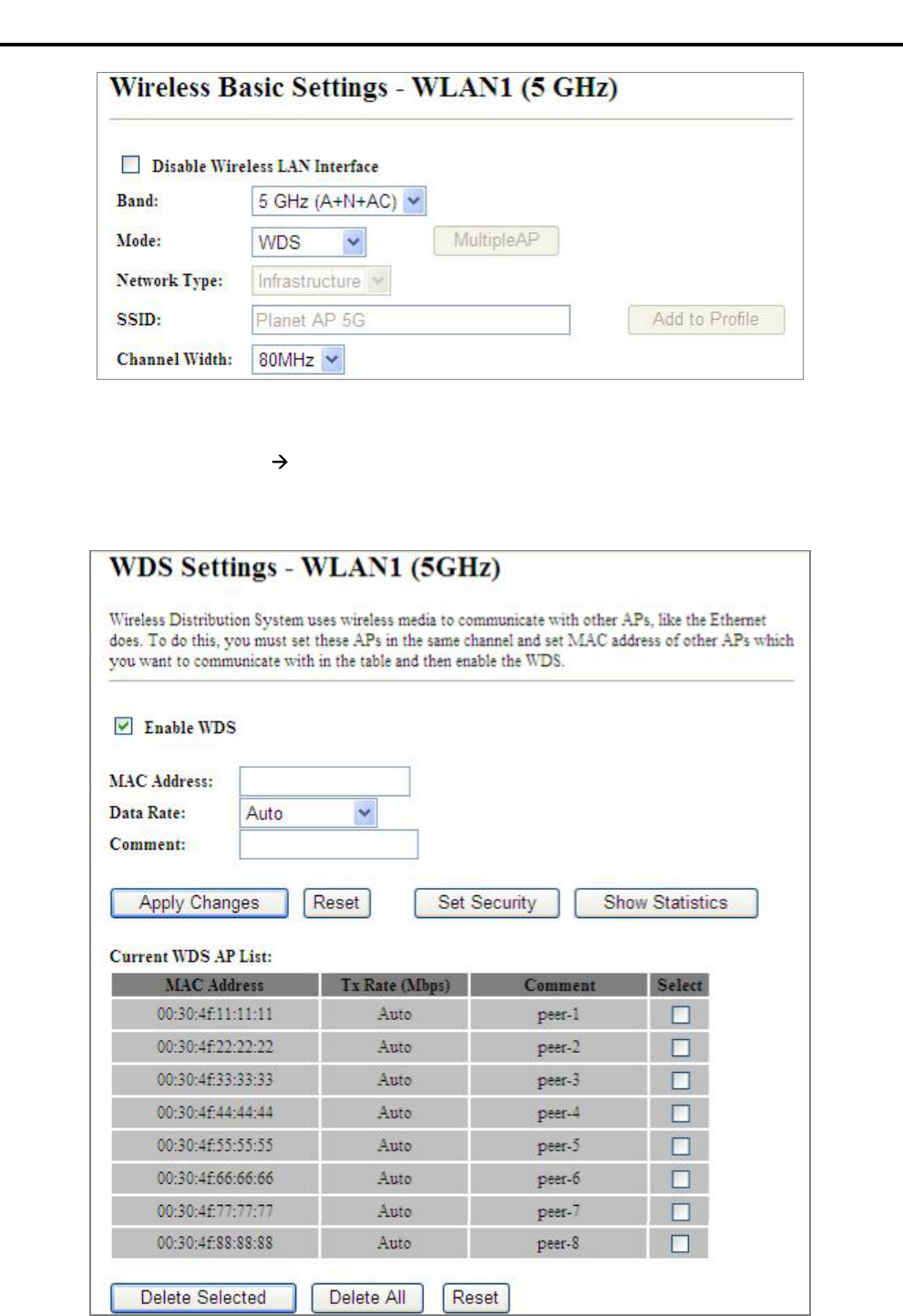
User Manual of WDAP-C7200AC
-53-
Figure 5-38 WDS Mode 5GHz
Choose menu WLAN1 (5GHz) WDS Settings to configure WDS to connect the WDAP-C7200AC with
another AP on this page. After the configuration, please click the Apply Changes button to save the settings.
Figure 5-39 WDS Settings 5GHz
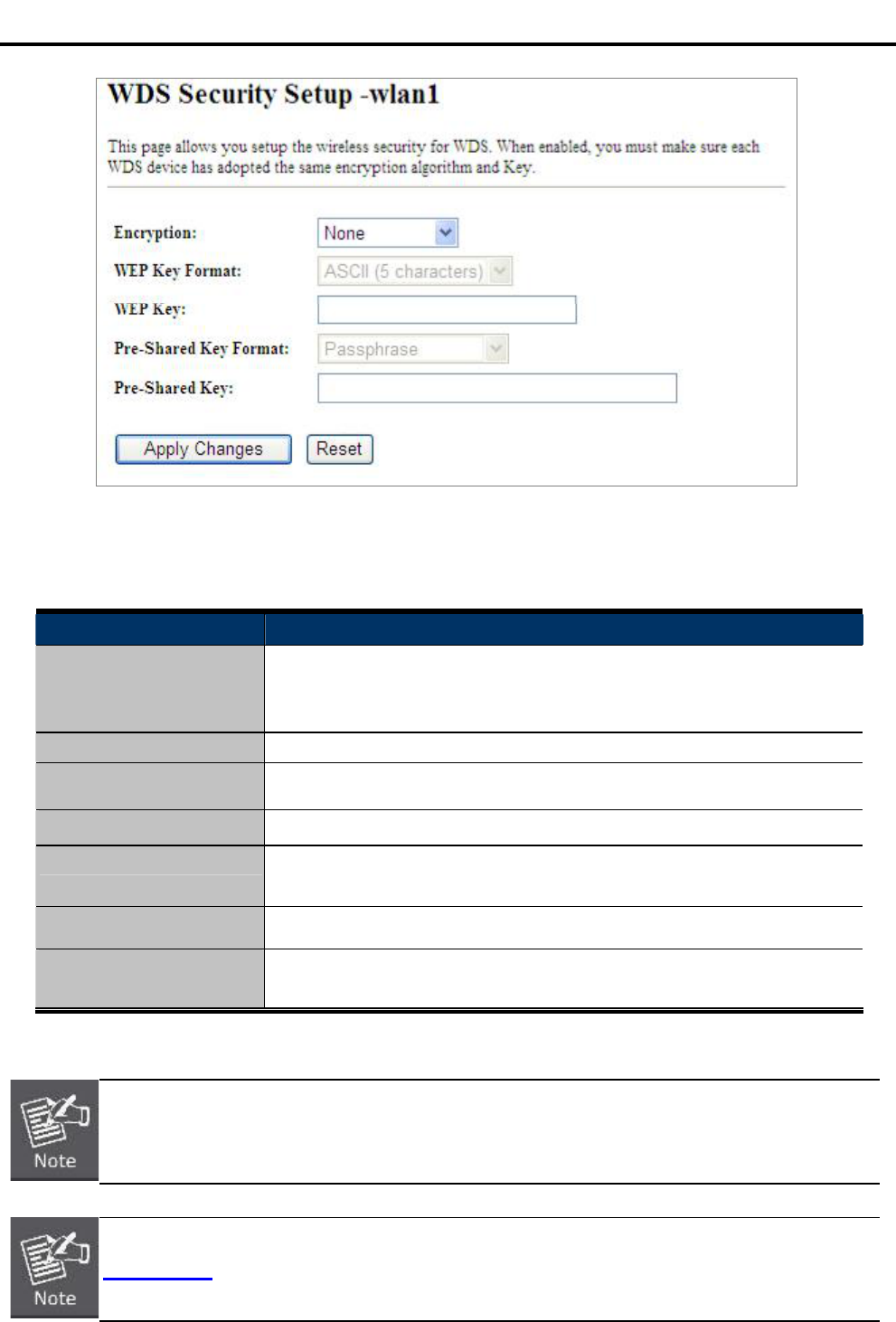
User Manual of WDAP-C7200AC
-54-
Figure 5-40 WDS Set Security
The page includes the following fields:
Object Description
Enable WDS Check the box to enable the WDS function. Please select WDS or
AP+WDS in the Mode of Wireless Basic Settings before you enable
WDS on this page.
MAC Address You can enter the MAC address of the AP you want to connect with.
Data Rate Default is Auto.
Comment You can make some comment for each MAC address on the list.
Set Security Click the Set Security button to configure the wireless security
parameters of the AP you want to connect via WDS.
Show Statics Click the Show Statics button to show the WDS AP.
Current WDS AP List You can select some MAC addresses of the AP and click the Delete
Selected button to delete it.
WDS feature can only be implemented between 2 wireless devices that both support the WDS
feature. Plus, channel,security settings and security key must be the same on both such
devices.
To encrypt your wireless network, click Set Security. For the detail of wireless security, see
section 5.3.3. Do remember to reboot the device after you save your wireless security settings;
otherwise, the WDS feature may not function.
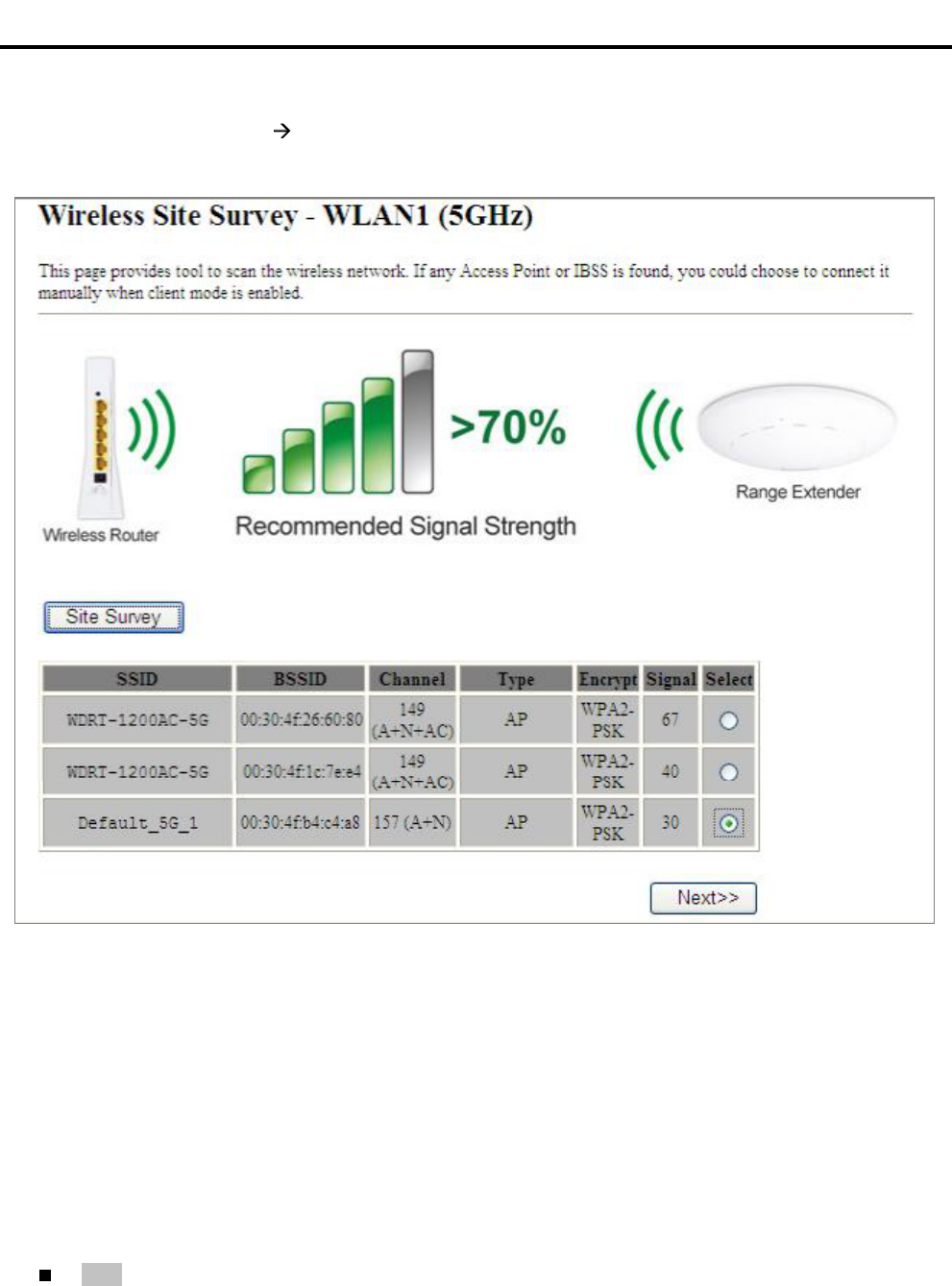
User Manual of WDAP-C7200AC
-55-
5.3.7 Site Survey
Choose menu WLAN1 (5GHz) Site Survey to scan the available local AP. If any Access Point is found, you
could choose any one to connect with manually when the Client Mode is enabled.
Figure 5-41 Site Survey 5GHz
5.3.8 WPS
WPS (Wi-Fi Protected Setup) is designed to ease setup of security Wi-Fi networks and subsequently network
management. This Wireless Router supports WPS features for AP mode,AP+WDS mode,
Infrastructure-Client mode, and the wireless root interface of Universal Repeater mode.
Simply enter a PIN code or press the software PBC button or hardware WPS button (if any) and a secure
wireless connection is established.
PBC: If you find the WPS LED blinking for 2 minutes after you press the hardware WPS button on the
device, it means that PBC encryption method is successfully enabled. And an authentication will
be performed between your router and the WPS/PBC-enabled wireless client device during this
time; if it succeeds, the wireless client device connects to your device, and the WPS LED turns
off. Repeat steps mentioned above if you want to connect more wireless client devices to the
device.
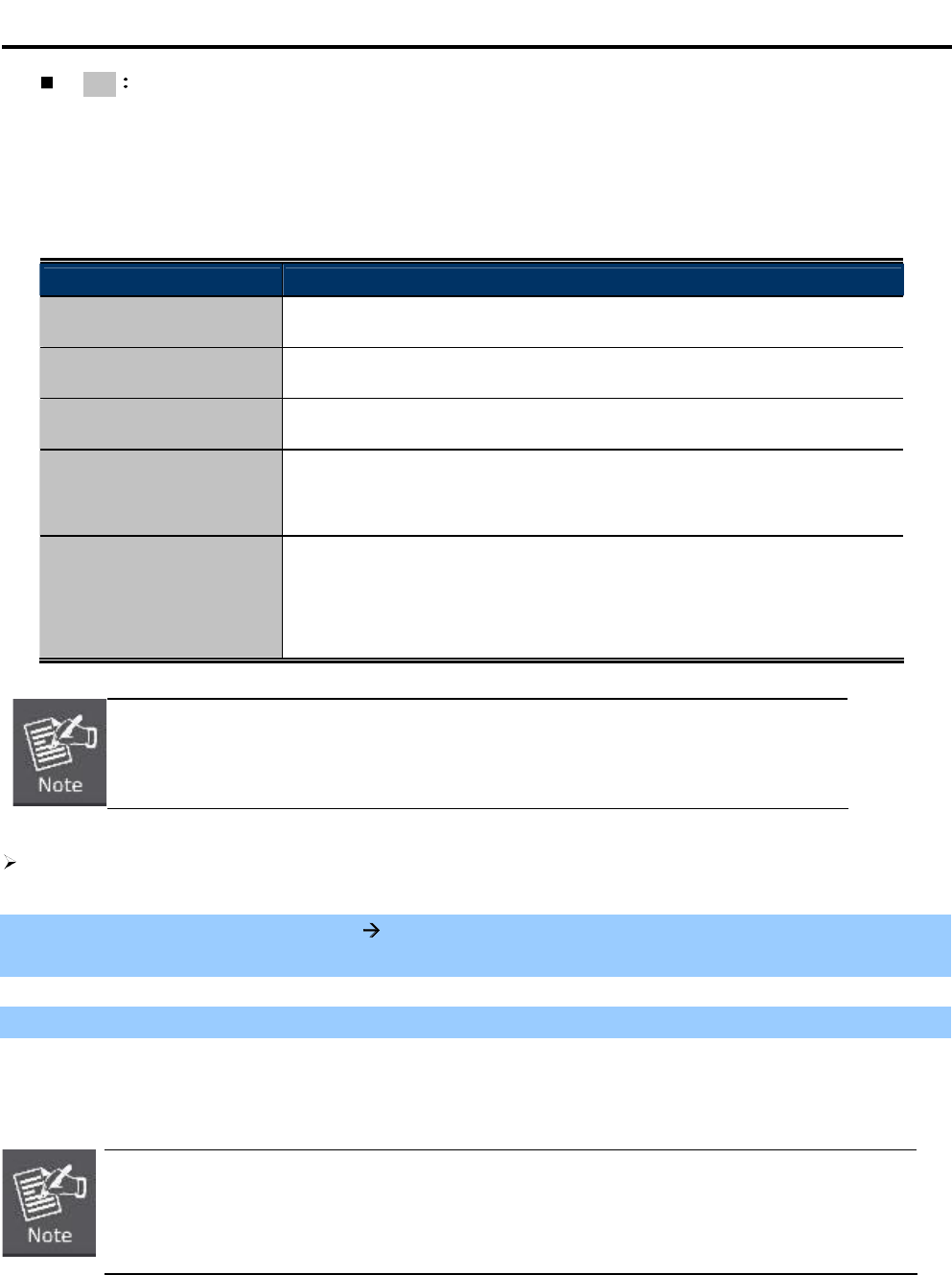
User Manual of WDAP-C7200AC
-56-
PIN To use this option, you must know the PIN code from the wireless client and enter it in
corresponding field on your device while using the same PIN code on client side for such
connection.
The page includes the following fields:
Object Description
Disable WPS You can check the box to disable the WPS function.
WPS Status Here you can check if the connection via WPS is established or not.
Self-PIN Number It is the PIN number of the WDAP-C7200AC here.
Push Button
Configuration
Click the Start PBC to activate WPS as well in the client device within
2 minutes.
Client PIN Number In addition to the PBC method, you can also use the PIN method to
activate the WPS. Just enter the PIN number of the client device in the
field and click the Start PIN button.
The WPS encryption can be implemented only between your Router and another
WPS-capable device.
Example of how to establish wireless connection using WPS. Please take the following steps:
Step 1. Choose menu WLAN1 (5GHz) WPS to configure the setting for WPS. After the configuration,
please click the Apply Changes button to save the settings.
Step 2. Add a new device.
If the wireless adapter supports Wi-Fi Protected Setup (WPS), you can establish a wireless connection between
wireless adapter and AP using either Push Button Configuration (PBC) method or PIN method.
To build a successful connection by WPS, you should also do the corresponding configuration
of the new device for WPS function.
A. By Push Button Configuration (PBC)
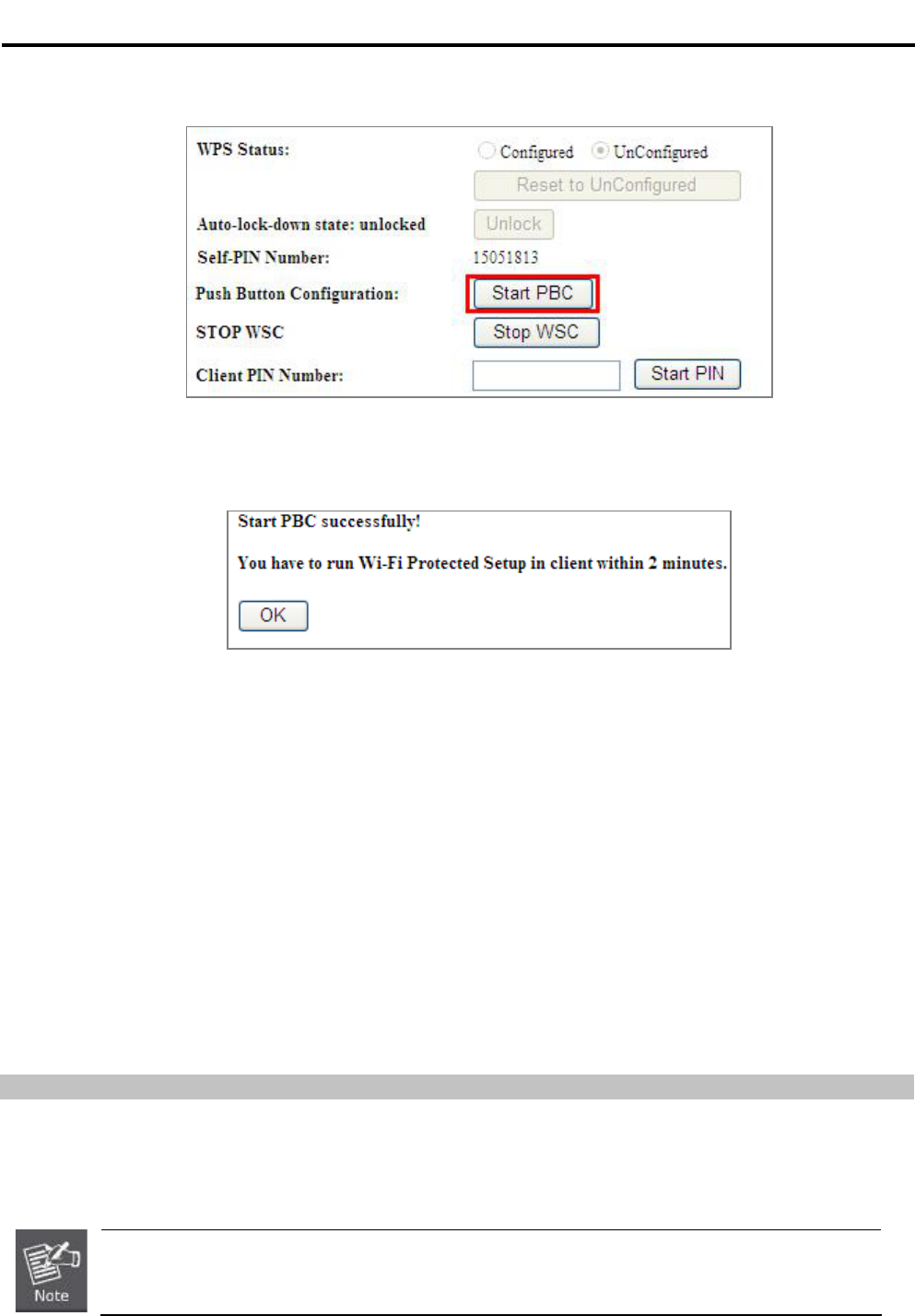
User Manual of WDAP-C7200AC
-57-
i. Click the Start PBC Button on the WPS page of the AP.
Figure 5-42 WPS-PBC 5GHz-1
Figure 5-43 WPS-PBC 5GHz-2
ii. Press and hold the WPS Button equipped on the adapter directly for 2 or 3 seconds. Or you can click
the WPS button with the same function in the configuration utility of the adapter. The process must be
finished within 2 minutes.
iii. Wait for a while until the next screen appears. Click OK to complete the WPS configuration.
B. By PIN
If the new device supports Wi-Fi Protected Setup and the PIN method, you can add it to the network by PIN with
the following two methods.
Method One: Enter the PIN of your Wireless adapter into the configuration utility of the AP
i. Enter the PIN code of the wireless adapter in the field behind Client PIN Number in the following
figure. Then click Start PIN.
The PIN code of the adapter is always displayed on the WPS configuration screen.
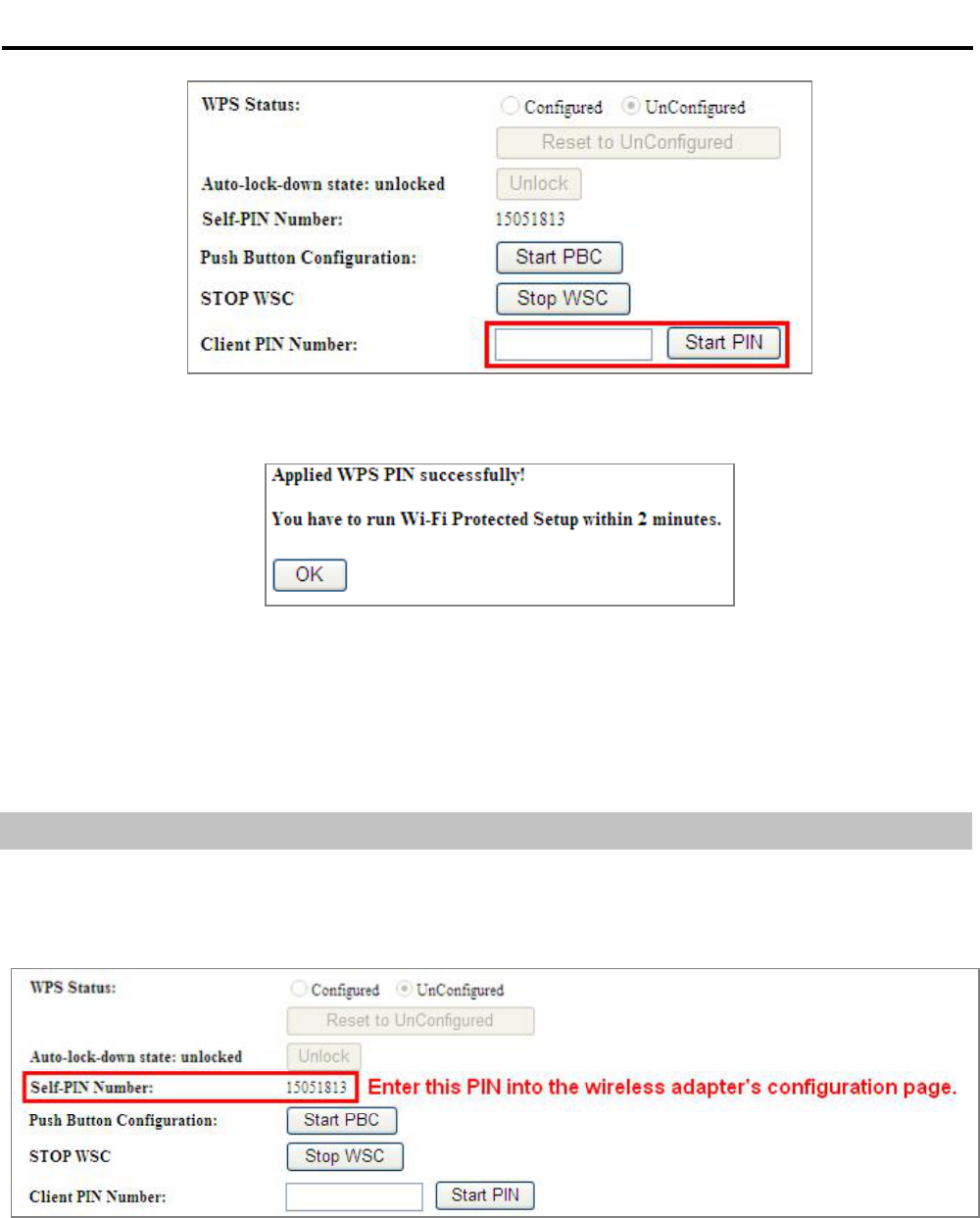
User Manual of WDAP-C7200AC
-58-
Figure 5-44 WPS-PIN 5GHz-1
Figure 5-45 WPS-PIN 5GHz-2
ii. For the configuration of the wireless adapter, please choose the option that you want to enter PIN
into the AP (Enrollee) in the configuration utility of the WPS and click Next until the process finishes.
Method Two: Enter the PIN of the AP into the configuration utility of your Wireless adapter
i. Click the Start PBC Button on the WPS page of the AP. Get the Current PIN code of the AP in WPS
page (each AP has its unique PIN code).
Figure 5-46 WPS-PIN 5GHz-3
ii. For the configuration of the wireless adapter, please choose the option that you want to enter the PIN
of the AP (Registrar) in the configuration utility of the Wireless adapter and enter it into the field.
Then click Next until the process finishes.
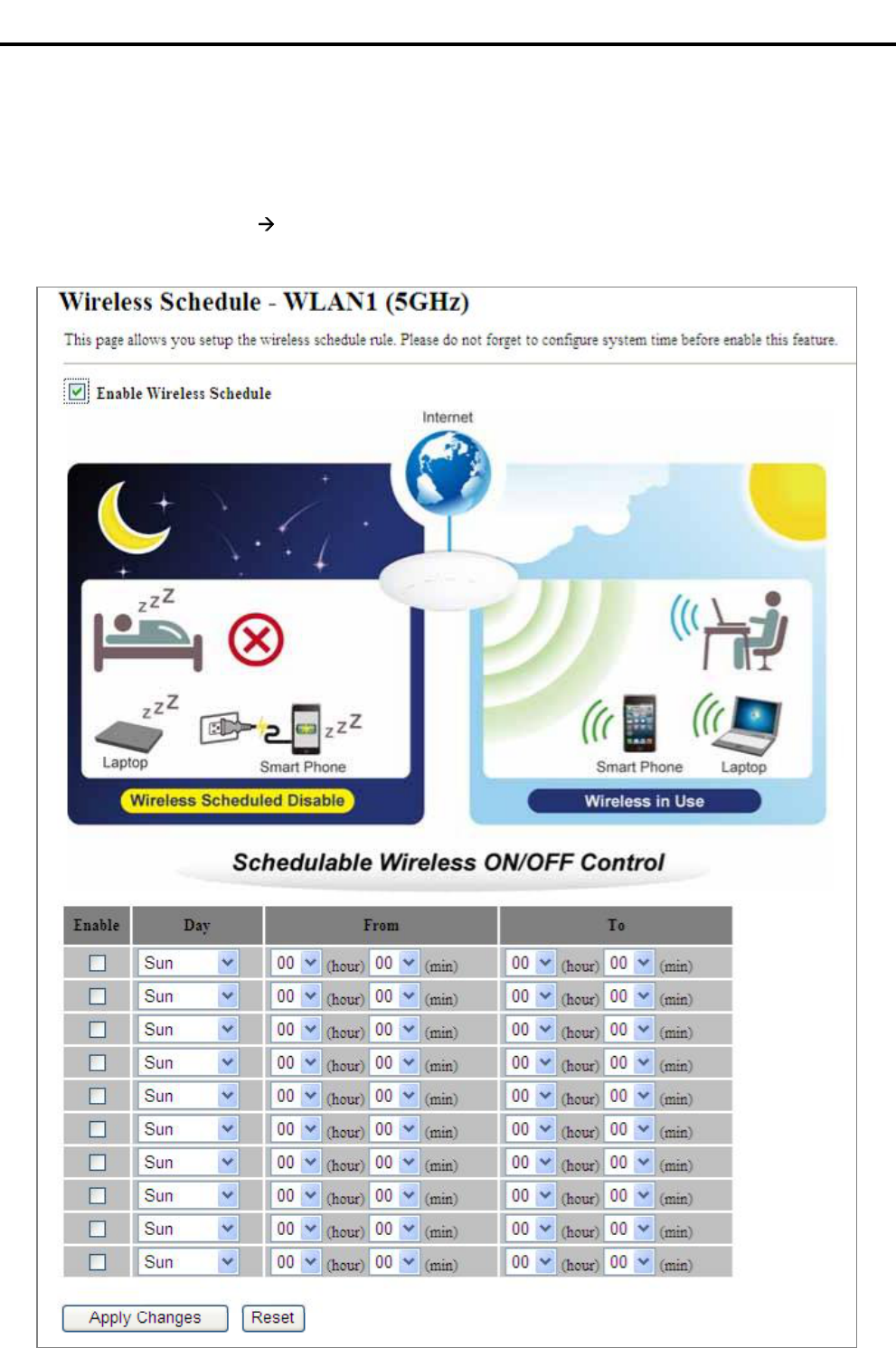
User Manual of WDAP-C7200AC
-59-
5.3.9 Schedule
Wireless Schedules will enable or disable your wireless access at a set time based on your predefined schedule.
This feature is often used for restricting access to all users (such as children, employees and guests) during
specific times of the day for parental control or security reasons.
Choose menu WLAN1 (5GHz) Schedule to configure the schedule rule of enabling wireless function. After
the configuration, please click the Apply Changes button to save the settings.
Figure 5-47 Schedule - 5GHz
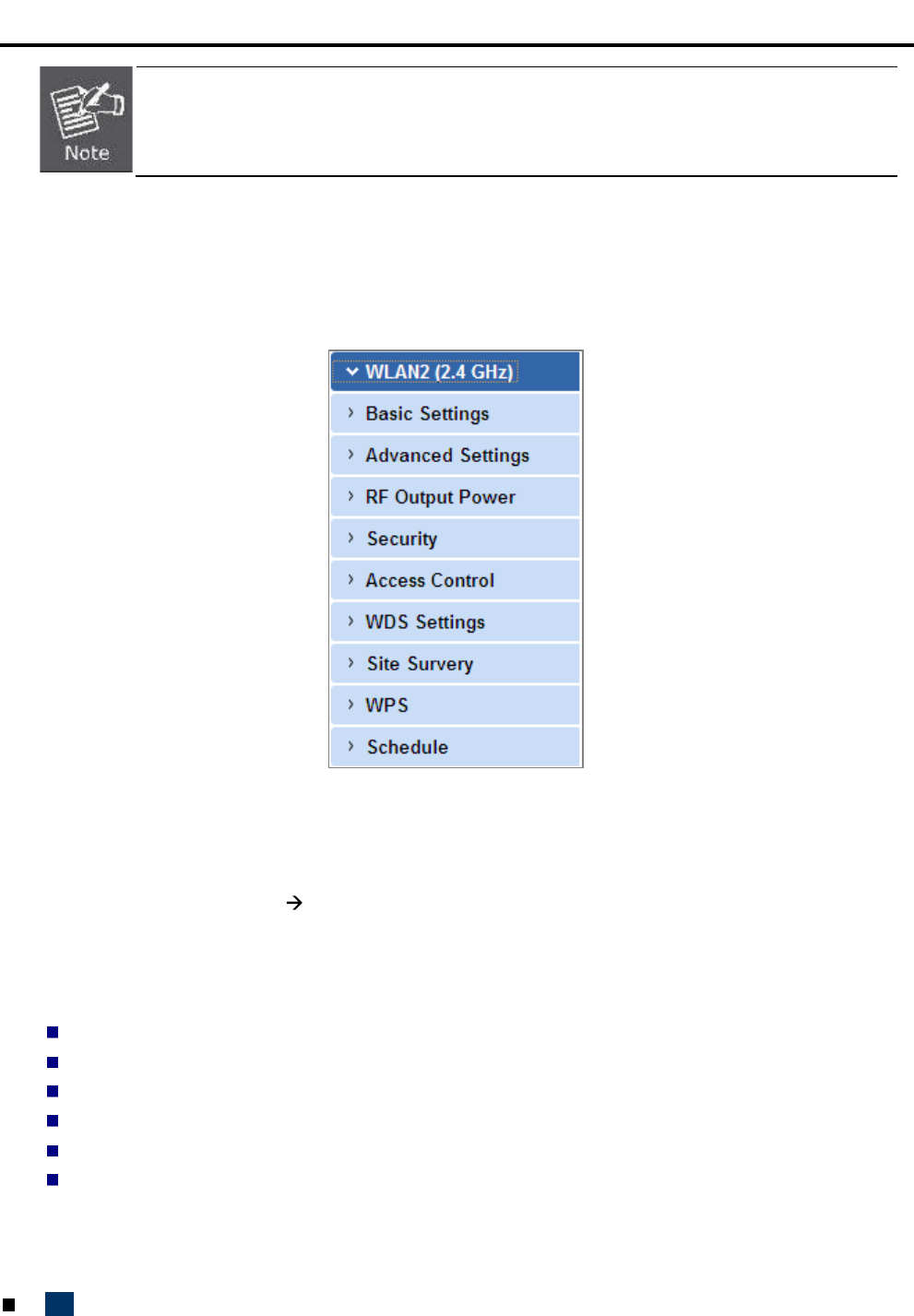
User Manual of WDAP-C7200AC
-60-
When setting the Wireless Schedule, it is important to ensure that your System Clock
settings have been configured. If not, your Wireless Schedule will not function correctly.
5.4 WLAN2 (2.4GHz)
The Wireless menu contains submenus of the settings about wireless network. Please refer to the following
sections for the details.
Figure 5-48 2.4GHz Wireless Main Menu
5.4.1 Basic Settings
Choose menu WLAN2 (2.4GHz) Basic Settings to configure the 2.4GHz basic settings for the wireless
network on this page. After the configuration is done, please click the Apply Changes button to save the
settings.
First of all, the wireless AP supports multiple wireless modes for different network applications, which include:
AP
Multiple SSIDs
Universal Repeater
Client
WDS
AP+WDS
It is so easy to combine the WDAP-C7200AC with the existing wired network. The WDAP-C7200AC definitely
provides a total network solution for the home and the SOHO users.
AP
Standard Access Point
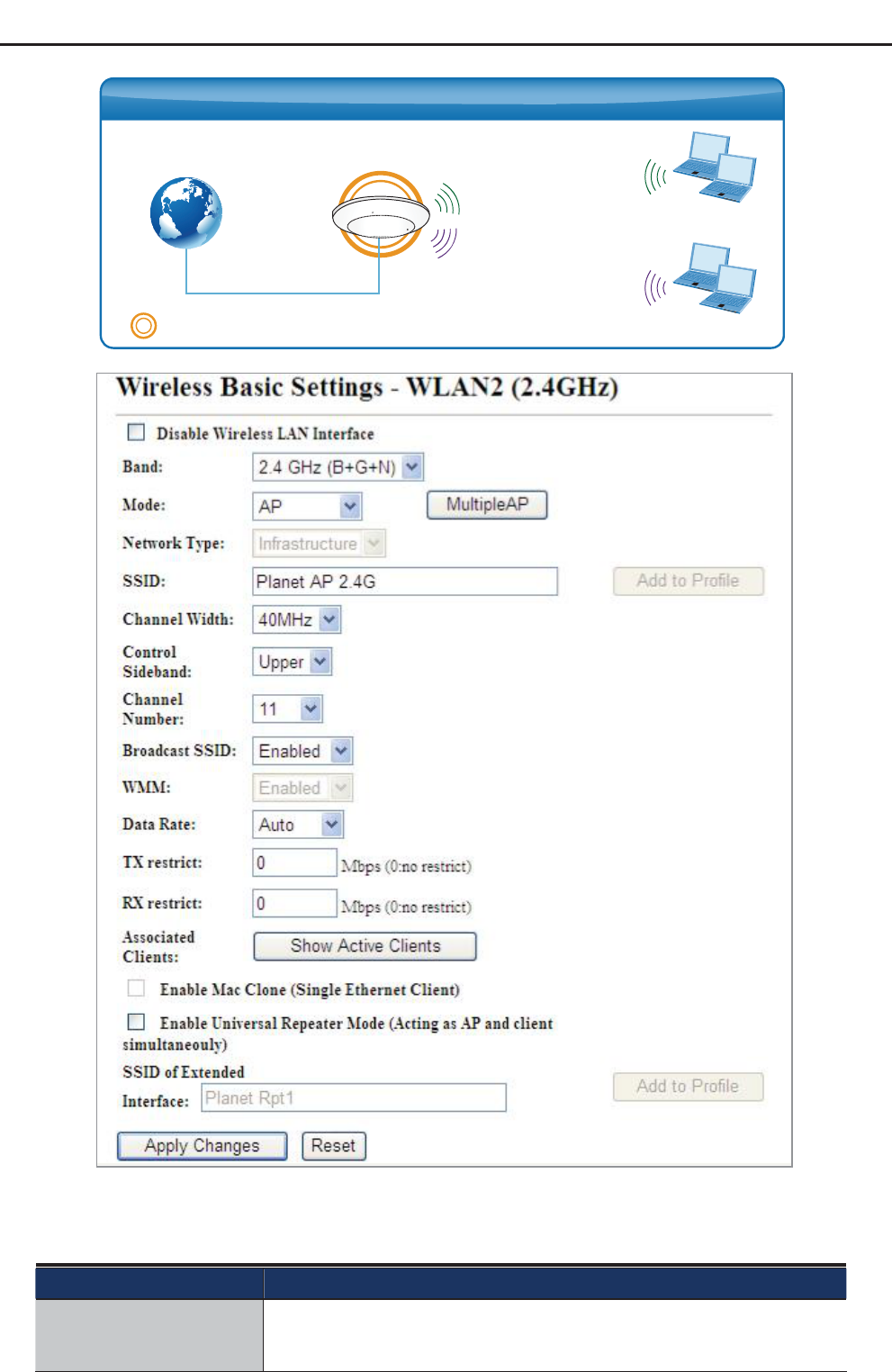
User Manual of WDAP-C7200AC
-61-
Figure 5-49 2.4GHz Wireless Basic Settings – AP
The page includes the following fields:
Object Description
Disable Wireless LAN
Interface
Check the box to disable the wireless function.
AP(Multi-SSID) Mode
Clients
Clients
SSID-1(5G)
SSID-2(2.4G)
Internet WDAP-C7200AC
AP Mode